Physical Address
304 North Cardinal St.
Dorchester Center, MA 02124
Developmental disorders of the brain and spinal cord can be classified into location-based/regional categories, including abnormalities of the cortex, white matter, brainstem, and cerebellum, or according to the presumed etiologic mechanism. Etiologically, developmental anomalies can be classified into malformations, disruptions, and deformations. Malformation implies a morphologic defect resulting from an “intrinsically abnormal” developmental process. Disruptions can be understood as secondary malformations, resulting from the effect of an extrinsic factor that interferes with an originally normal developmental process. Deformations can be understood as special types of disruptions, which are secondary to mechanical forces that lead to the abnormal form, shape, or position of a part of the body. In reality, the effect of intrinsic and extrinsic factors is difficult to disentangle from each other. This categorization, therefore, is conceptually useful but of limited practical value.
Genetic factors (monogenic, polygenic, structural/chromosomal defects) and environmental factors (including diet/malnourishment and teratogens) can all alter central nervous system (CNS) development, often acting synergistically. In general, the earlier the insult, the more severe its effect; however, many teratogens exert their influence during especially vulnerable time periods (referred to as critical periods), when specific tissues are undergoing development. Important examples of teratogens acting during critical periods include the teratogenic effect of alcohol and the protective effect of folic acid during early embryonic life.
Many, if not most, CNS developmental anomalies are seen as part of a syndrome: a cluster of abnormalities affecting multiple organs. Careful clinical, radiologic, and gross examinations are hence instrumental in diagnosis of developmental disorders. Diagnosis, whether on pathologic, clinical, or radiologic grounds, should be defined as narrowly as possible. All attempts should be made to identify the possible causative agent(s). Although in many cases the treatment modality/management is not altered by a specific diagnosis or identification of a cause, it is often important for family counseling as this approach reduces diagnostic uncertainties and provides some degree of certainty regarding prognosis.
Advancements in neuroradiology and molecular genetic testing in the past two decades have tremendously impacted the practice of developmental neuropathology. Many of the CNS malformations are now confidently diagnosed on noninvasive imaging. In particular, ultrasound examinations in the second trimester can identify a large proportion of CNS malformations. The past decade has also seen tremendous growth in the field of neurodevelopment largely due to the wide availability of next-generation sequencing (NGS) techniques. Owing to decreased cost and increased speed of sequencing, NGS has now become a routine part of the diagnostic workup in many institutions. Large candidate gene panels and whole exome sequencing are now routinely conducted as aids to clinical diagnosis. These studies have also helped to discover the genetic underpinnings of many conditions previously considered idiopathic.
The need for neuropathologic expertise has, however, not diminished. Pathologists are still routinely called on to corroborate/confirm radiologic findings in terminated pregnancies and in surgically excised specimens, especially in radiologically atypical cases. Similarly, there is a need for morphology-molecular correlation. Other morphologic abnormalities may be clinically unsuspected or lie outside the detection abilities of radiologic or genetic findings, hence the necessity of careful and thorough gross and microscopic examination in all cases.
This chapter discusses brain malformations in groups according to their known etiology/pathogenesis or, when unknown or only partially elucidated, according to shared morphologic or clinical features. Acquired perinatal diseases are also considered, as is hippocampal sclerosis (a lesion with probable origin in childhood) and familial tumor predisposition syndromes, characterized by developmental anomalies and tumor diatheses involving the CNS. As with other rapidly evolving fields, our understanding of the pathogenesis of different CNS malformations is in constant flux and subject to change as new data are gathered. As such, understanding basic pathogenic mechanisms and the approach to diagnosis are more important than learning specific facts and are the main emphasis of this chapter.
Developmental malformations of the nervous system are complex and heterogeneous and are a major contributor to intellectual disability and abnormal neurologic and psychiatric conditions.
In this section, we discuss common neurodevelopmental abnormalities, divided etiologically into the following categories:
Malformations secondary to abnormal neuronal and glial precursor cell proliferation, abundance, or function. Examples of this group include microcephaly and megalencephaly.
Neural tube defects and other defects of neural patterning. Examples of this group include anencephaly, spinal dysraphsim, encephalocele, and holoprosencephaly.
Malformations due to abnormal neuronal migration, with undermigration and overmigration. This group encompasses conditions such as focal cortical dysplasia and glioneuronal heterotopia.
Abnormal postmigrational development including cortical maturation and folding. These include lissencephaly and polymicrogyria.
Disruptions, destructive lesions, and deformations including ischemic insults, hydranencephaly, porencephaly, and multicystic encephalomalacia.
In this section, we discuss microcephaly and megalencephaly, which are malformations secondary to abnormal neuronal and glial precursor cell proliferation and/or abundance.
The adult human brain weighs between 1200 and 1400 g, accounting for approximately 2 % of the total body mass, a considerably larger fraction than in any other primate. An expanded human brain, specifically the neocortex, likely explains many of the more complex cognitive, emotional, and social abilities in humans. Appropriate cortical development is determined by a tightly orchestrated process of neural stem cell proliferation, migration, organization, synaptogenesis, and apoptosis . Perturbation of any of these steps can lead to abnormalities of brain size, clinically manifesting as intellectual disability, autism spectrum disorders, and epilepsy typically manifesting in infancy or early childhood. The degree of neurologic or cognitive impairment generally correlates with the severity of the brain size abnormality.
Microcephaly and macrocephaly (or megalocephaly) are descriptive terms rather than specific diagnoses. Many different conditions have microcephaly or macrocephaly as a feature. The basic concept is explained here with the details left to sections on the specific underlying disorders. Clinically, the occipitofrontal circumference serves as a proxy to identify an alteration of brain size, but head circumference does not correspond with brain size in every case as the former is also influenced by head shape, normal development of which is dependent on a normal sequence of closure of the fontanelles and cranial sutures (details of which are beyond the scope of this chapter).
Microcephaly and microencephaly ( Figs. 4.1 and 4.2 ) are related terms referring to reduced head and brain size, respectively, with the cutoff being 2 standard deviations (SDs) below the mean for age and sex. Consideration must be made for intrauterine growth retardation, low birth weight, and body length. Brain growth drives cranial growth, and a small cranium and small brain occur in conjunction in most cases. We therefore discuss these conditions together under the term microcephaly. As mentioned earlier, for microcephaly and megacephaly, the degree of neurologic and intellectual deficits is directly proportional to the deviation from the mean; those having brain/head size 3 SD or more from the mean show the most severe clinical symptoms, while many with a head or brain size between 2 SD and 3 SD are clinically normal or show only subtle abnormalities.
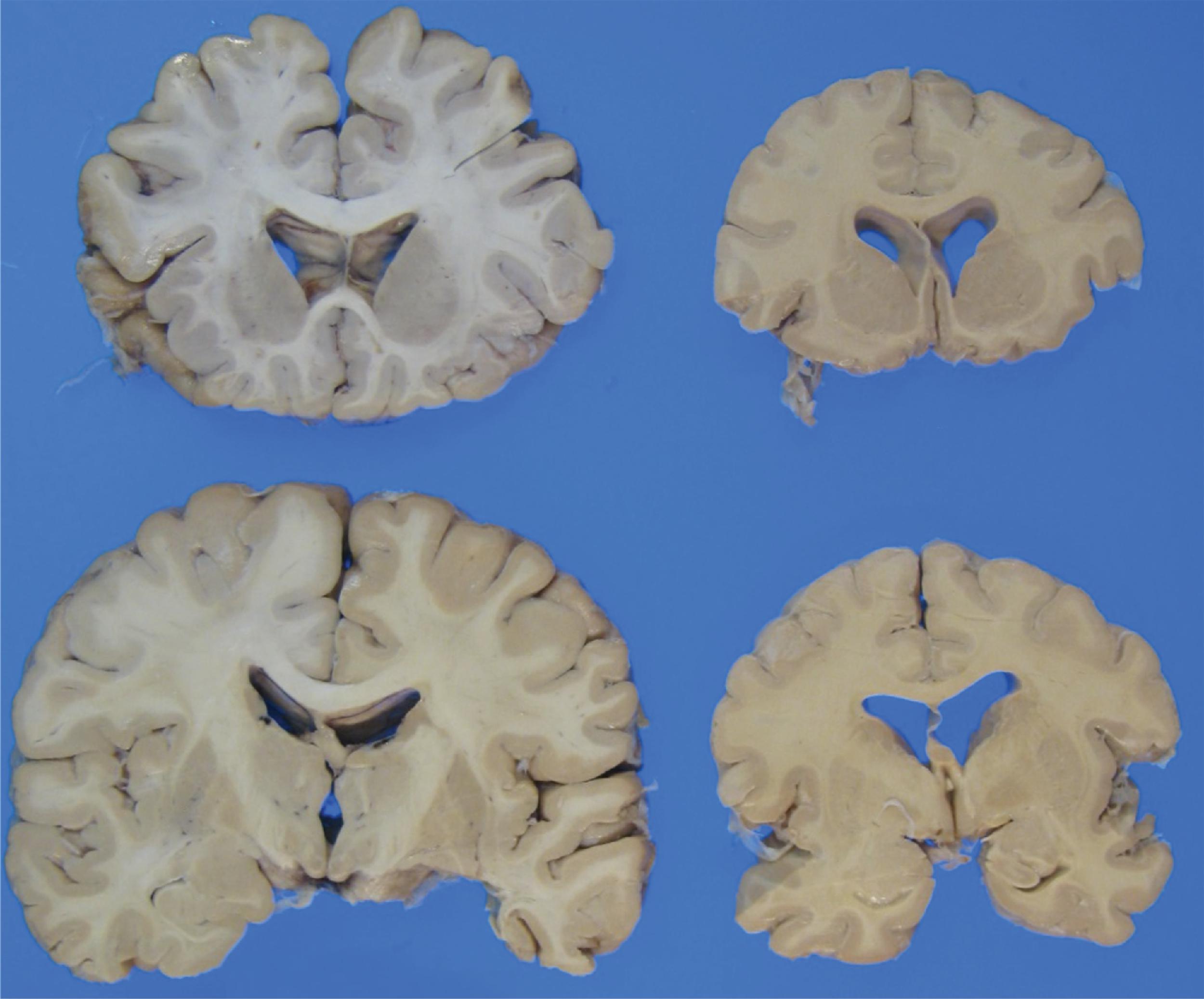
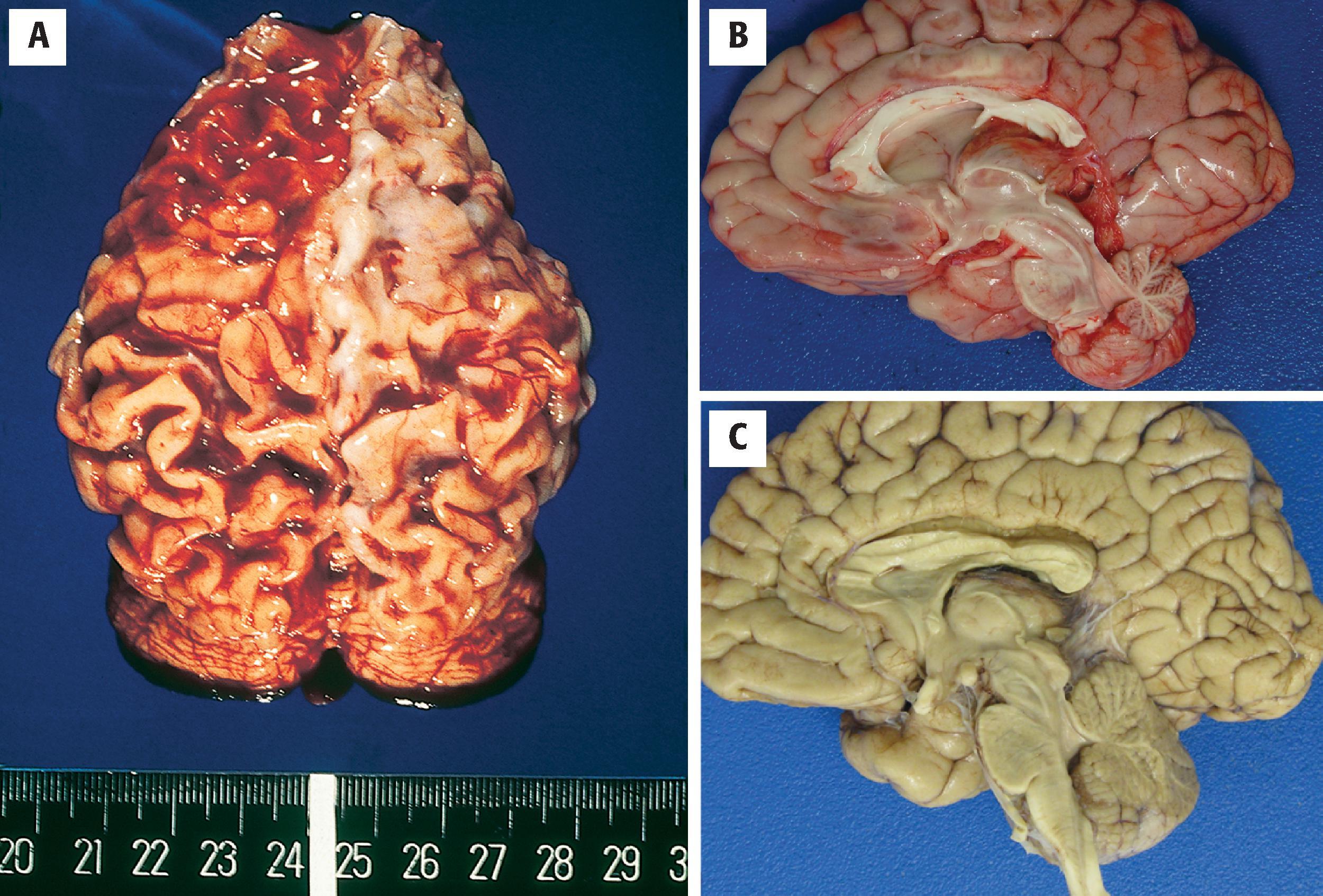
Microcephaly can reflect an insult to the brain during intrauterine life, in which case head circumference is small at birth, or it can develop postnatally, with a normal head circumference at birth followed by failure of normal head growth thereafter. Microcephaly (or micrencephaly) (see Figs. 4.1 and 4.2 ) can be divided into (1) primary micrencephaly, which is thought to stem from decreased neuronal proliferation, or (2) secondary micrencephaly, which connotes a destructive process. Processes interfering with normal neuronal growth and proliferation (and hence causing primary microcephaly) include a variety of chromosomal disorders such as Down syndrome and other trisomies (see the section on trisomies later), malformations, and inherited factors, which may be either autosomal recessive or dominant. Secondary (destructive) microcephaly is frequently a consequence of external disruptive environmental factors such as prenatal exposure to ionizing radiation; intrauterine infections (toxoplasmosis, rubella, cytomegalovirus, and herpesvirus [TORCH]), human immunodeficiency virus, syphilis, and, most recently, ZIKA virus); maternal alcohol abuse; and maternal anticonvulsant therapy. Disruptions of synaptogenesis and myelination defects have also been implicated in secondary microcephaly. Postnatal deceleration in head growth may be a sign of metabolic (e.g., resulting from maternal phenylketonuria), nutritional, or neurodegenerative disorders, although some metabolic diseases may result in enlargement of the brain (see later). The diagnosis of the etiologies of microcephalies is under transformation with the wide availability of chromosomal microarrays (for structural chromosomal defects) and NGS-based targeted gene panels and whole exome sequencing. Metabolic or mitochondrial testing is also helpful in select cases.
Primary autosomal recessive microcephaly (microcephaly primary hereditary) has been associated with alterations in at least 60 genes/loci. A detailed list of all genes implicated is beyond the scope of this chapter, but brief organizing principles are described here.
The vastly expanded neocortex in humans is likely due to the presence of differentiation of the neural precursors into an inner and an outer radial glial population present in inner and outer subventricular germinal zones, respectively. This functional and physical differentiation is a hallmark of human brain development, with the outer radial glia either absent or highly diminutive in other mammals. Many of the implicated genes, when mutated, lead to premature displacement of radial glia to the outer subventricular zone, leading to an early exit from the cell cycle/reduced proliferative capacity of the displaced neural precursor cells, resulting in a reduction in the overall size of the brain.
Associated genes can be functionally divided into the following classes:
Genes involved in centrosome formation, orientation, and microtubule organization including (Abnormal Spindle Microtubule Assembly) ASPM, Microcephalin (MCPH1), WDR62, WDR73, cyclindependent kinase 5 regulatory associated protein 2 (CDK5RAP2), CASC5, CENPJ, STIL, CEP152, and KIF5C
Cytokinesis and cytoskeleton proteins including TUBA1A and TUBA2B
Mitotic chromosome structure formation including NCAPH, NCAPD2, and NCAPD3
Origin Recognition Complex including ORC1, ORC4, and ORC6
Chromosome stability and cell cycle regulation: BRCA1, BRCA2 , and CDK6
Kinetochore formation including CEP135
Cellular trafficking, fatty acid metabolism, lipid binding proteins including WDFY3
DNA repair genes: involved in Fanconi anemia (FANC A-N), Cockayne syndrome (ERCC6/8), and Xeroderma pigmentosa (ERCC1-5)
As mentioned earlier, many of these genes play an important role in centrosome localization, organization of the mitotic spindle, and completion of cytokinesis. Others affect transmembrane or intracellular transport, Wnt signaling, autophagy, apical polarity complex, and DNA damage-response signaling, which in turn affects cell proliferation, cell division, and apoptosis. The end result is reduced production of neuronal precursors from the progenitor pool by reduced proliferation or premature differentiation and early diminution of the proliferative pool. In general, there is some overlap between genes, which, when mutated, produce microcephaly and genes that may produce pachygyria, polymicrogyria, and/or lissencephaly, the most well-known of these being the tubulin genes, including TUBA1A and TUBA2B . Many of these mutations are inherited in an autosomal recessive fashion and are, therefore, more commonly seen in geographic locations with highly consanguineous populations (primarily in the Middle East and parts of South Asia).
Apart from monogenic microcephaly syndromes, chromosomal structural abnormalities have been associated with microcephaly (chromosomal microcephaly syndromes). X-linked examples of microcephaly syndromes have also been reported.
Clinically, as a rule, microcephalic patients show intellectual disability, but they may also exhibit symptoms such as seizures or hydrocephalus, related to the underlying cause of the small brain.
The terms macrocephaly and megalencephaly indicate an enlargement of the head or brain, respectively. A threshold of greater than 2.5 SD above the mean for age and sex is required. While enlargement of the head can reflect an enlarged brain, it can also result from anomalies of skull bones including thickened calvarium, expansion of the cerebrospinal fluid (CSF) spaces (such as ventricular enlargement or hydrocephalus), extracerebral fluid collections (e.g., subdural hygromas, arachnoid cysts), or intracranial scalp neoplasia. The distinction between these two groups of disorders is clinically important and relies on neuroimaging studies.
Megalencephaly can be divided into three groups according to the etiology: (1) benign or familial, (2) metabolic, and (3) anatomic:
Benign or familial megalencephaly classically has mild megalencephaly (occipitofrontal circumference +2 − 3 SD above the mean) with familial recurrence. Frequently, increased head size is noticed in one or both parents. Although the clinical symptoms are absent or mild in most cases, a subset shows clinically significant neurodevelopmental problems including epilepsy and changes in muscle tone.
Metabolic megalencephaly is caused by accumulation of abnormal metabolites, typically not associated with increased cell number. Common etiologies include (1) Organic acid disorders such as glutaric aciduria type 1 (gene defect GCDH ) and L or D 2-hydroxyglutaric aciduria (gene defects L2HGDH or D2HGDH ); (2) Metabolic leukoencephalopathies such as Canavan’s disease (gene defect ASPA encoding the enzyme aspartoacylase) and Alexander’s disease (gene defect GFAP [glial fibrillary acidic protein]), megalencephalic leukoencephalopathy (MLC) with subcortical cysts (gene defects MLC1 and HEPACAM gene mutations) and leukoencephalopathy with vanishing white matter linked to mutations in eukaryote translational initiation factors genes ( EIFB1, EIFB2, EIFB3, EIFB4, and EIFB5 ); and (3) Lysosomal storage diseases such as the gangliosidoses and mucopolysaccharidoses (type I–Hurler and type II–Hunter), see Chapter 8 .
Anatomic megalencephaly, also referred to as developmental or nonmetabolic megalencephaly, is caused by dysregulation of early brain developmental processes leading to increased cell size, number, or both. Single gene mutations controlling processes such as cell replication, growth, or migration are found in cases of anatomic megalencephaly. The most commonly affected pathways include the PI3K-AKT-MTOR pathway, mosaic (postzygotic) mutations that are associated with hemimegalencephaly (HMEG) and focal cortical dysplasia (FCD) (described later). Germline mutations of mTOR pathway genes cause systemic malformation/tumor syndromes (discussed later). Megalencephaly is also common in children with autism spectrum disorders with ∼10 % to 20 % of megalencephalic children with autism spectrum disorders showing mutations of the PTEN gene. Rarely, megalencephaly may be unilateral (hemimegalencephaly) with hemihypertrophy of the body.
Alterations in more than 25 genes have been shown to be involved in megalencephaly. As mentioned earlier, anatomic megalencephaly is associated with single gene mutations in signaling pathways, most commonly the mTOR, Ras/MAPK, or SHH pathways. Some of the commonly mutated genes in the mTOR pathway include upstream ( PIK3CA, PIK3R2, and PTEN ), midstream (AKT3) and downstream ( TSC1, TSC2, MTOR, CCND2, TBC1D7, RHEB, and STRADA ). Receptor tyrosine kinases (including FGFR3 and ROR2 ), RAS-MAPK pathway genes (including NF1, HRAS, BRAF, and KRAS ), DNA methyl-transferases, transcription initiation and regulators (including MYCN, SETD2, DNMT3A, EZH2, and NOTH ), and SHH pathway genes (including PTCH1 and GLI3 ) have also been found in cases of MEG.
Thanatophoric dysplasia is an example of a syndrome with megalencephaly caused by FGFR3 mutation. This syndrome manifests as skeletal dysplasia characterized by several abnormalities, including polymicrogyria, megalencephaly, and subarachnoid and subependymal heterotopia. An increase in outer radial glial cells under the influence of increased FGFR3 signaling has been proposed as the causative mechanism.
Clinically, mental retardation, seizures, spasticity, and failure to thrive may be seen in any of the aforementioned underlying conditions.
The most frequent reason for postnatal acceleration in head circumference giving rise to macrocephaly, however, is hydrocephalus. Causes of hydrocephalus are numerous and include primary (congenital) aqueductal atresia (see the later section on posterior fossa malformations), secondary obstruction of the aqueduct or outflow points at the foramina of Luschka and Magendie (e.g., perinatal intraventricular hemorrhage causing hemosiderosis and scarring), TORCH infections causing scarring and calcification of the ependymal lining of the ventricles, and congenital or rapidly growing infantile brain neoplasms. These conditions may also result in an enlarged head at the time of birth and cause difficulties with normal delivery.
Microcephaly refers to head circumference >2 SD below the mean for age and sex and micrencephaly to brain weight >2 SD below the mean
Microcephaly results from diverse causes (genetic, ischemic, infectious, etc.). The underlying mechanism may be a primary disorder of neural stem cell and intermediate progenitor proliferation
Macrocephaly refers to head circumference and megalencephaly to brain weight >2.5 SD above the mean for age and sex
Macrocephaly can reflect an enlarged brain (megalencephaly) or a normal-sized or small brain with increased cerebrospinal fluid (CSF) spaces (i.e., hydrocephalus, itself resulting from numerous causes)
Megalencephaly may be benign familial with minimal clinical symptoms
Developmental/ anatomic megalencephaly is associated with mutations in PI3K-AKT-MTOR pathway
Metabolic megalencephaly is associated with storage disorders such as sphingolipidoses, mucopolysaccharidoses, and leukodystrophies such as Alexander’s and Canavan’s diseases
Either microcephaly or macrocephaly can be clinically apparent at birth or develop postnatally
Microcephaly or macrocephaly with brain/head variation between 2 SD and 3 SD from normal have mild to minimal symptoms. Those with >3 SD from normal are more severely affected
The incidence, prevalence, gender distribution, and other demographic features vary with the underlying cause
Mental retardation and seizures are common
Primary megalencephaly has a male-to-female (M/F) ratio of 2:1
Depend on the underlying cause
Depend on the underlying cause
On neuroimaging, the features of microcephaly and macrocephaly reflect the underlying cause and are discussed in more detail later in the corresponding sections or elsewhere in this text.
A micrencephalic brain is 2 SD less than the age- and sex-related norm. It may have a normal gyral pattern, evidence of atrophy (see Figs. 4.1 and 4.2 ), or another pattern specific to the underlying abnormality (e.g., holoprosencephaly, lissencephaly, pachygyria, polymicrogyria, callosal abnormalities, as well as abnormalities of the cerebellum, brainstem, and basal ganglia). Gross/radiologic/clinical examination is hence helpful to identify the most likely genetic alteration.
Generalized megalencephaly ( Fig. 4.3 ) refers to increased brain weight (brain weight at birth > 2.5 SD above the age- and sex-related norm) and diffuse broadening of the cerebral gyri with increased white and gray matter volume. The ventricles are normal in size. Several types of microcephalics show simplified cortical gyration with anterior-posterior gradient, with the frontal cortex being the most affected. The brain is usually microscopically normal, although some reports have suggested increased cell density and increased volume of both gray and white matter structures. Megalencephaly with nodular heterotopia or polymicrogyria has also been reported.
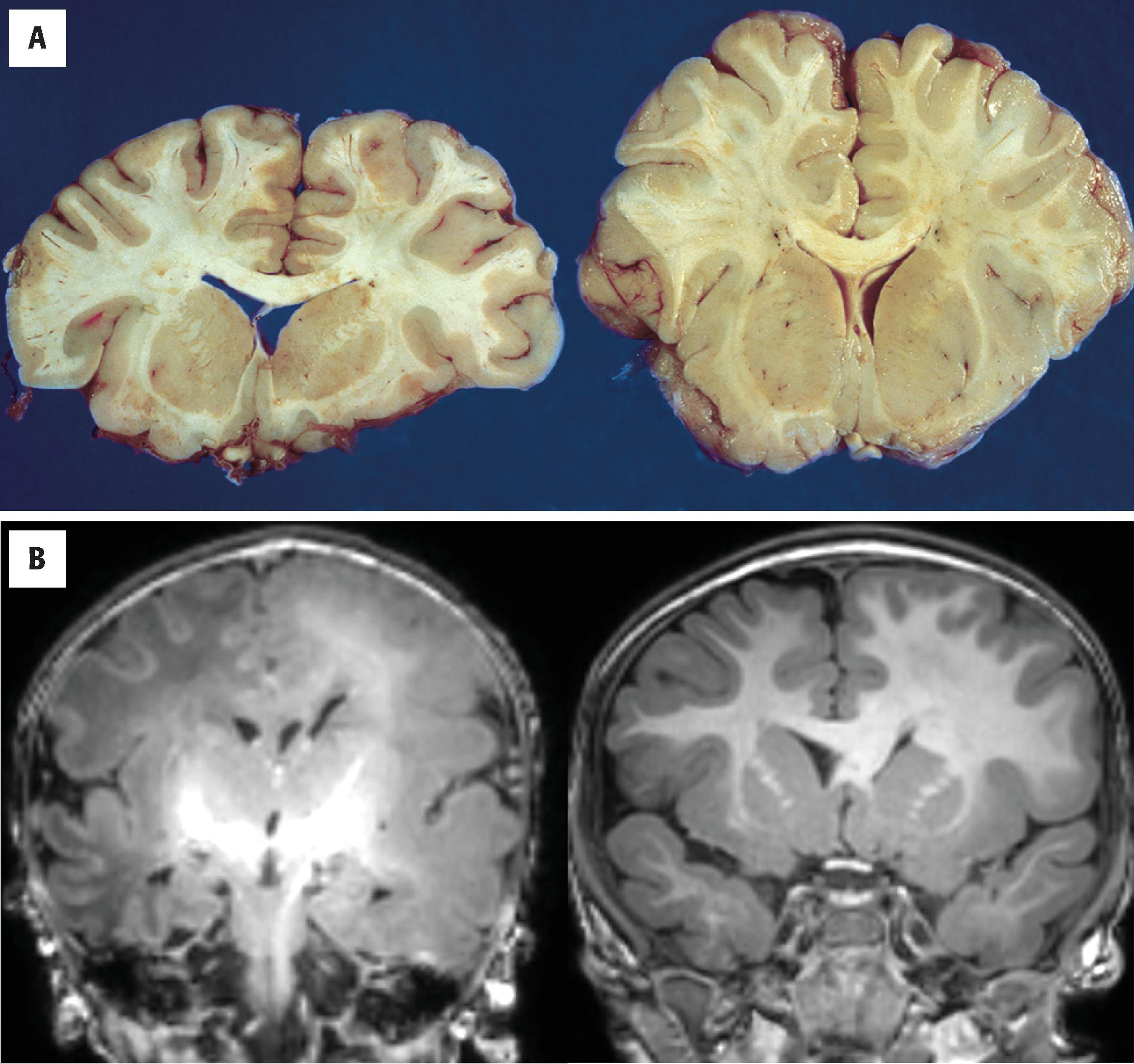
May have normal gyration, polymicrogyria, or lissencephaly/pachygyria, depending on the underlying cause, or may have a relatively normal gyral pattern
The cerebellum may or may not be affected as well, depending on the cause of the small or enlarged brain
Depend on the underlying cause
Genetically heterogenous with a large number of associated single gene mutations and chromosomal structural alterations
The differential diagnosis is broad for both microcephaly and macrocephaly. Detailed macroscopic examination of the gyral patterns, gray and white matter volume, patency of the aqueduct, and ventricular size, for example, allows preliminary determination of the underlying condition, especially in light of other systemic (i.e., syndromic) pathologic findings, chromosomal studies, or family history. Microscopic evaluation of cortical cytoarchitecture, neurons for storage or degenerative processes, and the ventricular lining and leptomeninges for hemosiderin, for instance, helps identify the type of process, many of which are discussed in subsequent sections.
Seizures may require anticonvulsant therapy. Shunting of the ventricular system to either the peritoneum or venous circulation treats hydrocephalus. Otherwise, the prognosis and treatment depend on the underlying cause of the abnormal head and brain size.
A variety of nongenetic or environmental insults can lead to microcephaly; these include in utero or congenital infections (e.g., congenital Zika virus, cytomegalovirus, and herpes simplex virus), drugs and medication exposure (e.g., alcohol, drugs such as hydantoin or aminopterin) and vascular insults (e.g., placental insufficiency). In Zika virus infection, micrencephaly is accompanied by lissencephaly (complete to incomplete agyria), hydrocephalus, and multifocal dystrophic calcifications in the cortex and subcortical white matter, with associated cortical displacement and mild focal inflammation.
In this section, malformations resulting from defective formation of the neural tube are discussed, including anencephaly, encephalocele, myelocele, and meningocele .
Neural tube defects (NTDs) are caused by incomplete neurulation (fusion of the neural folds) at any point in the neuroaxis at the end of the first 4 weeks of embryonic life. NTDs are among the most common malformations and account for 0.001 % to 1 % of all human malformations, depending on the population studied.
Neural tube formation involves bending of the neuroepithelium at the midline to generate neural folds that then fuse in the dorsal midline (primary neurulation). Neural tube closure is discontinuous; rather than simultaneously rolling up along the extent of the rostro caudal axis, there are distinct sites of initiation located at characteristic axial levels. NTDs can thus be caused by failure of particular initiation events or disruption of the progression of closure between these sites. Failure of neural tube formation leads to damage to the exposed neural tissue, the ensuing deficit depending on the region affected. Although theoretically a neural tube defect can arise from reopening of a previously closed neural tube, experimental data in animals support a disruption of closure as the pathogenic mechanism in NTDs.
Failure of neural tube closure can be complete, resulting in craniospinal rachischisis ( Fig. 4.4 ), limited to the cranial region resulting in anencephaly ( Fig. 4.5 ), or caudal, resulting in myelocele or spinal meningocele ( Fig. 4.6 ). NTDs usually occur at preferred points along the neuroaxis, although they can occur anywhere.
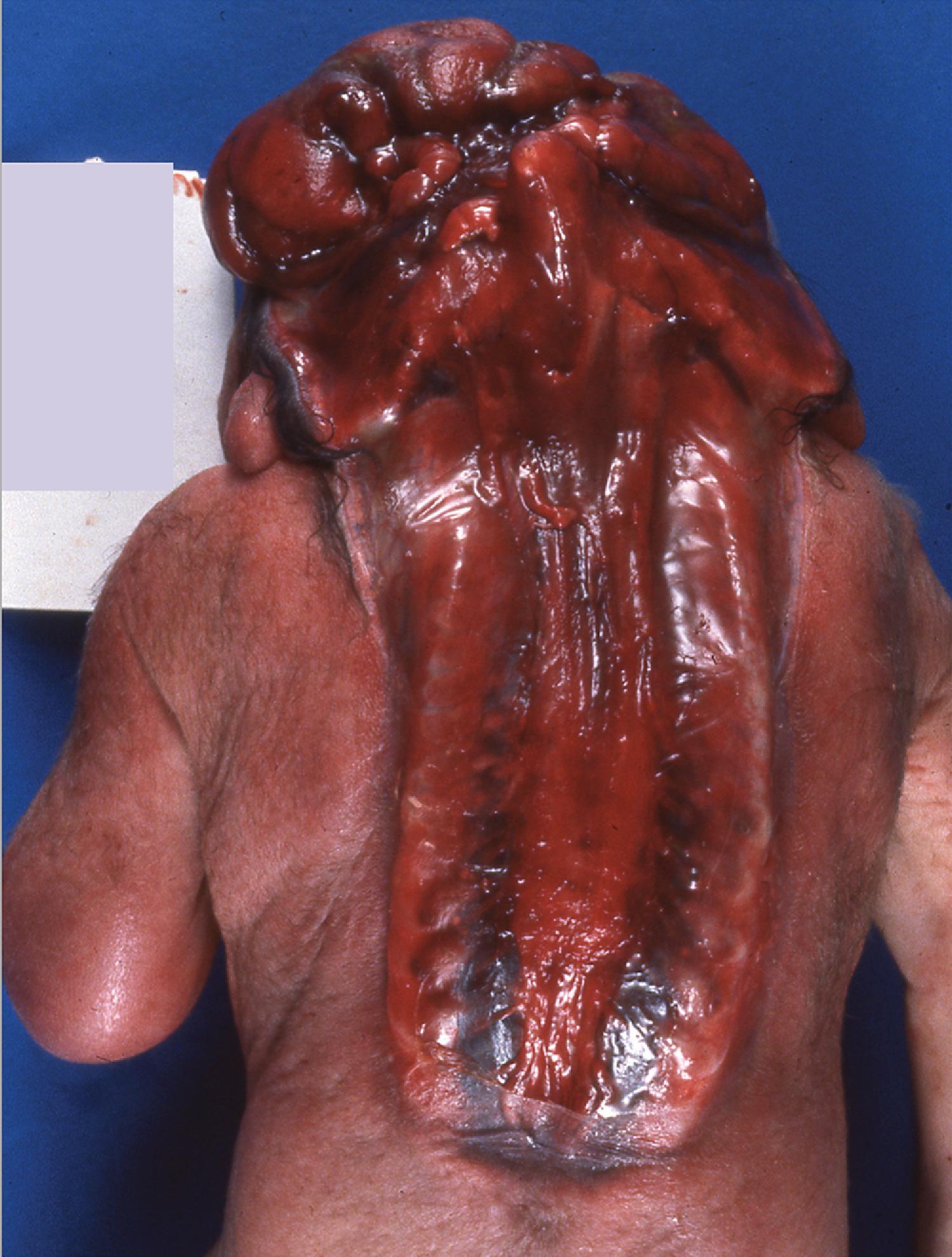
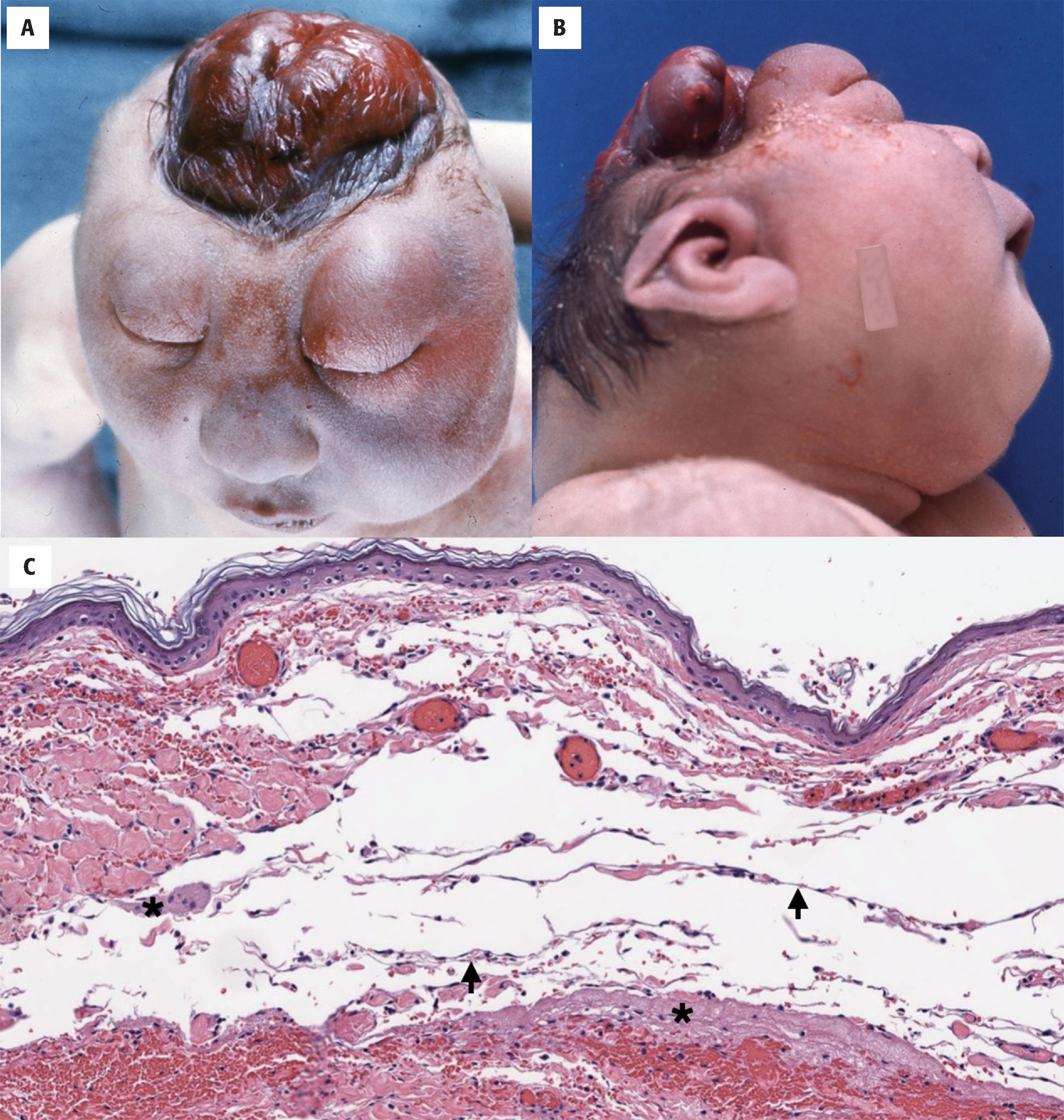
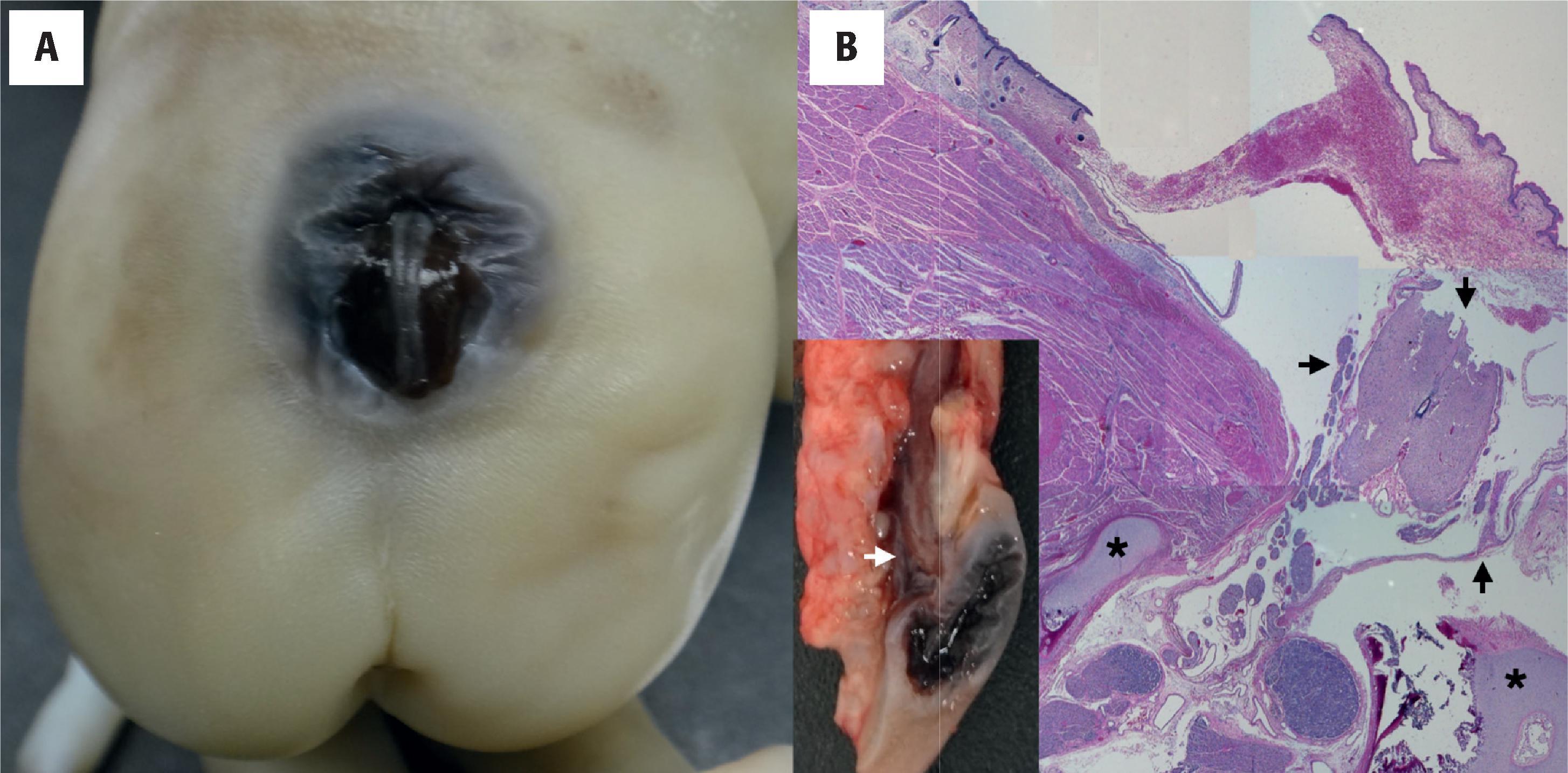
Encephalocele, meningocele, and meningomyelocele are abnormalities of skeletal development. Encephalocele is a herniation of the brain through a defect in the skull ( Fig. 4.7 ), while a meningocele is a protrusion of meninges from the vertebral column (meningomyelocele, if the spinal cord is also included). Spina bifida occulta is a defect in the dorsal bony elements of the vertebral column not involving the cord or meninges. Encephalocele can be an indication of a syndrome such as Meckel-Gruber syndrome, a ciliopathy with multiple CNS abnormalities, the most common of which is an occipital encephalocele, present in close to 90% of the cases ( Fig. 4.8 ). Other common malformations in Meckel-Gruber syndrome include multicystic kidneys, hepatic fibrosis, and polydactyly (see Fig. 4.8 ).
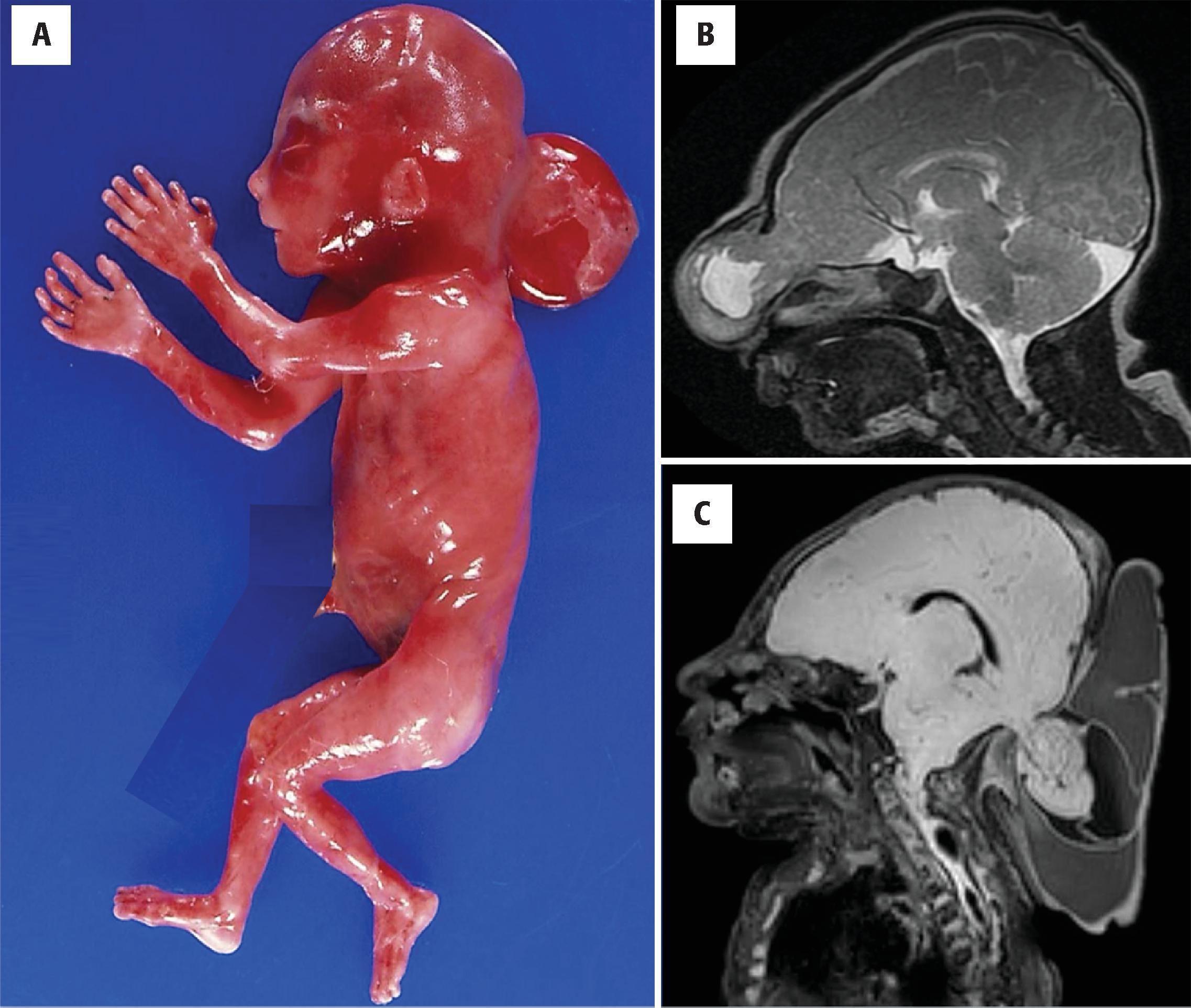
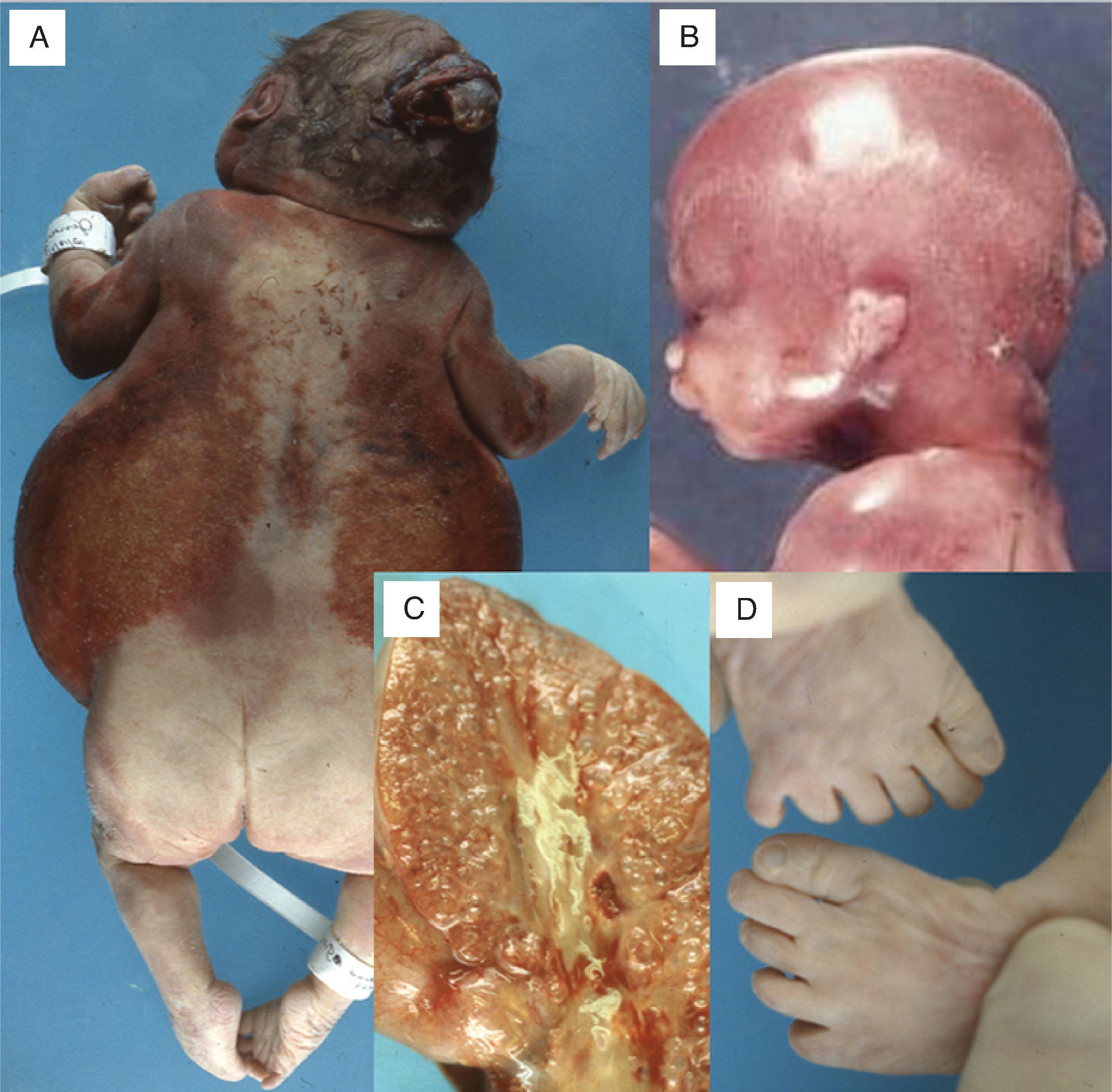
For all NTDs, the clinical deficits naturally relate to the level of involvement. The most severe NTDs, such as craniorachischisis and anencephaly, are incompatible with life, and many cases are electively aborted following identification on prenatal ultrasound. Anencephalic infants who are born alive show only rudimentary brainstem reflexes and die soon after. Encephaloceles, especially those involving the frontal cortex, may be asymptomatic until adult life, when intranasal mass, pharyngeal obstruction, or recurrent meningitis develops. Facial abnormalities or hypothalamic dysfunction can be seen. Occipital region encephaloceles may include the cerebellum or calcarine cortex (or both) and may present with visual defects or cerebellar signs. Those involving the brainstem may be life-threatening. The presence of cortex within or adjacent to the displaced brain tissue may cause seizures. Spinal dysraphisms (meningocele, meningomyelocele) generally lead to paralysis and sensory deficit below the level of the lesion, as well as bladder and bowel dysfunction. Defects at or above L2 are usually accompanied by skeletal deformities, including kyphosis and scoliosis, dislocated hips, and clubfeet. Moreover, open spinal NTDs are nearly always associated with hindbrain crowding leading to displacement of the cerebellar vermis into the foramen magnum and hydrocephalus, a combination known as the Chiari II (or Arnold-Chiari) malformation ( Figs. 4.9 and 4.10 ). Pure spinal meningoceles (i.e., not involving spinal neural tissue) may be asymptomatic.
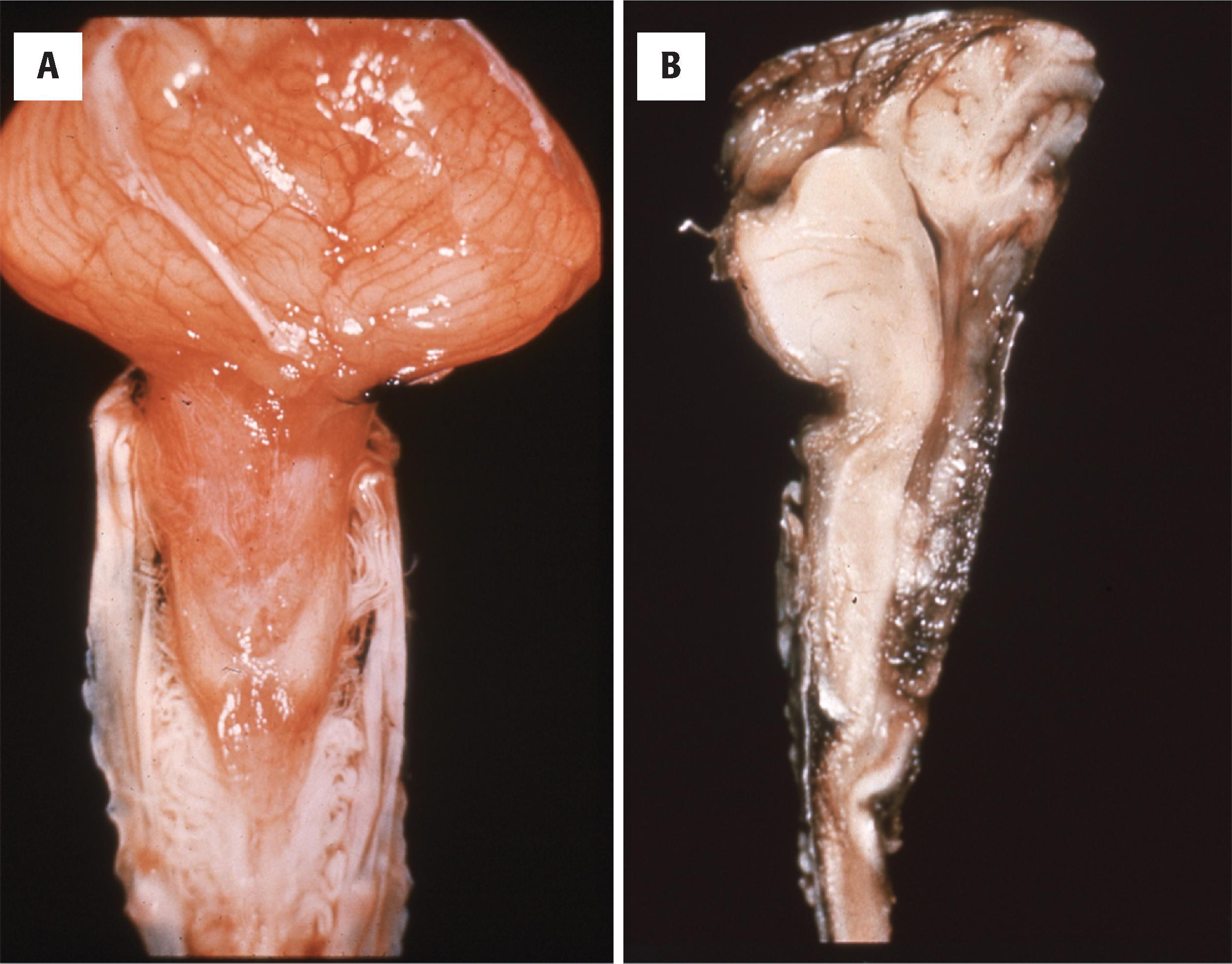
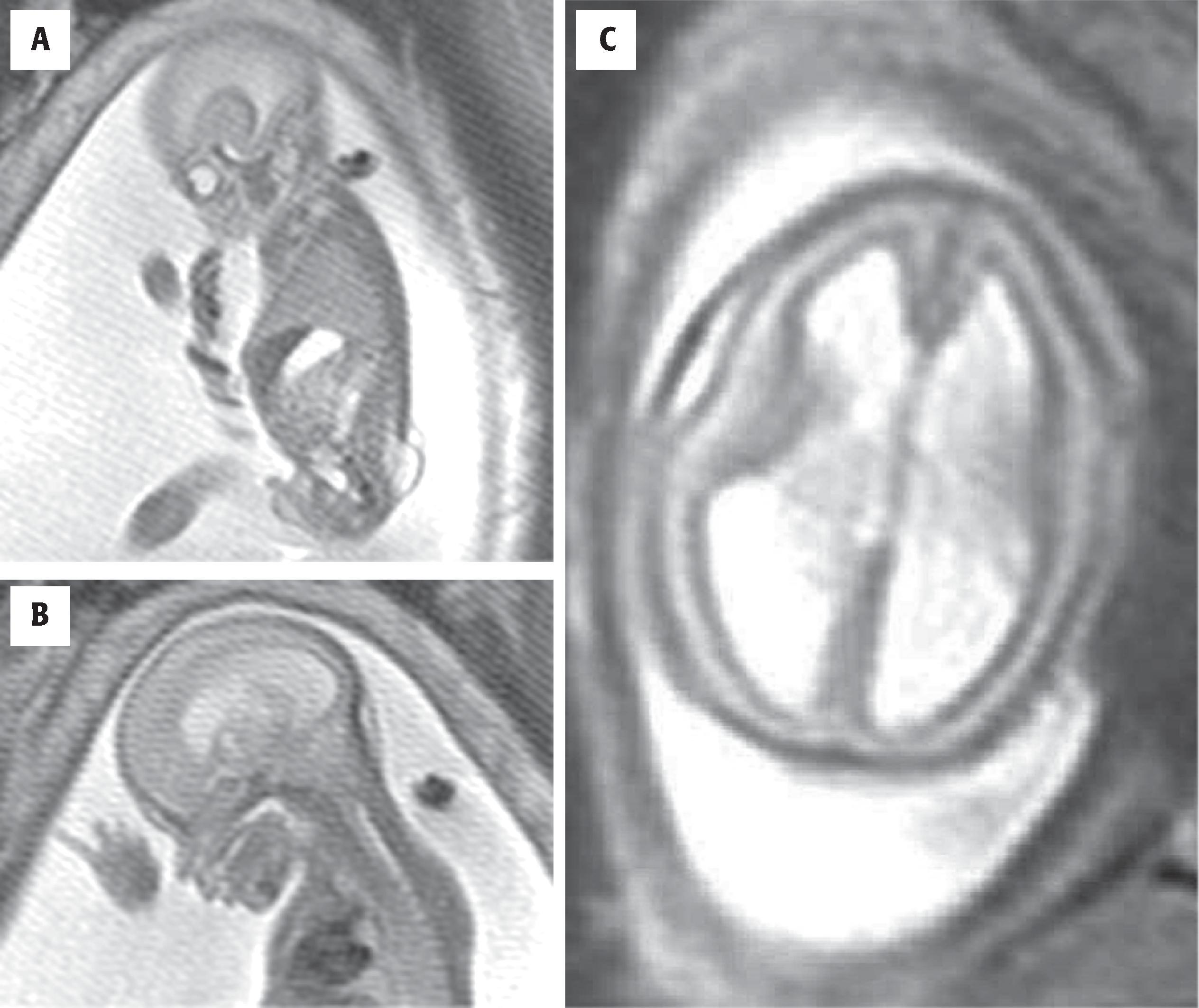
Prenatal detection of NTDs relies on screening by serum and amniotic chemistry and prenatal ultrasound. Elevated maternal serum or amniotic fluid α-fetoprotein and increased amniotic fluid acetylcholinesterase are found in almost all cases with “open” NTDs (i.e., those lacking a covering of skin over the exposed meninges or central neuroglial tissue). Even though α-fetoprotein levels are highly sensitive for open NTDs, they are not specific; if combined with acetylcholinesterase determination, however, the specificity is improved. Fetal ultrasonography as early as 14 to 16 weeks’ gestation can detect the defects themselves if large enough, as well as associated changes (see the next section). High-level fetal ultrasonography, fetal magnetic resonance imaging (MRI), and amniocentesis may be required for confirmation. Polyhydramnios is a common, although inconsistent, finding in pregnancies with NTDs.
Both genetic and environmental risk factors have been associated with neural tube closure defects. Genetic composition may also modify the teratogenic risk of environmental factors. In recent years, folic acid deficiency has been demonstrated as the major modifiable environmental risk factor for NTDs. The reduction in risk of NTDs following maternal folic acid supplementation led to public health recommendations that women who may become pregnant should consume 0.4 mg of folic acid daily or 4 mg daily following a previous affected pregnancy. Other risk factors include maternal diabetes, obesity, hyperthermia, vitamin deficiency, and anticonvulsant therapy with valproic acid and carbamazepine. Genetic risk factors for NTD cluster on genes involved in folate metabolism. Folate metabolism is important for several important cellular processes such as methylation of DNA and other macromolecules and nucleotide biosynthesis for cell division. Polymorphisms in the 5,10-methylene tetrahydrofolate reductase (MTHFR) gene are involved with increased risk of NTDs. Mitochondrial folate metabolism is likely a major contributor of substrate for cytosolic folate metabolism. Alterations in genes involved in mitochondrial folate metabolism have recently been identified in cases of NTD.
Failure of closure of some portion of the neural tube: rostral and complete (anencephaly); rostral and partial, with displacement of brain tissue through the defect (encephalocele); and spinal, with herniation of the meninges (meningocele), or central neural tissue (myelocele or myelomeningocele) associated with secondary crowding of the posterior fossa contents (Chiari II malformation)
Caused by incomplete neurulation (fusion of the neural folds) at any point in the neuroaxis at the end of the first 4 weeks of embryonic life
May be “closed” or “open” (i.e., with or without a covering of skin, subcutis, and bone)
Incidence of anencephaly, 0.1 to 0.7 per 1000 live births; that of spinal dysraphism, somewhat less
Together, anencephaly and spinal dysraphism account for 0.001% to 1% of human malformations, depending on the population studied
Risk increased if a sibling is affected
M/F ratio of 1:3 to 1:7
Associated with maternal diabetes, hyperthermia, and anticonvulsant therapy
Prenatal detection by elevated maternal serum α-fetoprotein and amniotic fluid acetylcholinesterase, prenatal ultrasound, and MRI
Anencephaly is fatal, whereas encephaloceles cause seizures, mental retardation, blindness, or other signs and symptoms, depending on the site of the cranial defect and the extent of displacement of brain tissue
Occipital encephalocele is seen most commonly as part of Meckel-Gruber syndrome
Spinal defects in which cord tissue is present show paresis below the level of the lesion and Chiari II malformation in >90% of cases
A Chiari II malformation consists of hindbrain crowding from a small posterior fossa (secondary to loss of expansion by CSF, which has leaked through the spinal defect in utero) leading to displacement of cerebellar vermis tissue into the foramen magnum and distortion of the brainstem with hydrocephalus
Risk is reduced by periconceptional folate supplementation
Encephaloceles show displaced brain tissue and variable amount of CSF; brain adjacent to the defect may be abnormal by ultrasound or fetal MRI
By prenatal ultrasound or fetal MRI: anencephaly associated with a flattened, sloping skull base and protuberant eyes
No treatment of anencephaly because it is universally fatal
Encephaloceles may be surgically removed for cosmesis and control of seizures
Open myelomeningoceles may require surgical closure for prevention of infection and preservation of function; affected children usually require a wheelchair (i.e., are paraplegic), unless the lesion is at the low lumbar levels
Anencephalic fetuses are easily recognized on prenatal ultrasound or fetal MRI by absence of the cranial vault, prominence of the orbits and eyes, and a flattened, downwardly sloping appearance of the skull base ( Fig. 4.11 ). Likewise, encephaloceles in the frontal, parietal, or occipital regions may be readily detected by either method (see Fig. 4.7 ). Nasal or ethmoidal (anterior) encephaloceles may be difficult to identify by prenatal ultrasound or even by computed tomography (CT) in the neonatal period because the anterior skull base is primarily cartilaginous. MRI using 2- to 3-mm sections and T1- and T2-weighted images may be useful.
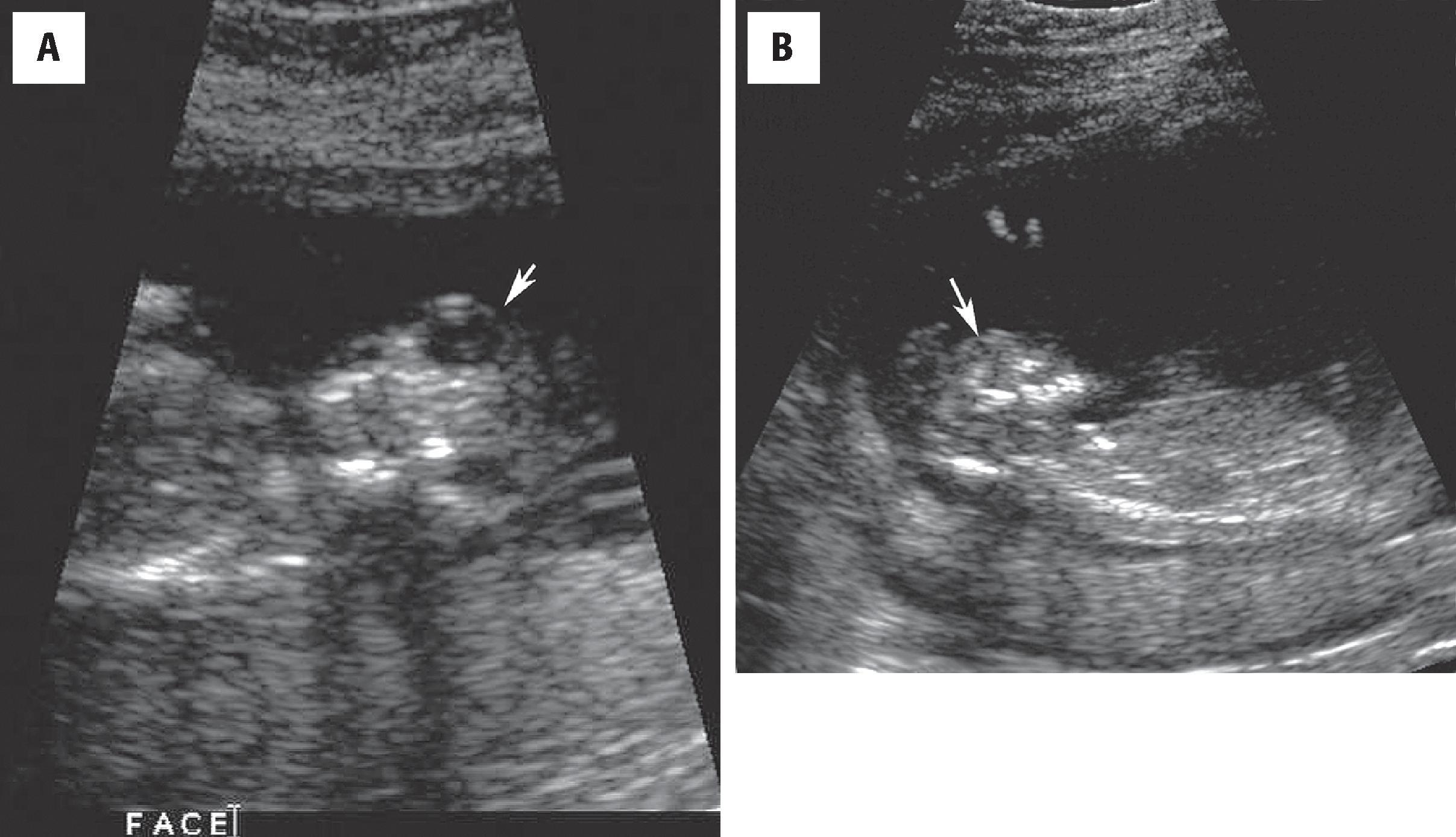
Spinal defects may be identified by prenatal ultrasound as focal loss of normal echogenicity of the posterior vertebral elements; a meningocele is a hypoechoic mass of variable size and may or may not have denser material corresponding to dysraphic neural tissue. Fetal MRI easily demonstrates the spinal mass. Associated changes, such as a small posterior fossa and herniation of cerebellar tissue into the foramen magnum and cervical canal, can be clues to the Chiari II malformation, even if the spinal myelomeningocele is not well seen. (See Fig. 4.10 in section on Chiari malformations.)
On plain radiographs, spinal NTDs show absence of the dorsal spinous processes with lateral splaying of the transverse processes, findings lending an “unzipped” appearance to the spine.
Complete absence of the brain and overlying skull is known as anencephaly (see Fig. 4.5 ). The calvarium is severely hypoplastic or totally absent. There is almost complete loss of brain parenchyma with only scant supratentorial tissue. The scalp, cranium, and most of the brain is replaced by a thin film of vascular tissue referred to as area cerebrovasculosa, which consists of a jumbled mix of nervous system tissue consisting mostly of glia, thin-walled vessels, ependymal and meningeal elements, and attenuated skin (see Fig. 4.5 ). It is thought that this substance remains after degeneration of the brain tissue at the “open” edges of the defect because of direct contact between the neural epithelium and amniotic fluid. Some cases show relative sparing of the infratentorial brain. The anterior pituitary and brainstem are relatively preserved in most cases. The orbits are shallow, causing protrusion of the eyes (see Fig. 4.5 ).
Encephaloceles (containing brain and meningeal tissue) (see Figs. 4.7 and 4.8 ) and cranial meningoceles (harboring only meninges and often filled with CSF, similar to a cyst) are associated with a defect in the skull, usually at the midline sutures or fontanelles. Occasionally, no clear bony defect or contiguity with the underlying brain can be identified. Herniation may contain fragments of disorganized CNS glia and ependyma or large portions of the cerebral hemispheres with ventricular cavities, as well as cerebellum or brainstem. Polymicrogyric cortex may be present at the edges of the displaced brain tissue and may generate seizure activity. The size of the encephalocele can vary from an inconspicuous bump to a mass larger than the infant’s head. Occipital encephaloceles are associated with Meckel-Gruber syndrome in a vast majority of cases. Parietal encephaloceles occur only rarely.
Spinal NTDs can involve the meninges alone (meningocele) or the meninges and underlying spinal cord (myelomeningocele) (see Fig. 4.6 ). Most NTDs occur in the lumbar region, followed by the lumbosacral region, but they can also be located at the cervical or thoracic level. Those arising in the lumbosacral region are often associated with other defects in the surrounding mesoderm, including vascular telangiectasis and other abnormalities of the spinal cord, such as hydromyelia (cystic dilation of the central canal) and syringomyelia (a glial-lined cavity within the parenchyma of the spinal cord). These lesions may extend rostrally to involve the brainstem (syringobulbia). It should be noted that these conditions are not specific to NTDs and can be found after trauma or in association with spinal tumors.
Iniencephaly (inien = nape of neck; encephaly = brain) represents an extreme retroflexion of the head with an intact, skin-covered cranium. Iniencephaly is caused by failure of closure of the posterior vertebral arches of the rostral cervical vertebrae. Iniencephaly is usually associated with abnormalities of the brainstem and the medulla and is often accompanied by an open defect, which can be an encephalocele or spina bifida. There is shortening of the spinal column with marked lordosis and hyperextension of the malformed cervical thoracic spine ( Fig. 4.12 ).
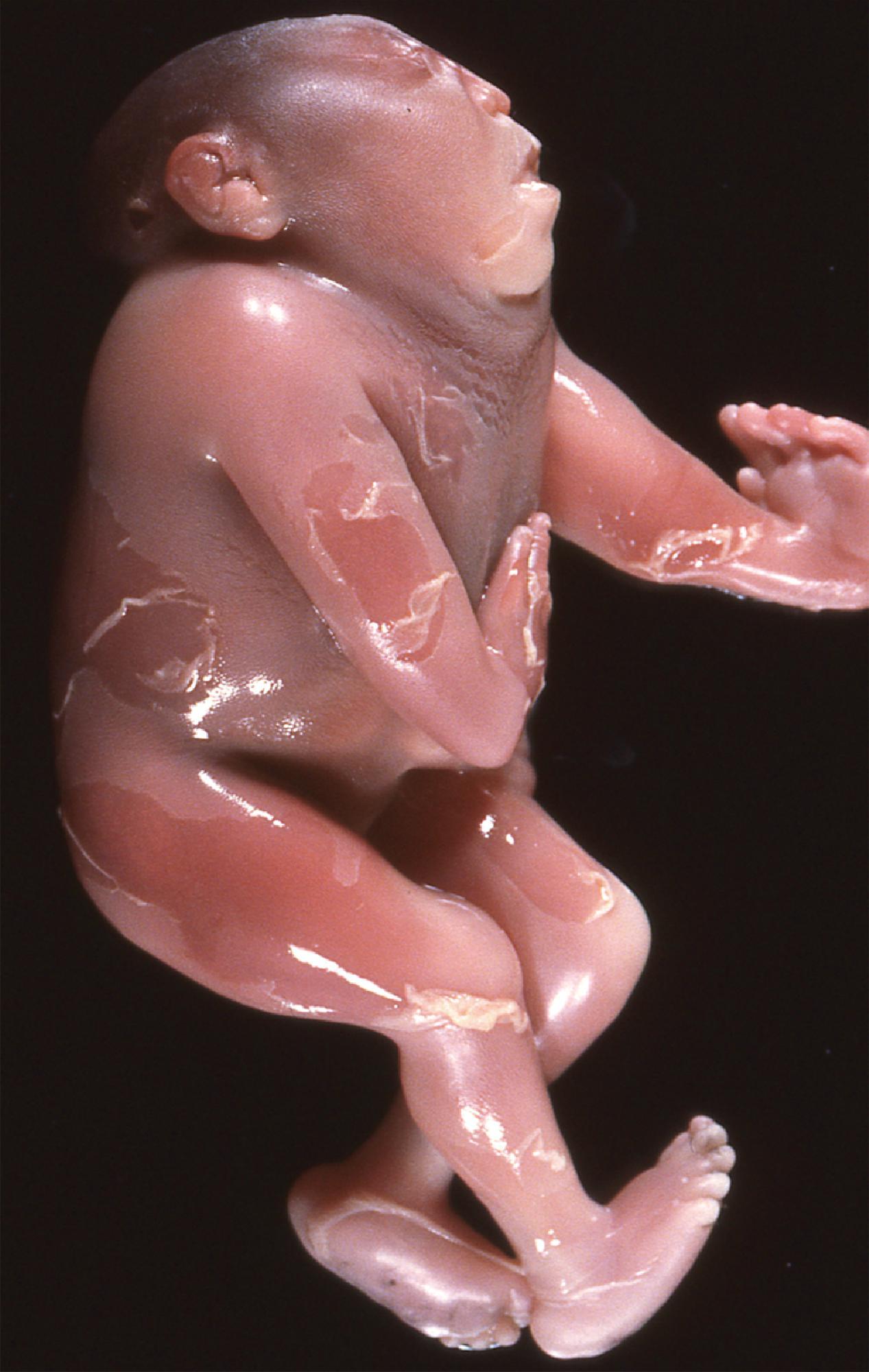
Diplomyelia refers to duplication of the spinal cord segments ( Fig. 4.13 ), occasionally in association with myelomeningocele; midline pegs of vertebral bone and connective tissue may result in partial duplications or splitting of the cord (diastematomyelia) (see Fig. 4.13 ).
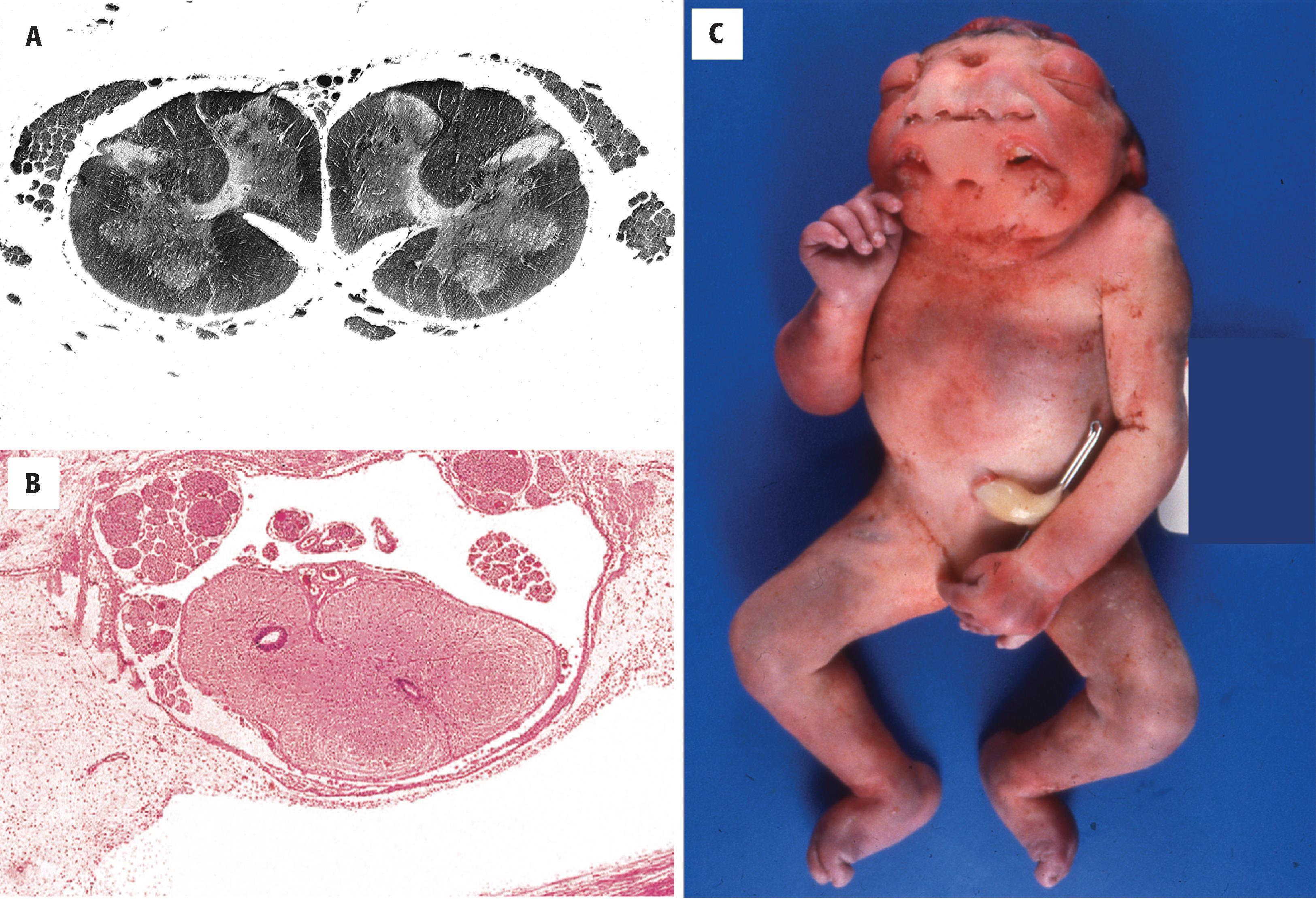
Spinal NTDs can be occult (spina bifida occulta), defined as a defect in the dorsal bony elements of the vertebral column not involving the cord or meninges. Spina bifida occulta may be found only incidentally on radiographic studies, or it may be suspected on finding a tuft of hair, cutaneous angioma, or subcutaneous lipoma in the midline of the back overlying the occult bony defect. Occasionally, a sinus tract may communicate between the skin and underlying thecal sac.
The Chiari II (or Arnold-Chiari) malformation consists of the association of a spinal NTD with a small posterior fossa, hindbrain crowding, and secondary abnormalities of the brainstem and cerebellum (discussed later with posterior fossa malformations).
Anencephaly: absence of the cranium and most of the brain tissue with replacement by area cerebrovasculosa; the eyes are protuberant
Encephaloceles: vary in size from small skin-covered bumps to large masses overlying the cranial sutures/fontanelles or in the sinonasal region
Spinal defects: may be skin-covered (occult) defects in vertebral body closure or open plaquelike areas in which neural tissue and nerve roots are visible (placode), with surface covering by area medullovasculosa
Chiari II malformation: midline cerebellar tissue displaced into the foramen magnum dorsally, small posterior fossa and cerebellar hemispheres, flattened or kinked brainstem, variable expansion of the ventricular system
Area cerebrovasculosa (in anencephaly) or medullovasculosa (in spinal NTDs) is made up of ectatic, thin-walled vessels in loose connective tissue, often containing disorganized central neuroglial tissue
Spinal NTDs may contain peripheral nerve bundles
With encephaloceles, the brain, often disorganized, and the overlying meninges are in contact with dermal tissue (i.e., no intervening bone)
The cerebellum, especially the vermis, may be disorganized in Chiari II malformation
Genetically heterogeneous, associated with various different syndromes
For anencephaly, amniotic band sequence with disruption of the normally closed cranial vault
For meningocele, aplasia cutis congenita (localized defect in the dermal and subcutaneous tissue of the scalp), which can show meningeal tissue, but an underlying skull defect is not found
The diagnosis of an NTD is usually straightforward, except in rare cases of small encephaloceles, dural sinus tracts, or aplasia cutis congenita, in which bony skull defects can occur without the protrusion of meningeal or central neuroglial tissue. Caudal lipomas, teratomas, and dermoid cysts, although often markers of an underlying spinal dysraphism, can occur in isolation.
Amniotic band sequence results when a fibrous band from the placental amniotic membrane entraps various fetal parts in utero, physically cuts through organs, and can lead to amputations and clefts by occluding the blood supply. Asymmetric clefts, body wall defects, often with extrusion of viscera, and highly variable amputations can be seen. When the amniotic membrane wraps around the skull, loss of cranial tissue and brain results, leading to striking resemblance with anencephaly. Such amniotic band disruptions can be distinguished from true NTDs by the asymmetry of involvement and the presence of facial clefts or extremity amputations ( Fig. 4.14 ).
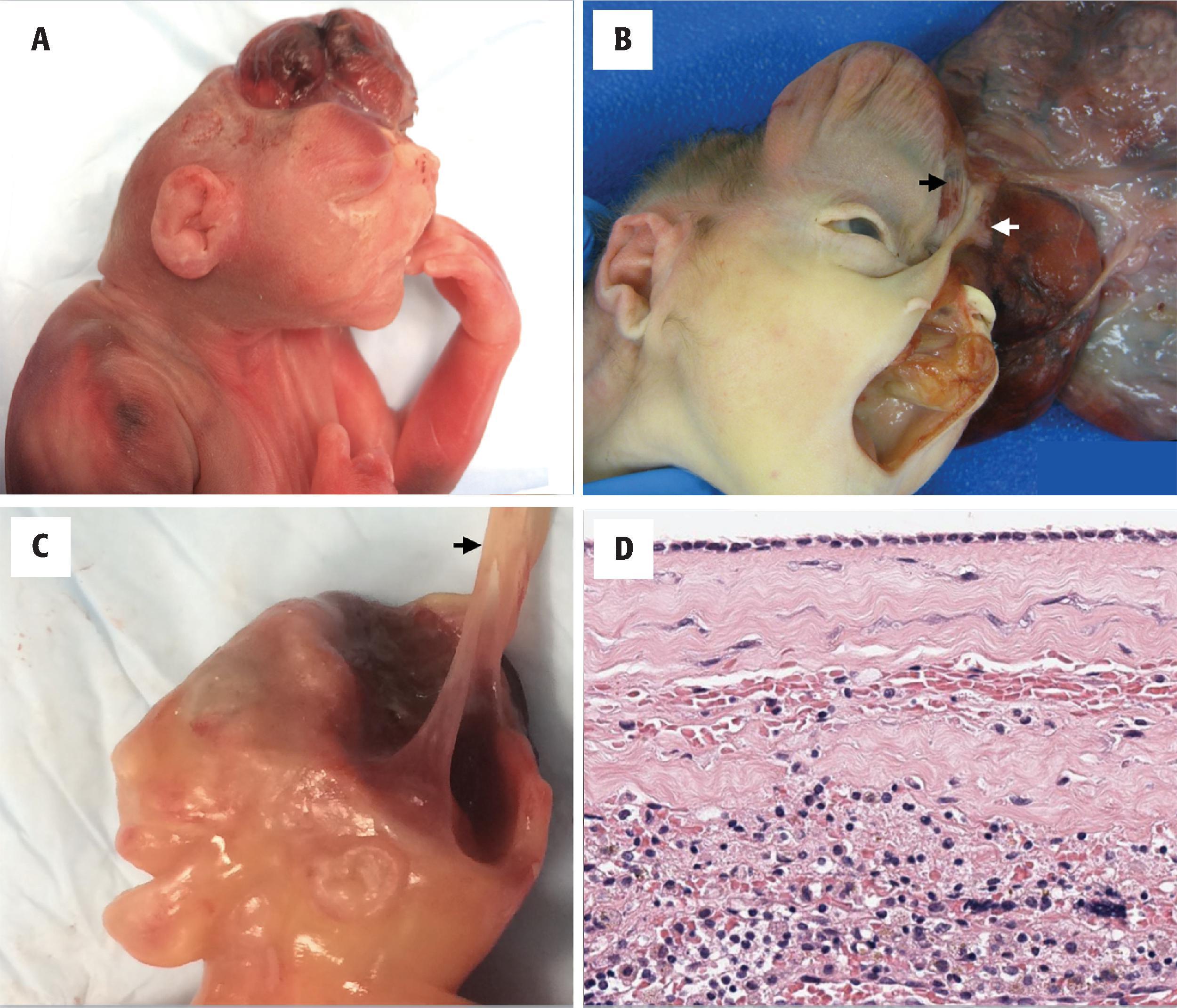
Anencephalic fetuses have a high incidence of intrauterine demise and, if liveborn, die within a few hours.
If a dysraphic disorder has been diagnosed prenatally and the pregnancy continued, an atraumatic delivery may be planned to improve the neurologic outcome in children with myelomeningoceles. Large encephaloceles may also be managed in this way, although the clinical context in which they occur (i.e., associations and syndromes) also influences decision making. Overall, surgical excision is recommended to prevent breakdown of skin over the lesion (particularly in occipital encephaloceles) and secondary infection, including meningitis, in the affected infant. The prognosis is significantly better with anterior (sinonasal) encephaloceles, which may be asymptomatic.
Spinal dysraphism is best treated by surgical closure as soon after birth as feasible, again to prevent infection and limit the extent of disability, because cognitive function in survivors of spinal NTDs has been shown to be negatively affected by meningitis or ventriculitis. The degree of ambulatory problems depends on the spinal level of the lesion. Other significant clinical issues involve recurrent upper and lower urinary tract infections and hydrocephalus, which often requires shunting. Late sequelae of myelomeningoceles include scoliosis and traction on the cord from tethering at the level of the defect, the latter occurring either as a “primary” abnormality or as a consequence of previous surgery and scarring. In either case, surgical release of the tethered cord is recommended to prevent exacerbation of deficits. Less commonly, infarction or compression of the cord by arachnoid cysts or inclusion cysts arising in the scar can be encountered.
Treatment of spinal dysraphism has historically involved surgical closure after birth; however, with advancements in prenatal diagnosis and improvement in surgical and anesthetic techniques, maternal-fetal surgery for in-utero correction of neural tube defects is increasingly being attempted.
In this section, we discuss common midline defects of the prosencephalon including holoprosencephaly, agenesis of corpus callosum, and septo-optic dysplasia.
Holoprosencephaly (HPE) refers to a spectrum of primary malformations resulting from failure of the forebrain (prosencephalon) to bifurcate into two hemispheres. HPE is a defect of normal forebrain induction/patterning likely arising in the fifth week of gestation. HPE is relatively common with an estimated incidence of approximately 0.48 to 0.88 per 10,000 liveborn children with normal chromosomes. There is a high rate of fetal loss with the incidence of HPE in intrauterine demise estimated at 40 per 10,000.
In addition to variable degree of failure of midline division “holosphere” or undivided prosencephalic vesicle, patients frequently exhibit specific craniofacial anomalies ( Fig. 4.15 ) because of the interrelated development of the forebrain and underlying mesodermal structures. Midline facial clefts, cyclopia, and nasal anomalies (see Fig. 4.15 ) are commonly seen. The severity of facial malformation often predicts the degree of brain abnormalities (“the face predicts the brain”). Especially in the most severe forms, the same failure of induction of midline structures may be reflected in abnormal midline facial features. The so-called “microform” HPE shows craniofacial anomalies without accompanying structural brain defects.
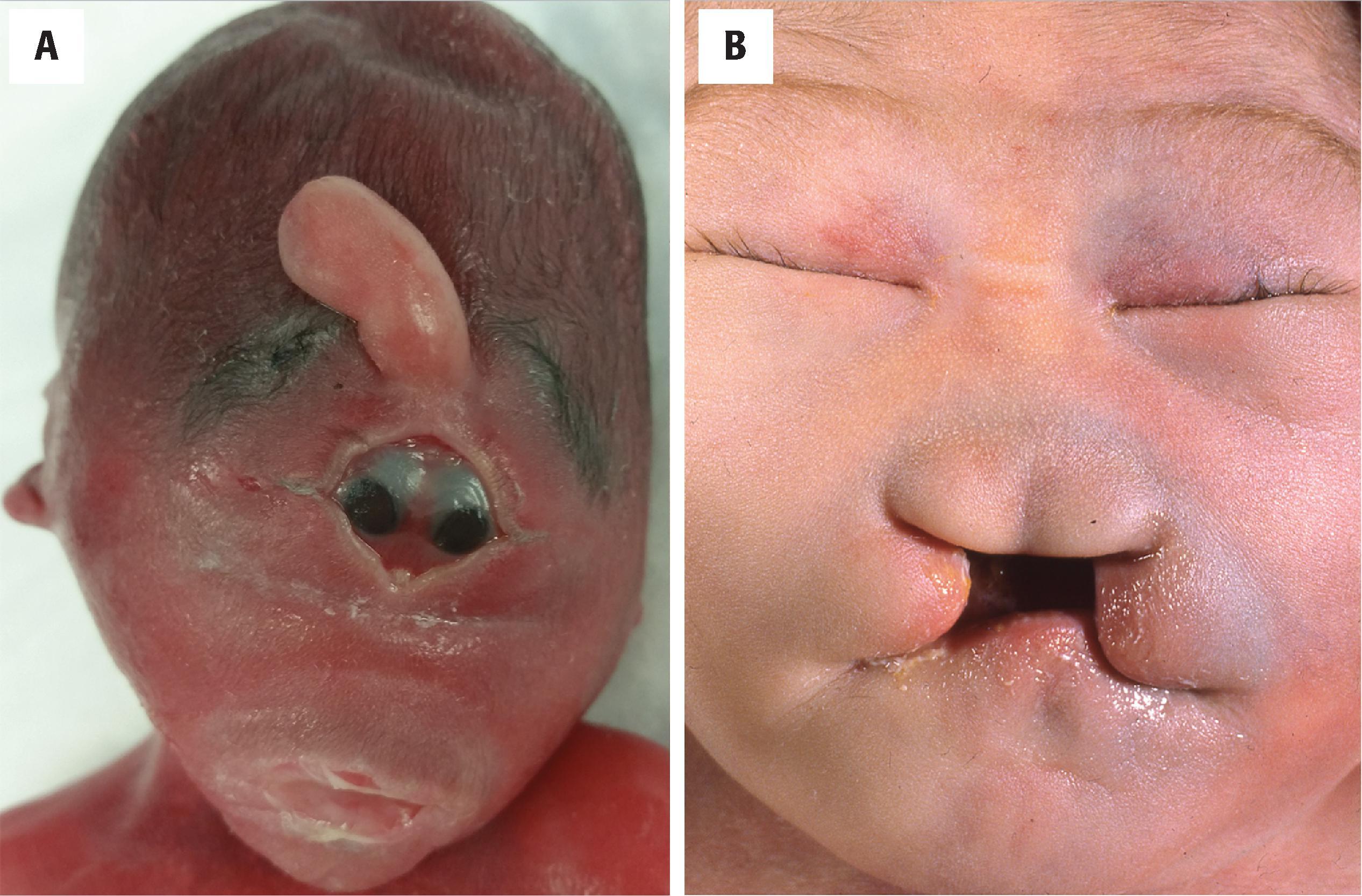
HPE is likely an early malformation resulting from abnormal patterning of the prosencephalon by the mesodermal floor plate in the fifth to sixth gestational weeks. HPE is thought to result from the failure of induction of midline structural specification. Early clues to the involvement of environmental factors were provided by an outbreak of cyclopia in lambs in the early 1960s, which was linked to the teratogenic effect of the alkaloid cyclopamine in a forage plant on which the pregnant ewes were feeding. The cause of the defect was eventually discovered to be disruption of sonic hedgehog (SHH) signaling and cholesterol biosynthetic pathways by the toxin. In humans, well-established environmental/maternal factors include maternal diabetes and ethanol consumption, although the pathogenic mechanisms are still unclear.
The effect of genetic factors was hinted at by the fact that the malformation runs in families, although the degree of involvement among affected individuals can vary widely within the same family. Recently, the application of modern NGS technologies has increased our understanding of the genetic underpinnings of HPE. We now know that as many as 75 % of cases have a recognizable genetic etiology. Half of the cases have cytogenetic/chromosomal alterations, of which trisomy 13 and triploidies account for the majority of cases. Trisomy 18 and other chromosomal anomalies are less common. The second group, accounting for close to 25 % of cases, consists of syndromic patients who manifest HPE in addition to other systemic abnormalities. Some of these include Smith-Lemli-Opitz, Meckel, and velocardiofacial syndromes. The best known of the syndromes with HPE is Smith-Lemli-Opitz syndrome, a defect of cholesterol biosynthesis which is due to autosomal mutations in the DHCR7 gene. CNS abnormalities include midline malformations such as HPE and agenesis of corpus callosum. Systemic findings include severe hypocholesterolemia, craniofacial defects such as anteverted nostrils and ptosis of eyelids, skeletal anomalies such as syndactyly of second and third toes, and visceral abnormalities including hypospadias and cryptorchidism in males.
Single gene defects and small structural alterations explain most of the remaining HPE cases. Most genes implicated in HPE play a part in the SHH pathway, which regulates ventral development in both the forebrain and spinal cord. These include SHH and members of its downstream signaling pathway including Patched-1 (PTCH), SIX3, and GLI2. Other genes such as TGIF, TDGF1/crypto, and FAST1 are involved in the Nodal/TGFbeta signaling pathway, which plays a vital role in neural patterning.
The pathogenesis of the HPE sequence has been shown to be related to failure of induction of the ectoderm overlying the ventral neural tube by the notochord. The notochord secretes the signaling molecule SHH, which mediates ventral patterning of the midbrain and forebrain. SHH also appears to directly participate in craniofacial and eye development.
Failure of normal forebrain induction/patterning resulting in a spectrum of abnormalities (from least to most severe): arhinencephaly (absence of the olfactory bulbs and tracts), lobar holoprosencephaly, semilobar holoprosencephaly, alobar holoprosencephaly (complete failure of outgrowth of two cerebral hemispheres with fusion of the midline diencephalic structures)
Usually associated with midline facial defects ranging from a single midline incisor or hypotelorism, to a midline cleft lip and palate, to cyclopia with a proboscis (nasal anlage)
0.48 to 0.88 per 10,000 live births and 1 in 200 spontaneous abortions
Familial occurrence, inherited as autosomal dominant
Gender distribution is apparently equal
Associated with maternal diabetes, alcoholism, Smith-Lemli-Opitz syndrome (defect in cholesterol biosynthesis)
Opisthotonos, spasticity, seizures, mental delay
Most severe forms detectable on prenatal ultrasound or MRI
Crescent-shaped holoventricle (absence of the septum pellucidum and corpus callosum) and fusion of the thalami and basal ganglia in the semilobar and alobar forms on trans-fontanelle ultrasound or MRI
Absence of the rostrum of the corpus callosum with a dorsal interhemispheric cyst in the lobar and semilobar forms
Abnormal nasal bones in arhinencephaly on ultrasound, CT, or MRI
High incidence of fetal wastage in the most severe forms (i.e., alobar holoprosencephaly with cyclopia)
Profound mental retardation, apneic spells, and hypothalamic dysfunction in severe forms; lesser degrees of cognitive delay and seizures in the limited forms
While prenatal ultrasound remains the most commonly used imaging modality, it is unable to diagnose less severe cases on the HPE spectrum. MRI is more sensitive. In alobar HPE, prenatal and transfontanelle sonograms and fetal MRI may demonstrate absence of the falx cerebri and interhemispheric fissure, as well as a crescent-shaped holoventricle and fused diencephalon ( Fig. 4.16 ). By ultrasound, semilobar HPE may show disordered cerebral cortical gyration and thalamic midline fusion, with or without a dorsal cyst. In semilobar HPE, the posterior portion (splenium) of the corpus callosum forms normally, whereas the anterior (body and genu) is absent, best seen on sagittal T1-weighted MRI; this pattern is opposite the situation in partial callosal agenesis ( Fig. 4.17 ; see the section later on midline/commissural defects). The septum pellucidum is absent on MRI in both the alobar and semilobar forms. Arhinencephaly is detectable on MRI as absence of the olfactory sulcus and tracts; CT may demonstrate absence or hypoplasia of the nasal bones.
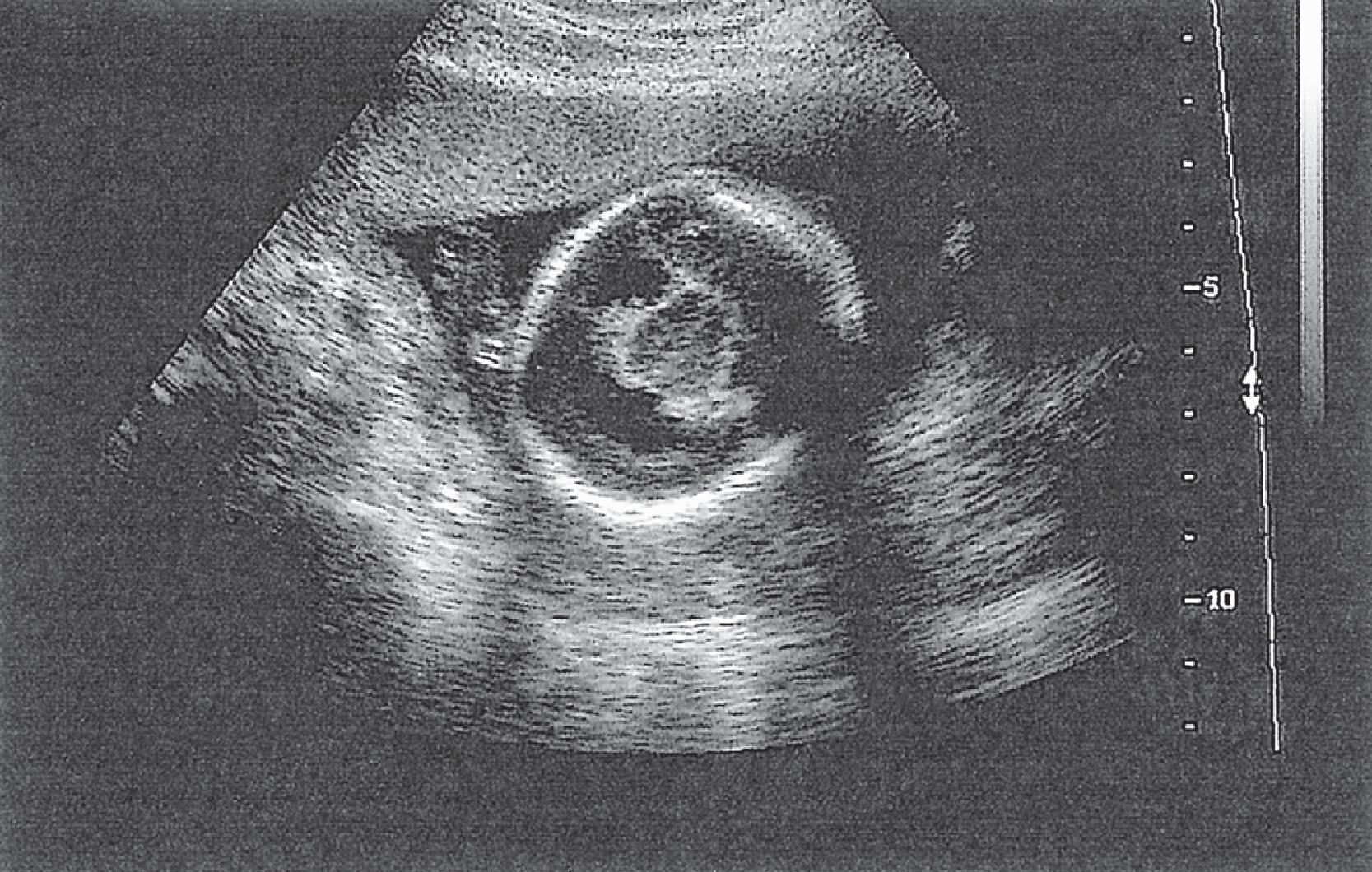
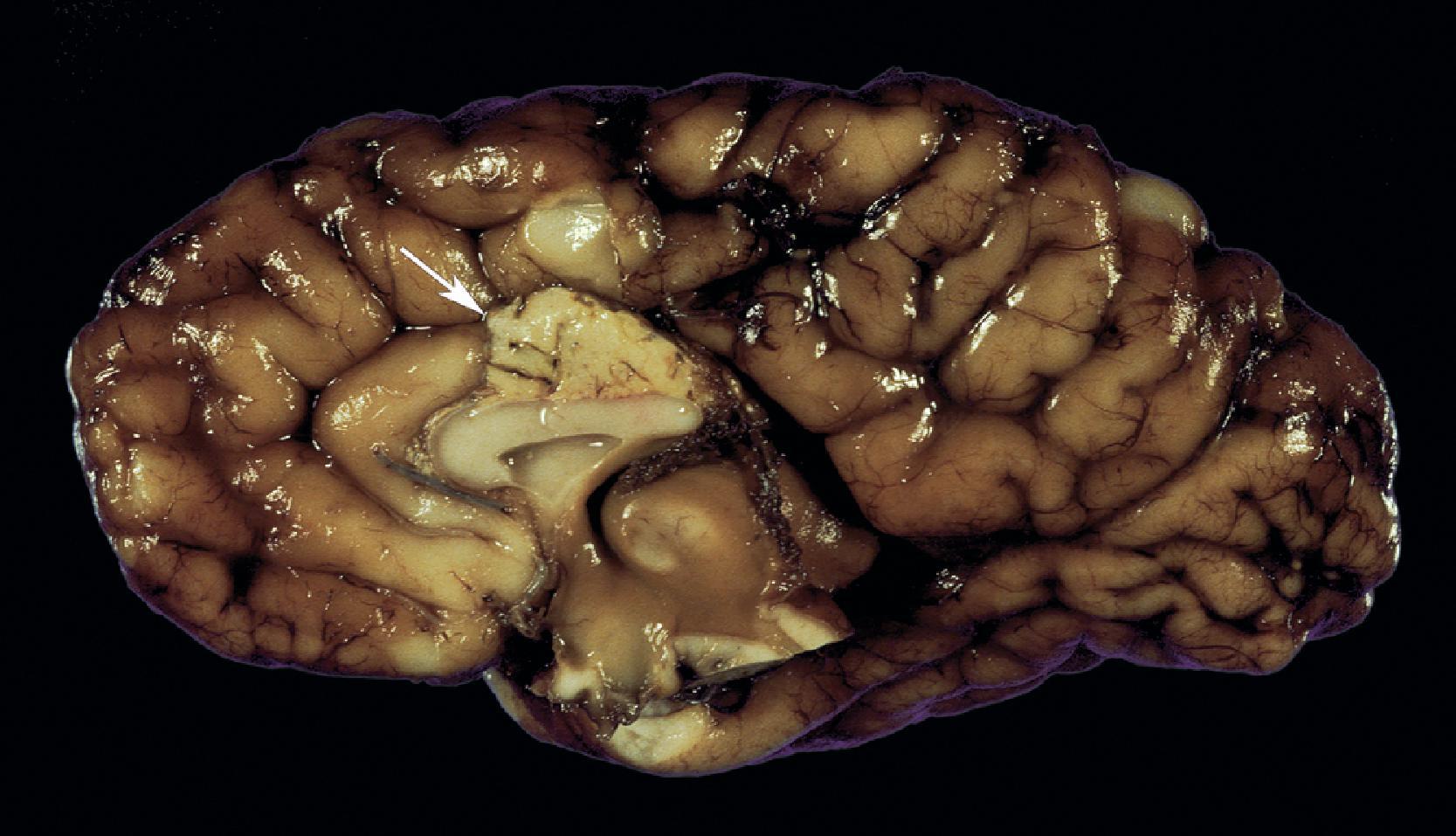
The essential feature of all forms of HPE is incomplete separation of midline structures, which can range from isolated absence of the olfactory bulbs and tracts (arhinencephaly) to total absence of the interhemispheric fissure in alobar HPE. Virtually all except the mildest forms of HPE show a smaller brain size (micrencephaly) with brain weight averaging about 100 g at term in alobar HPE (normal, 380–410 g). The olfactory bulbs and tracts, as well as the straight sulci, are absent in virtually all cases (arhinencephaly). The optic nerves may be hypoplastic, or fused in the case of cyclopia, whereas the remaining cranial nerves are usually normally formed. The middle and anterior cerebral arteries may be disorganized. A single anterior cerebral artery may course over the rostral midline of the cerebral hemispheres. There is a tendency for sparing of the temporal lobes in some of the milder variants.
Classification into alobar, semilobar, and lobar forms is based on the presence and extent of the midline interhemispheric fissure. In alobar HPE, the interhemispheric fissure separating the two cerebral hemispheres is absent, as are the Sylvian fissures. There is generally no delineation of the lobes of the cerebral hemisphere ( Fig. 4.18 ). In infants and older individuals, the gyri are usually distinct; however, their patterns are abnormal. Viewed posteriorly, the cerebrum is shaped like a horseshoe, with the rim contiguous with the cystlike membrane representing the roof of the single midline ventricle. The basal ganglia and thalamus lie beneath the membrane and vary from distinct paired structures to poorly defined masses that are fused along the midline. Rarely, the basal ganglia cannot be identified. The corpus callosum and anterior commissure are generally absent; however, rudimentary crossing fiber bundles may occasionally be seen. The brainstem and cerebellum are relatively normal, except for hypoplastic or absent corticospinal tracts.
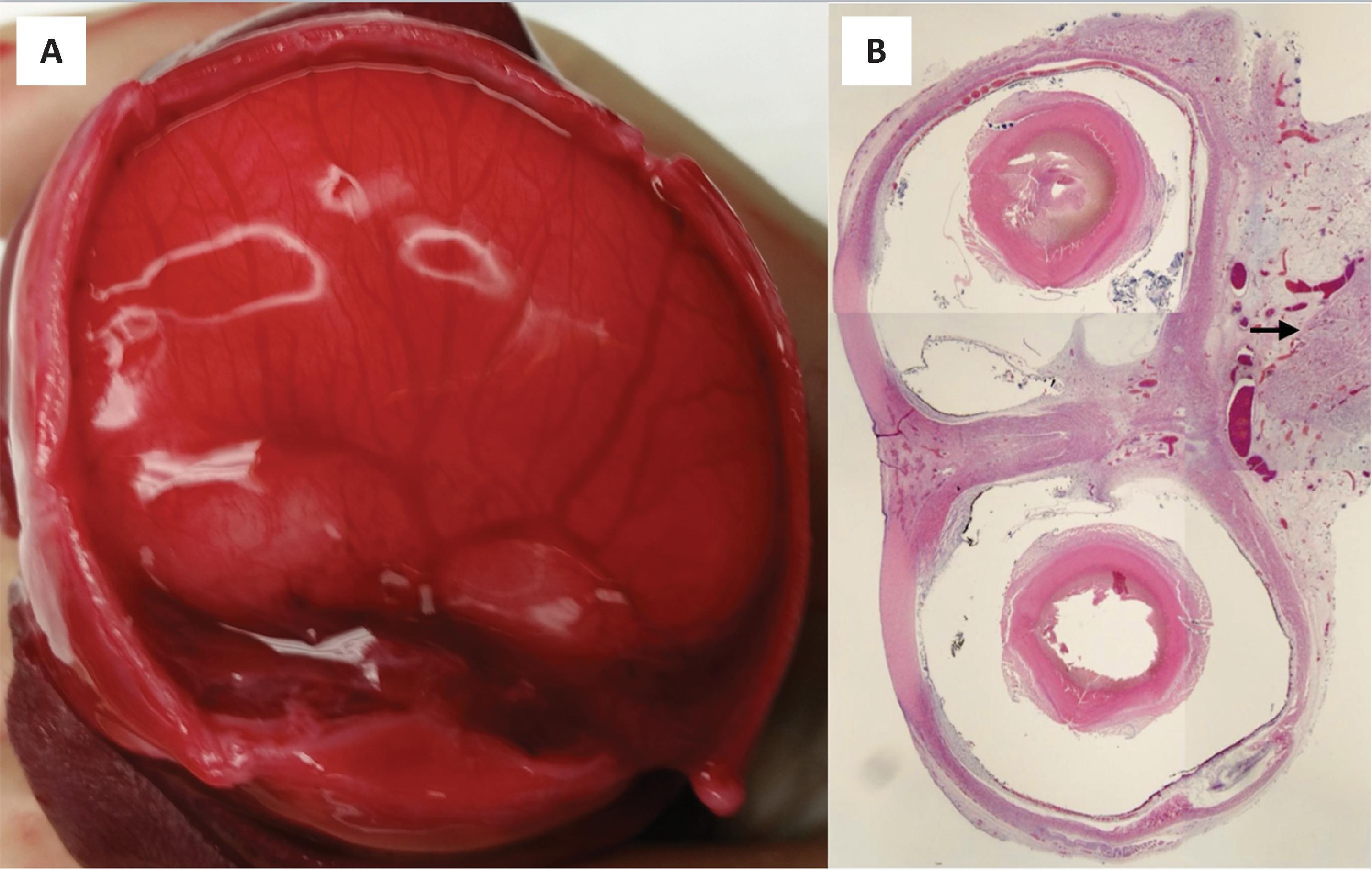
Semilobar HPE represents a lesser degree of the same CNS malformation. Usually, a partial interhemispheric fissure separates the parieto-occipital lobes, whereas the cerebral cortex crosses the midline in continuity over the frontal lobes ( Fig. 4.19 ). Variable degrees of midline fusion of diencephalic structures may be demonstrable. Occasionally, the separated parieto-occipital lobes may have an intervening dorsal midline cyst.
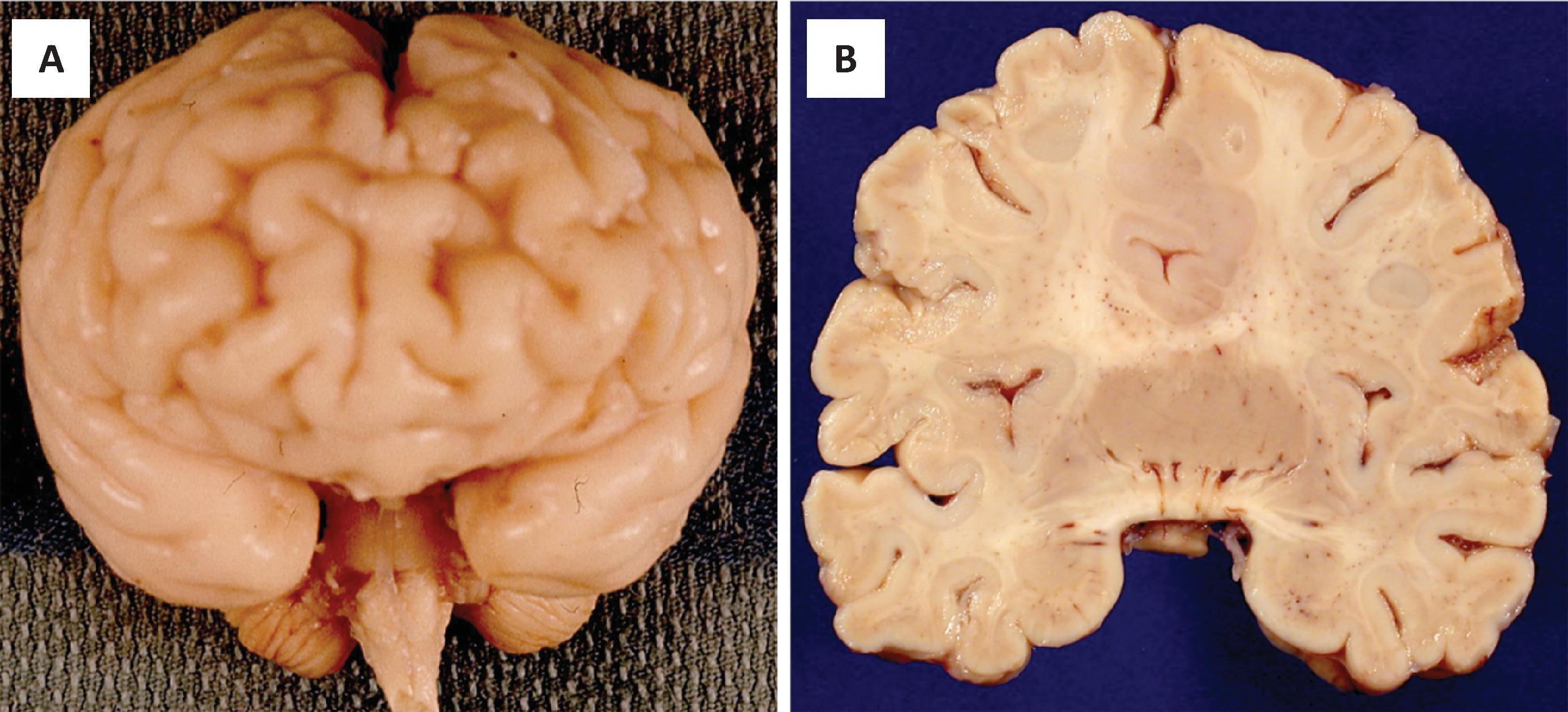
Lobar HPE is characterized by an interhemispheric fissure that divides virtually the entire brain with the exception of the most rostral and ventral regions of the frontal lobes. Beneath the apparent interhemispheric fissure, however, cerebral cortex may still cross the midline ( Fig. 4.20 ). There may be a segment of well-developed corpus callosum posteriorly where the cerebral hemispheres are truly separated. The lobes of the cerebral hemispheres may have a nearly normal pattern. Cross sections of the brain continue to show abnormal communication between the lateral ventricles with fusion of the basal ganglia rostrally. The thalami may have an enlarged massa intermedia or be completely fused.
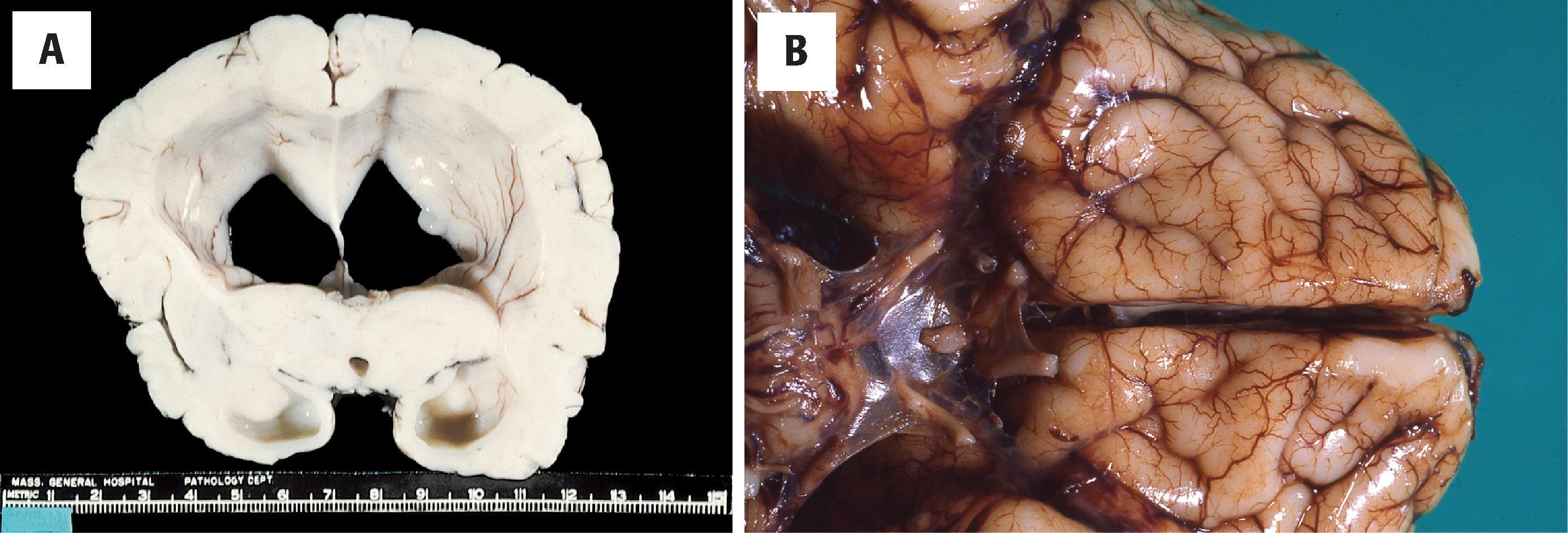
A relatively newly described variant is the middle interhemispheric variant or syntelencephaly, which shows failure of separation at the posterior frontal and parietal lobes, while the poles of the frontal and occipital lobes are well separated. The caudate nuclei and thalami are often incompletely separated.
Microscopically, the cytoarchitecture of the cerebral cortex may be normal, although displaced from its usual location. For example, the inferomedial aspect of the lip of the holosphere may contain hippocampal structures and entorhinal cortex. Some cases, however, may have significant disorganization of the cerebral cortex, possibly representing abnormal cell migration, secondary injury to the cerebral cortex, or an abnormality in connections into and out of the cerebral cortex. In alobar HPE, the basal ganglia may be microscopically unidentifiable or recognized only as a fused midline mass with disorganized cytoarchitecture. In less severe forms of HPE, the basal ganglia are present, although the head of the caudate may be fused and the septal region indistinct. The septum pellucidum is generally absent in all forms. Microscopically, the cerebellum may have focal cortical disorganization or heterotopia. Abnormalities of the brainstem are limited to hypoplastic or absent corticobulbar and corticospinal tracts or fused colliculi or peduncles at the midbrain level. Presumably in some instances, the implicated patterning molecules are shared between the forebrain and more caudal diencephalic and even midbrain structures. Depletion of certain GABAergic interneuron populations (those expressing nitric oxide synthase 1 (NOS1), neuropeptide Y (NPY), and somatostatin (SST) has been reported in HPE, which can be explained by abnormal development of the ganglionic eminences, part of the germinal matrix that produces GABAergic neurons.
As mentioned earlier, in most cases, the severity of facial abnormalities predicts the severity of underlying brain abnormalities. For example, the mildest craniofacial abnormality, such as a single midline maxillary incisor, might be associated with arhinencephaly, whereas at the other end of the spectrum, complete alobar HPE may be associated with cyclopia—a single orbit with one or partially divided eyes and a proboscis, an abnormally formed and placed nose, above the eye (see Fig. 4.15A ). In the semilobar forms, the facial abnormalities may include cebocephaly (elongated nose with a single nostril) and hypotelorism (abnormally close-together eyes) (see Fig. 4.15B ). Cases with less severe facial abnormalities that have no visible brain alterations are termed “HPE microforms” and are generally associated with normal or near normal cognitive development.
Absence of the olfactory bulbs and tracts and straight sulci of the orbitofrontal cortex in arhinencephaly, as well as in the more severe forms
Fusion of the inferior frontal cortex and occasionally the basal ganglia across the midline in lobar holoprosencephaly
Absence of the anterior interhemispheric fissure with continuity of the cerebral convolutions across the midline and thalamic or more extensive diencephalic fusion in semilobar holoprosencephaly
Complete absence of the interhemispheric fissure, septum pellucidum, and corpus callosum (holosphere) with fusion of the diencephalon and absence of the third ventricle; occasional fusion of the optic nerves (in cyclopia)
The inferomedial aspect of the lip of the holosphere may contain hippocampal structures and entorhinal cortex
Some cases have abnormalities in cerebral neocortical cytoarchitecture, as well as pia/subarachnoid glioneuronal heterotopia
Certain subpopulations of GABAergic interneurons may be depleted/reduced owing to hypoplastic germinal matrix
Fused diencephalic structures have disorganized neuronal cytoarchitecture
The brainstem and cerebellum are usually spared
Associated with cytogenetic/chromosomal alterations including trisomies 13 (up to 35% of all cases), less commonly trisomy 18 and triploidy
Can be a feature of a variety of different syndromes (25% of all holoprosencephaly cases)
Inherited or de-novo mutations in SHH or nodal/TGFbeta pathway genes
The gross appearance of alobar HPC is sufficiently distinctive that little can be confused with it. In contrast, isolated arhinencephaly may be overlooked, especially in immature brains in which the olfactory bulbs and tracts are soft and easily avulsed from the brain at the time of removal. Arhinencephaly is confirmed by evaluating the anterior fossa and demonstrating absence of the cribriform plate (see Fig. 4.20B ). In lobar HPC, the midline fusion of the thalamus or basal ganglia may be subtle and also overlooked on coronal section of the brain.
Surviving liveborn infants with the most severe variants (alobar HPC) generally have profound mental retardation and often suffer from seizures, which may be difficult to treat. They may have apneic spells and hypothalamic dysfunction with diabetes insipidus, poikilothermy, and inappropriate secretion of antidiuretic hormone. Their life span can be reduced. Patients with intermediate forms of HPC and pure arhinencephaly may have a normal life span and limited clinical deficits, such as cognitive delay and seizures.
Agenesis of the corpus callosum (whether partial or complete) ( Fig. 4.21 ; also see Fig. 4.17 ) is a relatively common malformation that may be isolated but is associated with other brain anomalies in more than 80 % of cases and with extra-CNS abnormalities in more than 60 %. Apart from a large number of genetic syndromes, agenesis of the corpus callosum is a frequent feature of inborn errors of metabolism such as organic acidurias, pyruvate dehydrogenase deficiency, Smith-Lemli-Opitz syndrome, and Zellweger syndrome. One well-known association is Aicardi syndrome (callosal agenesis or hypogenesis with or without interhemispheric cysts, focal cortical dysplasia or heterotopia, and chorioretinal lacunae) ( Fig. 4.22 ). Callosal agenesis is the most common structural abnormality in fetal alcohol syndrome and is sometimes associated with severe midline facial defects as well. Some cases of callosal agenesis are incidental findings at autopsy or on brain imaging in adults with no neurologic or developmental difficulties. Grossly and microscopically, the cingulate gyrus is absent. A white matter tract, called the bundle of Probst, is frequently seen running in the anterior-posterior direction just above the lateral ventricle where callosal fibers would normally fasciculate. In cases with partial callosal agenesis, the posterior part of the corpus callosum is more severely affected than the rostrum and genu.
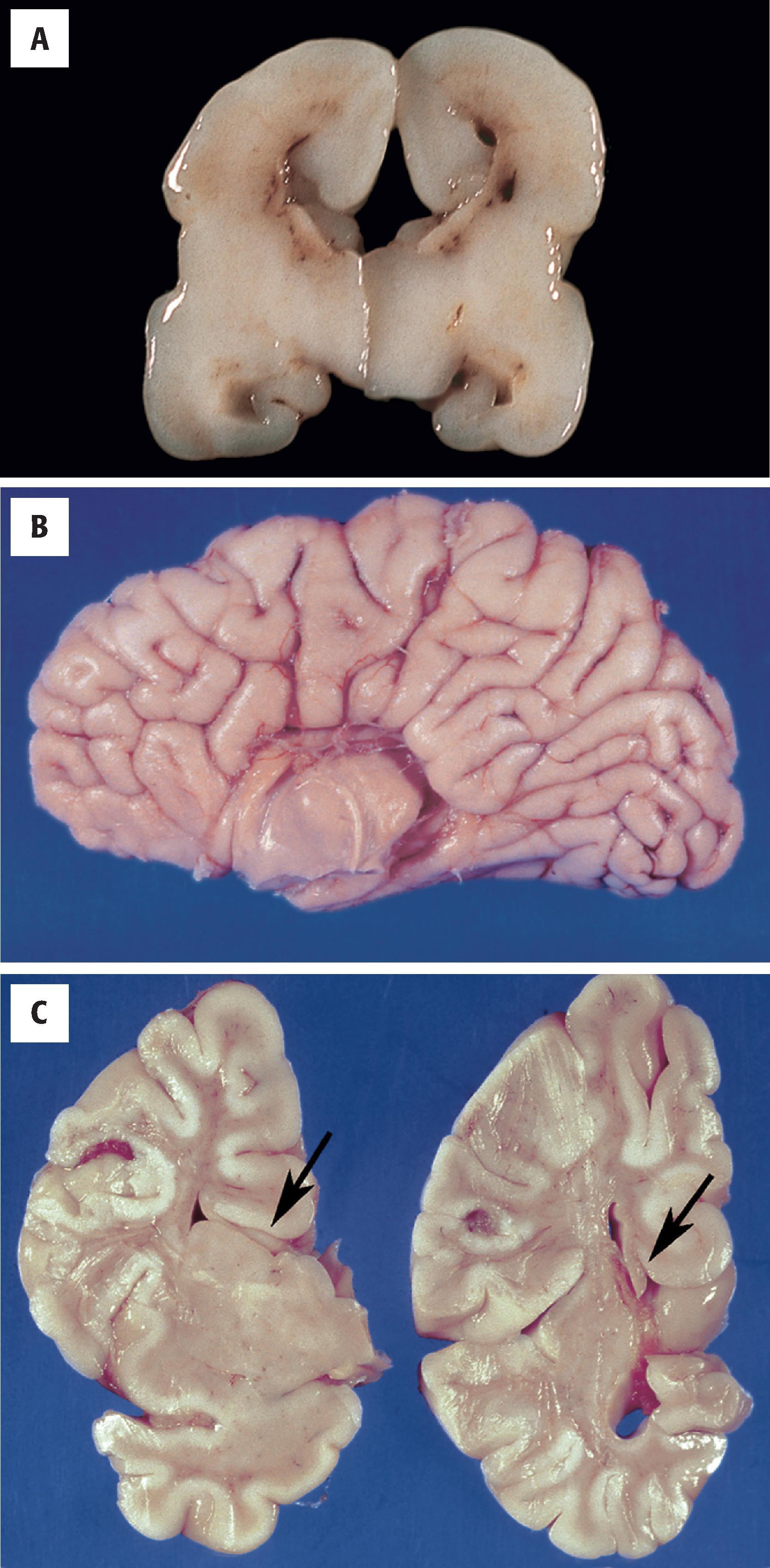
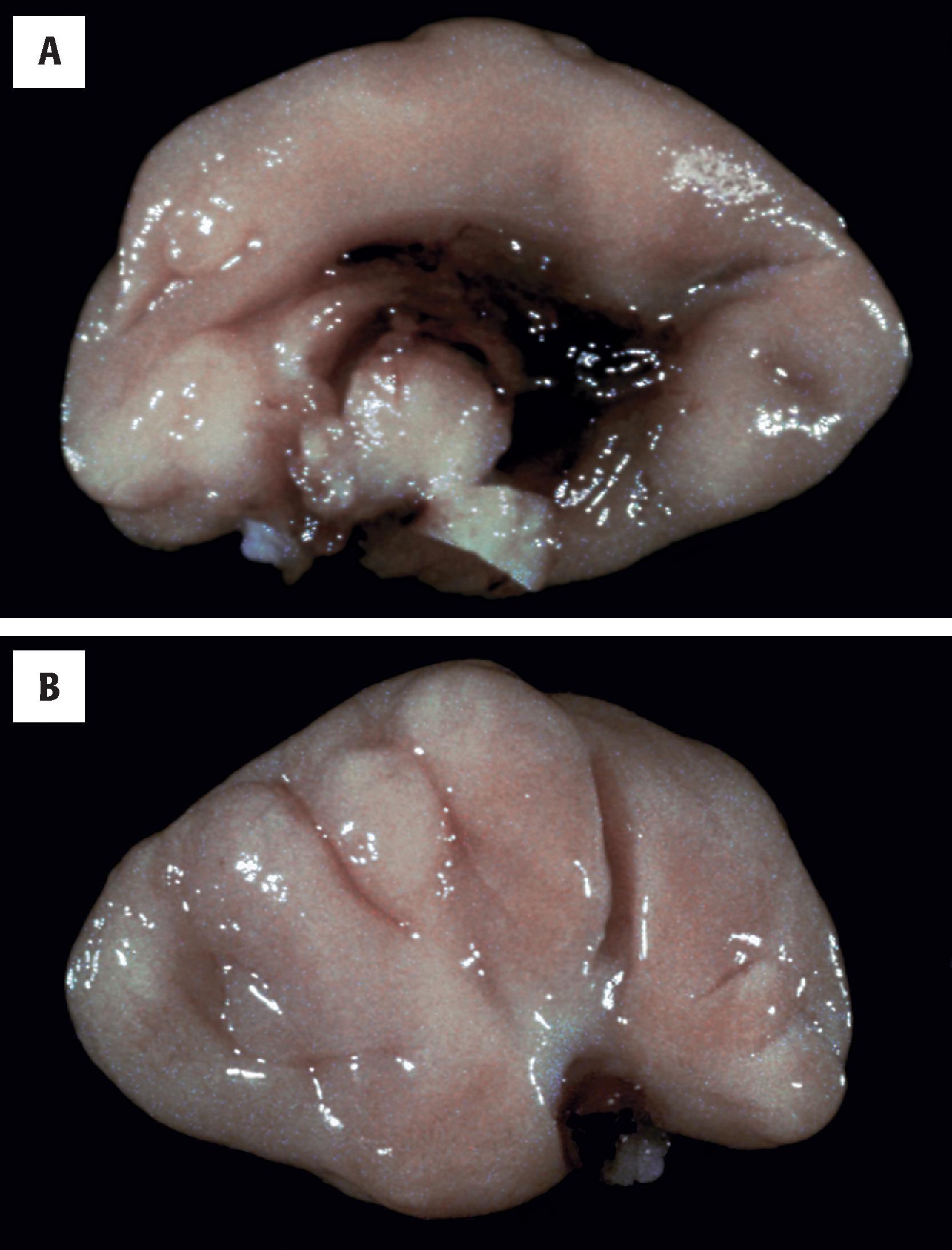
Absence of the septum pellucidum may occur as an isolated lesion or concurrent with anomalies of the optic system (septo-optic dysplasia) ( Fig. 4.23 ). The former may be asymptomatic or, along with two thirds of septo-optic dysplasia cases, result in hypothalamic-pituitary axis endocrine dysfunction. This endocrine dysfunction can lead to small stature and hypothyroidism. Visual disturbances are due to reduced acuity related to the clinically detectable optic nerve hypoplasia. Nystagmus is occasionally a feature.
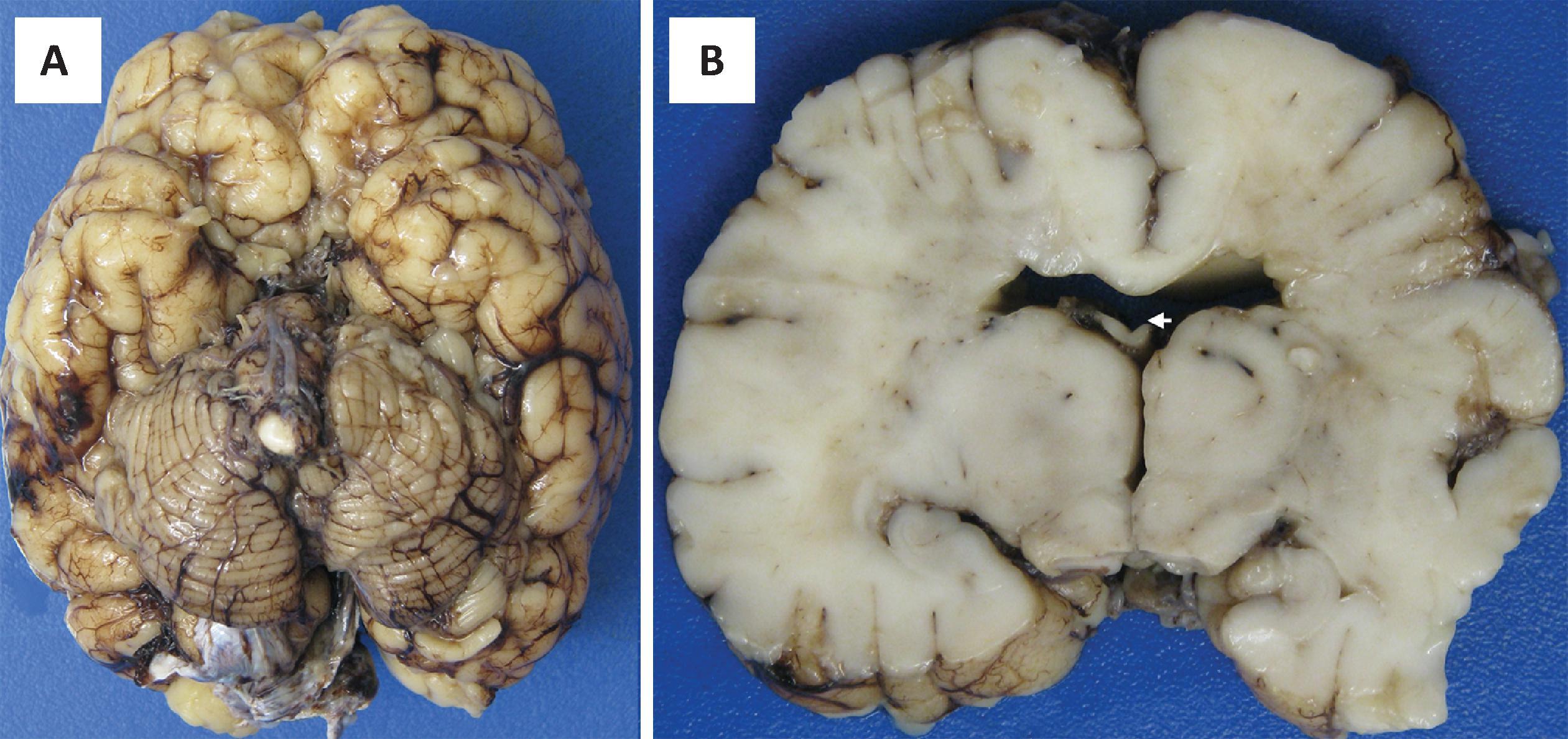
Cavum septi pellucidi ( Fig. 4.24 ) and cavum vergae are persistent separations between the rostral or caudal leaves of the septum, respectively, that usually fuse in the third trimester and certainly within the first year of life; these changes are generally incidental findings of no clinical or pathologic significance and are frequent enough to be regarded as normal variants.
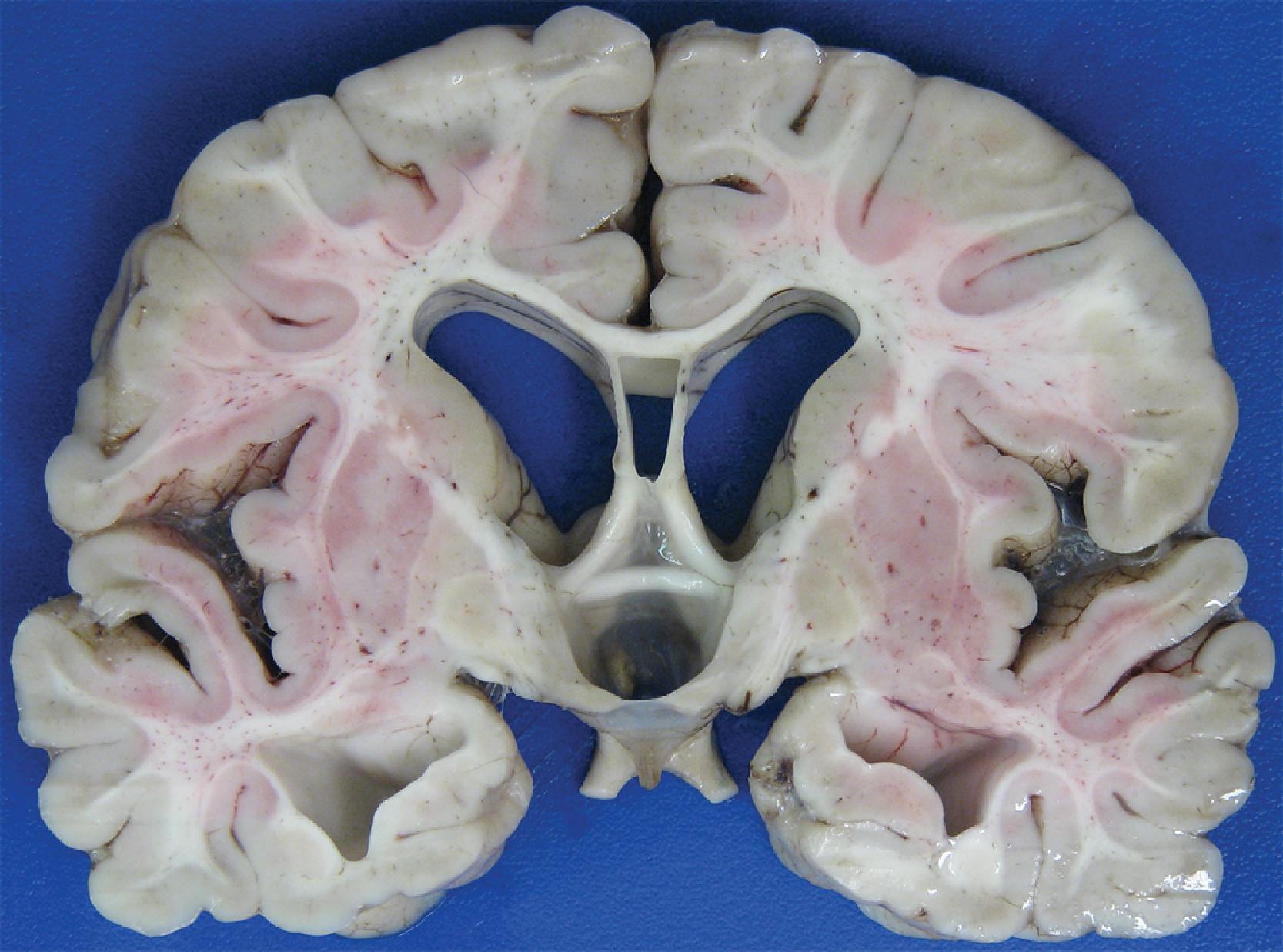
Because the corpus callosum develops rostral to caudally after the telencephalic commissural fibers cross over between the 11th and 20th weeks of gestation, agenesis of the corpus callosum can be seen even in early prenatal ultrasonograms as a “bat wing” configuration of the ventricles. Prenatal MRI can readily illustrate the ventricular configuration ( Fig. 4.25 ) and, often, any associated structural brain and facial anomalies. In neonates and adults, MRI in the sagittal and coronal planes best demonstrates the abnormalities. An interhemispheric cyst, when present, has imaging qualities similar to those of CSF, along with a wall that may cause a mass effect on the adjacent cerebral hemispheres.
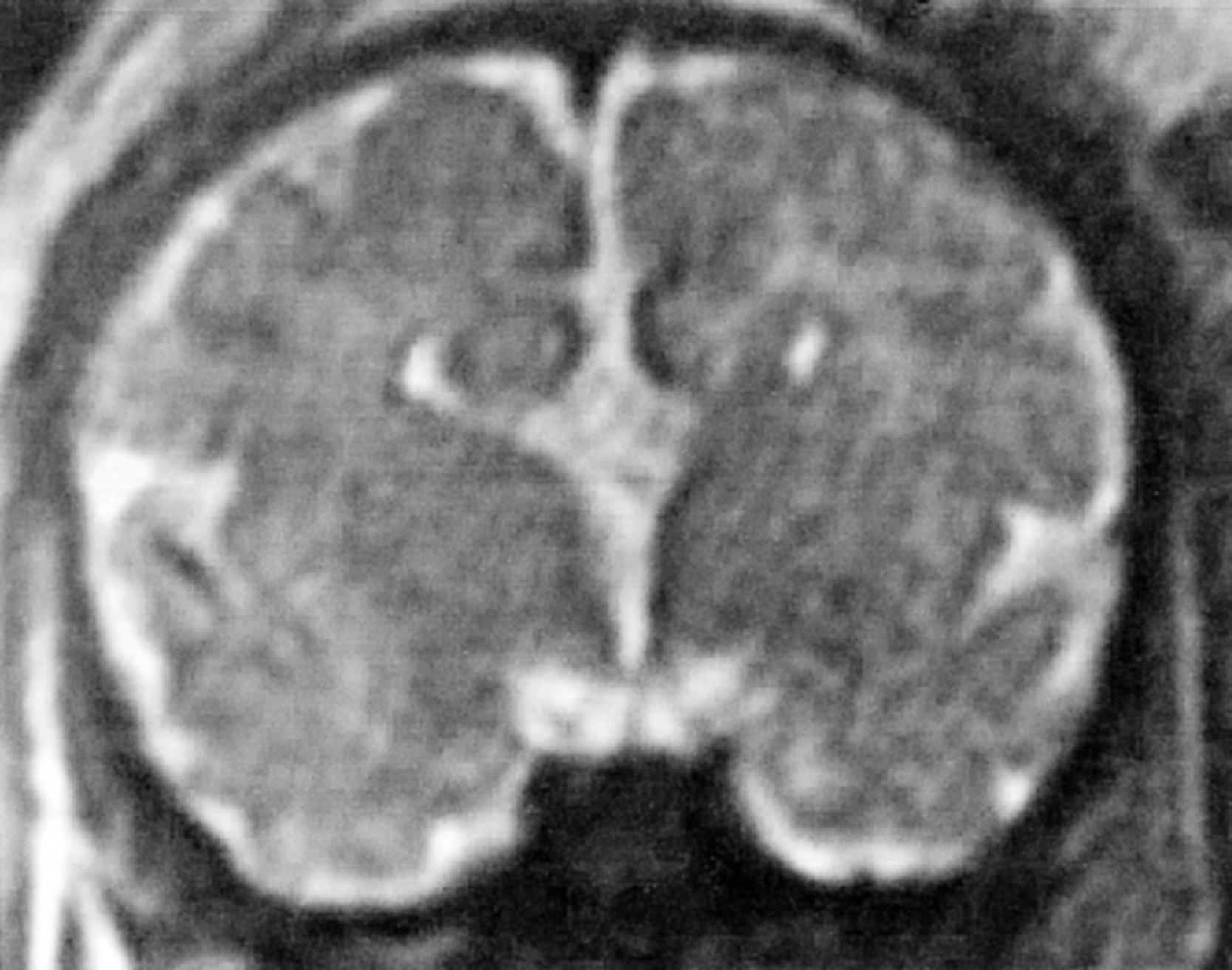
In septo-optic dysplasia, the optic canals may be small on CT or plain radiographs, although hypoplasia of the optic system may be difficult to resolve. The septum pellucidum is absent on CT or MRI, and the third ventricle and foramen of Monro may be markedly enlarged.
Agenesis of the corpus callosum refers to failure of white matter fibers to cross between hemispheres
Callosal absence may be complete or partial (involving only the posterior body and splenium)
Callosal agenesis occurs in isolation or as a component of numerous syndromes including fetal alcohol syndrome and the X-linked–dominant Aicardi syndrome
Abnormalities of the septum pellucidum include persistent separation of the rostral or caudal leaves of the septum (cavum septi pellucidi and cavum vergae, respectively)
Septo-optic dysplasia is defined by a triad of abnormalities in septum pellucidum (aplasia), optic nerve (aplasia/hypoplasia), and pituitary gland (hypoplasia–dysplasia)
Clinically heterogenous determined mainly by other associated CNS and systemic abnormalities
In isolation, callosal agenesis may be asymptomatic or show only subtle “split brain” perceptual deficits on specific testing
In Aicardi syndrome, the clinical picture is dominated by chorioretinopathy; mental retardation and infantile spasms are related to associated cortical dysplasia
In fetal alcohol syndrome, callosal agenesis is associated with, although not clearly responsible for, variable cognitive deficits
In callosal agenesis, on CT or MRI or even on prenatal ultrasound, the lateral ventricles have a vertical “bat wing” appearance
In some cases, agenesis of the corpus callosum is accompanied by midline cysts or lipomas, with typical fluid or fat signal characteristics on imaging
In septo-optic dysplasia, the optic canals may be narrow and the third and lateral ventricles have a rounded, open appearance with callosal thinning
In callosal agenesis, the prognosis is determined by the associated lesions
In septo-optic dysplasia, visual acuity is reduced; hypothalamic-pituitary endocrine dysfunction may be difficult to treat and can result in dwarfism and susceptibility to adrenal crisis and death
Cavum septi are not clinically significant
In total agenesis, the medial surface of the hemispheres shows secondary abnormalities characterized by absence of the pericallosal artery and replacement of the normal cingulate gyrus by perpendicular (often referred to as “radiating”) gyri (see Fig. 4.21 ). On coronal sections, no crossing white matter fibers are seen, and the lateral ventricles have a vertical (“bat wing”) orientation (see Fig. 4.21 ). This most severe form is due to total absence of callosal fibers or to their inability to cross the midline. In the latter circumstance, remnant callosal fibers form aberrant anteroposterior tracts known as Probst bundles that lie lateral to the cingulate gyri along the medial aspects of the lateral ventricles (see Fig. 4.21 ). Because the development of the corpus callosum proceeds from rostral to caudal, partial agenesis almost invariably involves the posterior portion (see Fig. 4.17 ). Occasionally, the fornices (hippocampal commissures) or anterior commissure appear hypertrophic. Whether total or partial, callosal agenesis may be accompanied by lipomas, cysts, vascular anomalies, or calcifications along the medial aspect of the hemispheres.
Cavum septi pellucidi and cavum vergae are seen in fetuses as developmentally normal midline cavities (the former is rostral, and the latter is caudal) lying between the two leaves of the septum (see Fig. 4.24 ). They tend to become obliterated toward term but persist postnatally in a minority of individuals. Complete agenesis of the septum pellucidum results in a “pseudo-monoventricle” because of marked expansion of the foramen of Monro and third ventricle.
Septo-optic dysplasia (see Fig. 4.23 ) is characterized by aplasia of septum pellucidum in combination with optic nerve and pituitary gland aplasia or hypoplasia. Genetic mutations and disruptive/destructive lesions have been implicated in the condition. Clinical symptoms include visual impairment or varying degrees and endocrine insufficiency.
When the callosum is absent, the pericallosal artery and cingulate gyrus are also absent and replaced by “radiating gyri”
Coronal sections of callosal agenesis show the vertical “bat wing” configuration of the lateral ventricles and a Probst bundle (noncrossing fibers aggregated in an anteroposteriorly directed fascicle at the mesial edge of the hemisphere)
Lipomas, cysts, or calcifications may be present in the interhemispheric fissure
In septo-optic dysplasia, absence of the septum pellucidum leads to a “pseudo-monoventricular” appearance with a rounded outline and a thin corpus callosum
Cavum septi pellucidi and cavum vergae are persistent separations between the anterior and posterior leaves of the septum, respectively
A Probst bundle consists of axons with variable myelination; otherwise, callosal agenesis has no specific microscopic features
In septo-optic dysplasia, the optic nerves and tracts may be hypoplastic, with reduced numbers of axons and hypomyelination, hypoplasia of the lateral geniculate nucleus, and disorganization of the hypothalamus
Callosal agenesis has diverse genetic causes and may be autosomal dominant, recessive, or X-linked
Several patients with features of Aicardi syndrome show translocations involving Xp22.3
Alterations in HEXS1, SOX2 and SOX3, FGFR1, FGF8, and PROKR2 have been implicated in septo-optic dysplasia
In fetal brain specimens, artifactual tearing of the callosum may mimic agenesis and the septum pellucidum is normally cavum (fusing near term or even after birth)
Closed head injury can cause tearing, separation, or fenestration of the septum pellucidum
In fetal specimens from the late second trimester, the corpus callosum is easily torn as an artifact of removing the brain; however, the ventricles should lack the slight expansion and vertical orientation of those in callosal agenesis. In addition, the presence of a cingulate sulcus, which is visible by week 19 of gestational age, should serve to indicate that the corpus callosum was present in situ. In any event, an artifactually torn corpus callosum should be obviously distinguishable from agenesis on microscopic examination.
Isolated absence of the septum pellucidum is nearly unheard of and should thus prompt careful examination to detect commonly associated abnormalities such as arhinencephaly or limited forms of holoprosencephaly, callosal agenesis, or abnormalities of the optic system. Occasionally, long-standing hydrocephalus may result in separation of the previously fused leaves of the septum pellucidum or in fenestration or loss of the septum pellucidum. Wide (>1 cm) separation of the two leaves, as well as fenestration, has been seen in boxers and is presumed to be a result of multiple blows to the head.
Since isolated callosal agenesis may be asymptomatic and only incidentally discovered, the other neuropathologic abnormalities associated with the lesion determine the clinical course.
Cerebral cortical developmental is an intricately orchestrated process under the control of intrinsic and extrinsic cues that can be derailed by a wide array of internal and external factors leading to a wide variety of anomalies. Cortical neurons and glia form in the periventricular region and then migrate to the developing cortex. Although the details of neurodevelopment are beyond the scope of this chapter, a brief description is essential to understanding defects of cortical development, particularly neuronal migrational defects.
Newly generated neurons form in the periventricular germinal layers and then migrate to the developing cortex using guiding mechanisms including internal motor machinery, secreted molecules such as Reelin, and physical interactions with extracellular matrix and the radial glial cells. Neurons in the cortex can be classified into two major groups, the glutamatergic excitatory neurons that constitute about 75 % of all neurons and the GABAergic interneurons that constitute the remaining 25 %. The development of these two neuronal populations is spatially and temporally distinct from the other. The glutamatergic/excitatory neurons are generated in the telencephalon periventricular germinal zones from where they migrate radially toward the pial surface using the radial glia as the scaffold for their migration ( Fig. 4.26 ). Once arriving at the superficial layer, the neurons detach from the radial glial processes and settle down, forming the cortical plate. The GABAergic inhibitory interneurons, on the other hand, are largely generated in the ganglionic eminences, which are part of the germinal matrix layer overlying the future caudate nucleus. From there these cells migrate tangentially to the cerebral cortex (see Fig. 4.26 ).
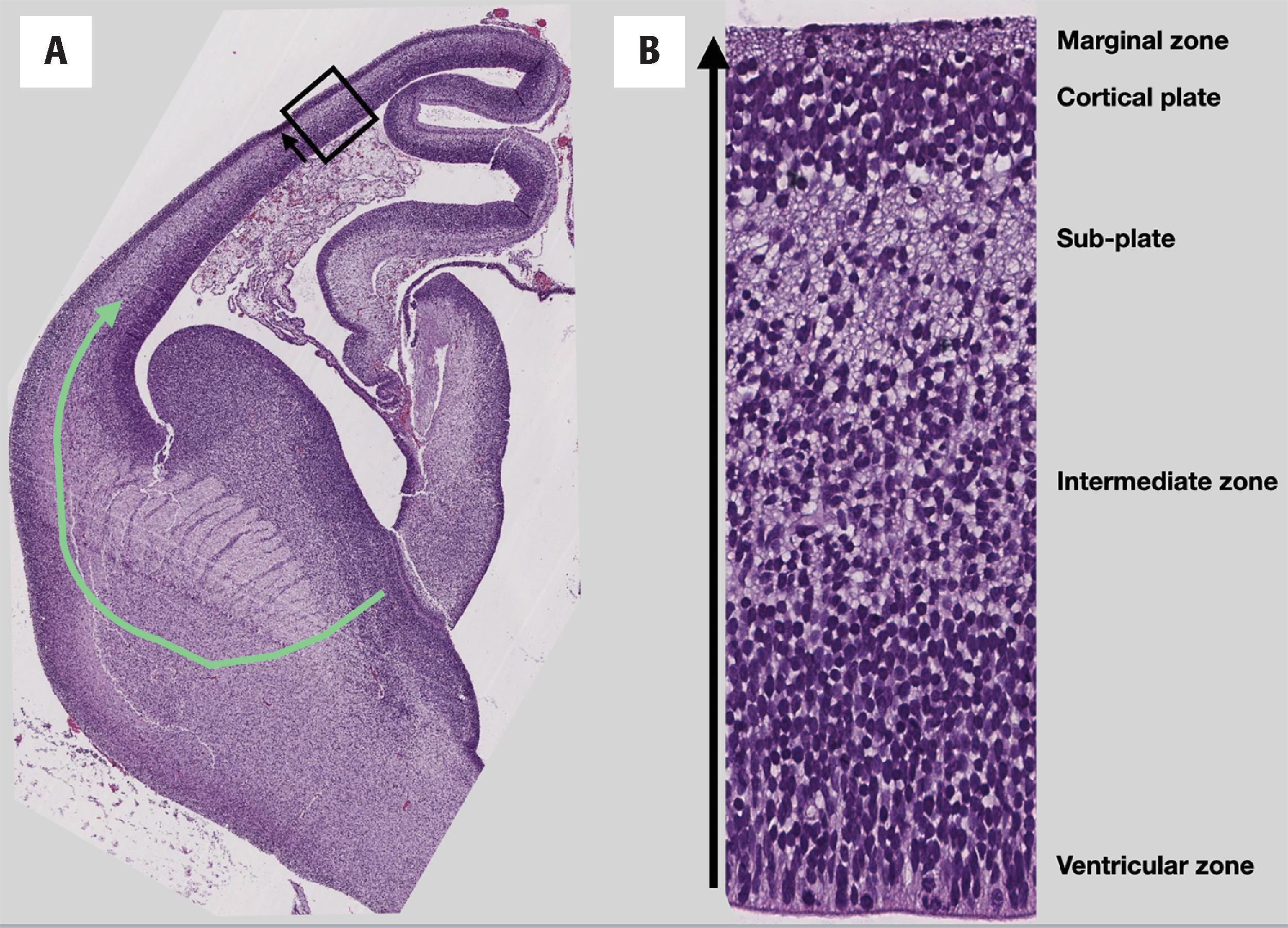
Disturbances of these two modes of neuronal migration can cause abnormalities of cortical development. Migrational defects include (1) failure to migrate or too little migration (glioneuronal white matter heterotopia) or (2) too much migration (leptomeningeal heterotopia). Cortical gyral abnormalities can be divided into (1) too few/simplified gyri (pachygyria) and (2) virtually complete absence (lissencephalies) or (3) too small and too numerous (polymicrogyria). The balance of excitatory and inhibitory neurons has been implicated in synaptic excitation and inhibition (E/I) imbalance, which can result in epilepsy. Lastly, although too subtle to be observed by routine histologic techniques, neuropsychiatric disorders such as autism spectrum disorders and schizophrenia may involve altered neuronal migration.
Glioneuronal heterotopia represents the presence of gray matter at abnormal positions and can encompass a wide spectrum of locations and sizes. It may occur as focal, isolated anomalies found incidentally on imaging or at autopsy or may have clinical manifestations as described earlier.
Broadly speaking, glioneuronal heterotopia can be divided into (1) leptomeningeal, (2) subcortical-band, and (3) periventricular types. The migration of neurons and precursor cells following their production in the ventricular/subventricular zone involves a complex series of steps. Cortical heterotopias can be understood conceptually as interruption of these processes. Periventricular heterotopia is hence a defect in the onset of migration out of the precursor field (germinal matrix or ventricular zone/subventricular zone) and can be conceptualized as a defect resulting from too little migration . Subcortical-band heterotopia is a defect in continuing migration through the future white matter (the intermediate zone) and can be conceptualized as neuronal migration that stopped short of reaching the target . Finally, leptomeningeal heterotopia is an aberration in normal stopping at the marginal zone and pial-glial barrier and best conceptualized as too much migration.
Histologically, all heterotopias can contain both neurons and glia (pyramidal neurons and GABAergic interneurons). The overlying or underlying cortex frequently shows dysplastic changes, including in subcortical band heterotopia in which the overlying cortex is often pachygyric.
Leptomeningeal heterotopia consists of focal or diffuse collections of glioneuronal tissue within the leptomeninges ( Fig. 4.27 ). Although not always obvious, leptomeningeal heterotopia is generally contiguous with the underlying brain parenchyma. Leptomeningeal heterotopia is usually associated with other abnormalities of CNS development including holoprosencephaly and type II lissencephaly (discussed later). Small leptomeningeal heterotopias are not identifiable on routine imaging studies, so a high degree of suspicion is warranted.
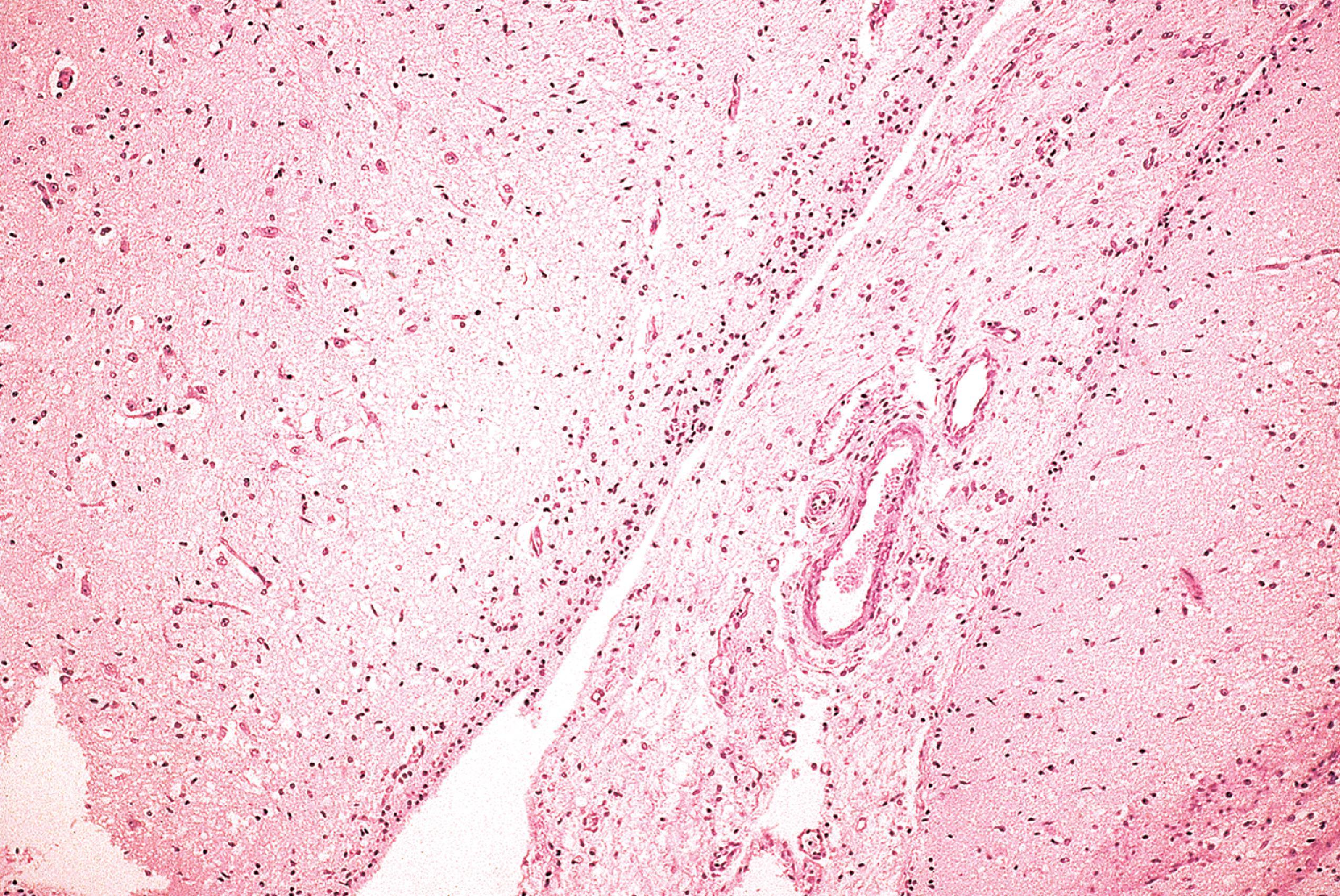
Glioneuronal heterotopia are most commonly present in the periventricular location and are also called periventricular nodular heterotopia (PNH). PNH are complex abnormalities involving additional abnormalities in the cortex. Unilateral, bilateral with both symmetric, and asymmetric patterns can be seen. The location of the nodules is variable ranging from a subependymal location ( Figs. 4.28 and 4.29 ) that distorts the lateral ventricles forming visible bumps (see Fig. 4.28 ) to a subcortical location that sometimes merge with the cortex to give a pachygyric appearance ( Fig. 4.30 ).
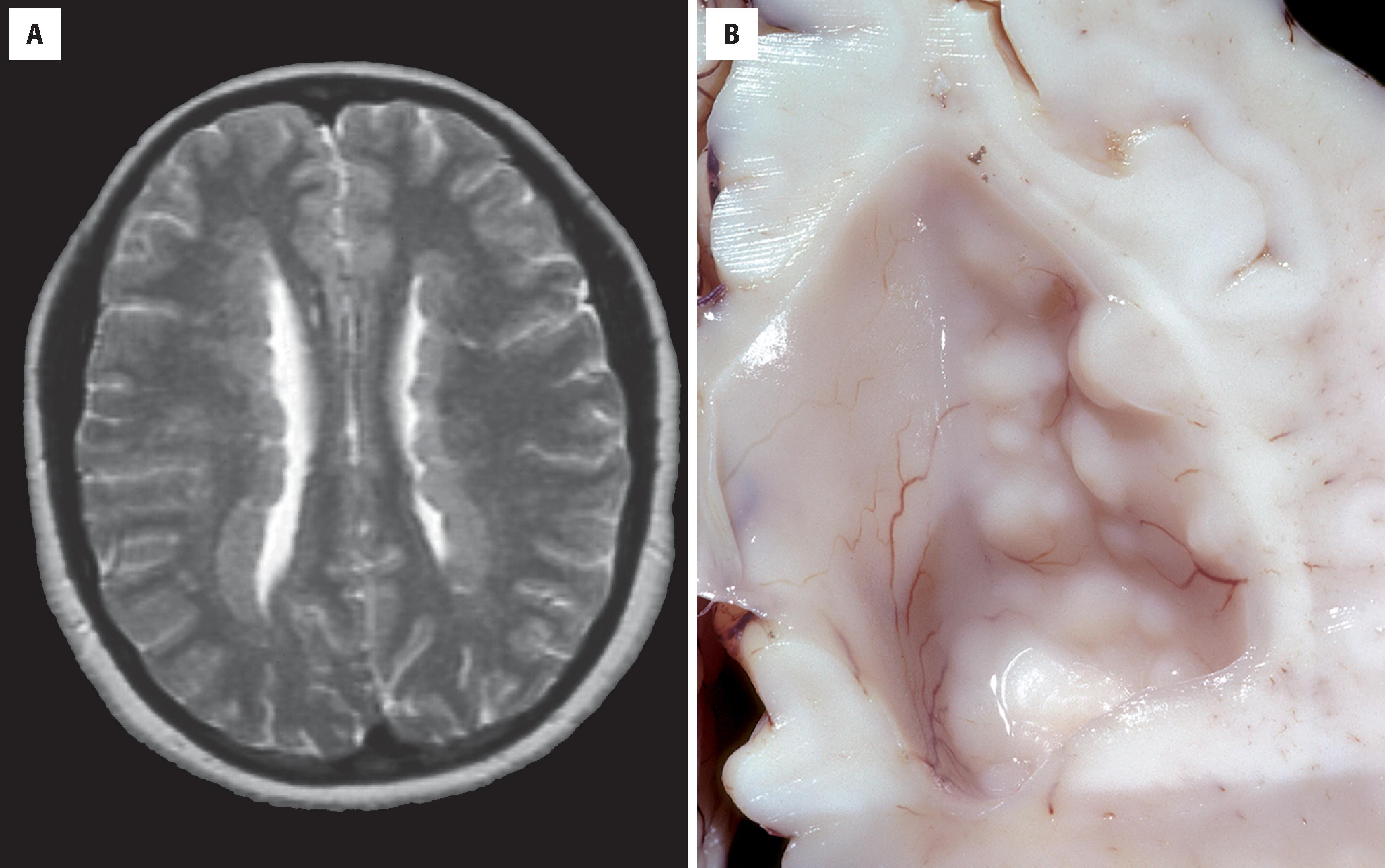
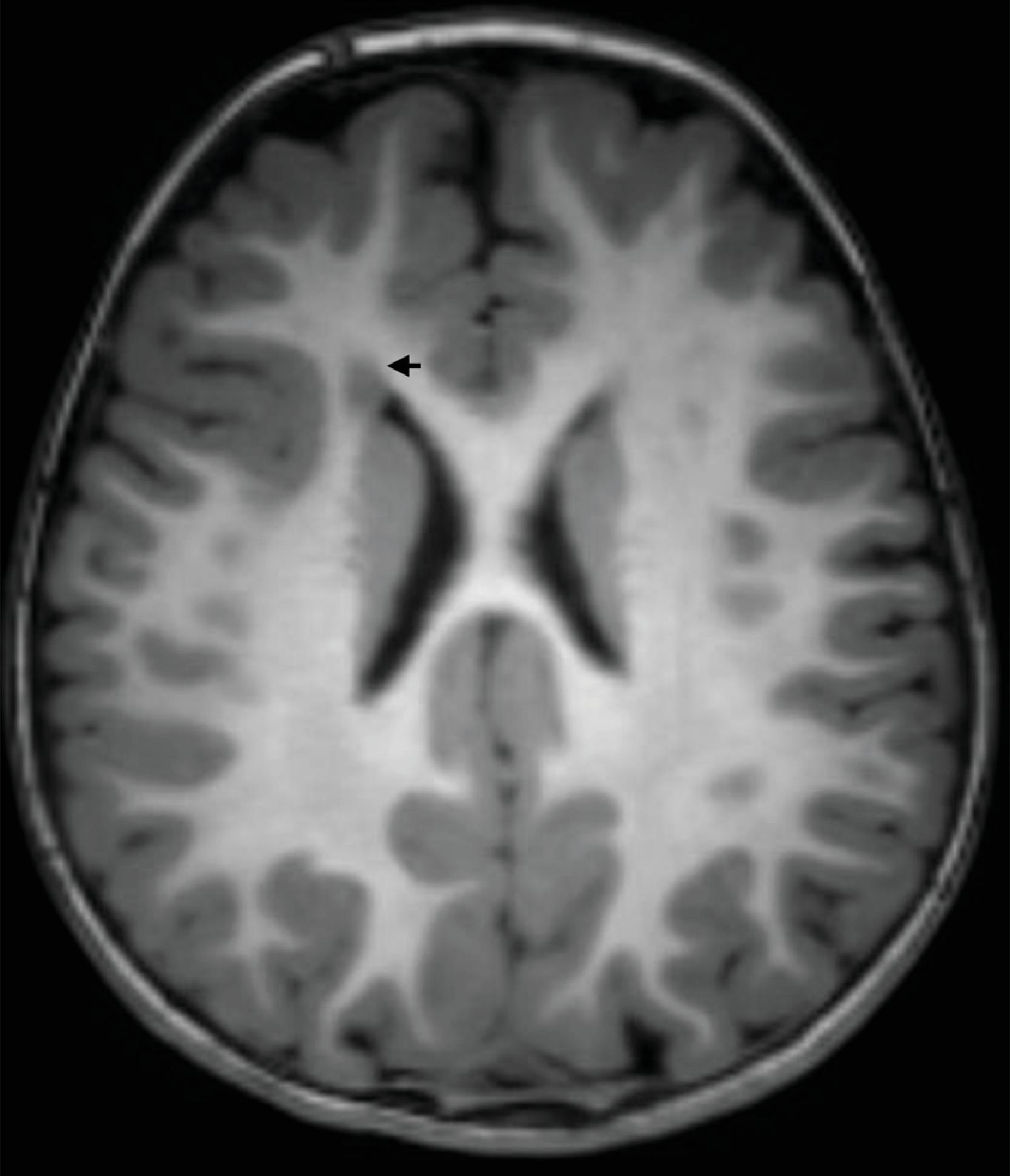
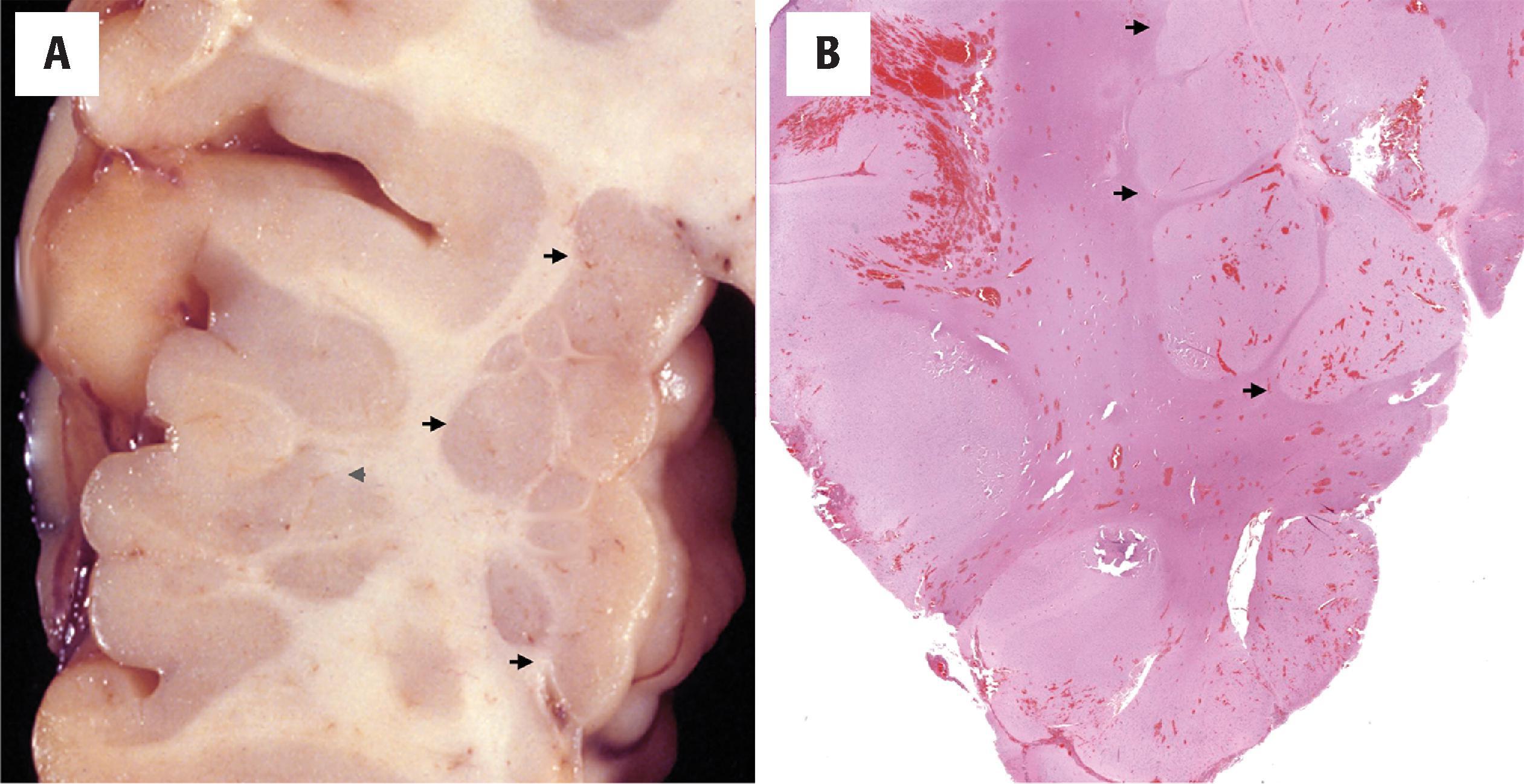
A number of genetic syndromes can show periventricular heterotopia. The best understood of these is the bilateral symmetrical PNH, which is frequently associated with FLNA gene mutations. FLNA (also referred to as FLN1 ) located on the X chromosome encodes Filamin-A, an actin binding protein that appears to play a role in cell-to-cell interactions and in cell migration. Absence of both copies in affected males leads to embryonic lethality, while females show PNH and clinically manifest seizures or mental retardation or both. X-inactivation in a random subset of developing neurons explains why some neurons fail to migrate, whereas other neurons migrate properly. Additional genes responsible for PNH have been found in recent years to be responsible for rare familial cases of PNH. These include ARFGET2, FAT4 (FAT atypical cadherin 4) and its ligand DCHS1, ERMARD, and others.
Not all cases of PNH can be attributed to genetic mutations, as PNH is not infrequently associated with destructive lesions of vascular/ischemic etiology such as schizencephaly or polymicrogyria. In these cases, ischemia to a limited region of the germinal neuroepithelium is the putative cause leading to nodular heterotopia.
Other than somatic mutations, mosaicism may explain many cases of heterotopias. A recent study showed that close to one-fifth of patients had identifiable mutations when deep sequencing was applied to surgically resected heterotopic neural tissues.
Clinically, PNH may be asymptomatic, may appear as incidental findings on imaging or at autopsy, or may be manifested as seizures, usually with onset in childhood. Focal, multifocal, or generalized seizures can occur; infantile spasms and the Lennox-Gastaut syndrome are seen with more extensive heterotopic gray matter deposits. Motor and cognitive deficits may coexist. The least severe clinical manifestations are seen when the abnormality is localized to the periventricular region, in contrast to those associated with subcortical band heterotopia.
Subcortical-band heterotopia can present as a solid band of heterotopic tissue in the white matter ( Figs. 4.31 and 4.32 ) or as numerous contiguous islands or nodules. It can be focal or diffuse and unilateral or bilateral. Subcortical-band heterotopia is considered part of the morphologic spectrum of lissencephaly. Well-known causative factors include mutations in DCX and LIS1 (described in more detail in the section on lissencephaly).
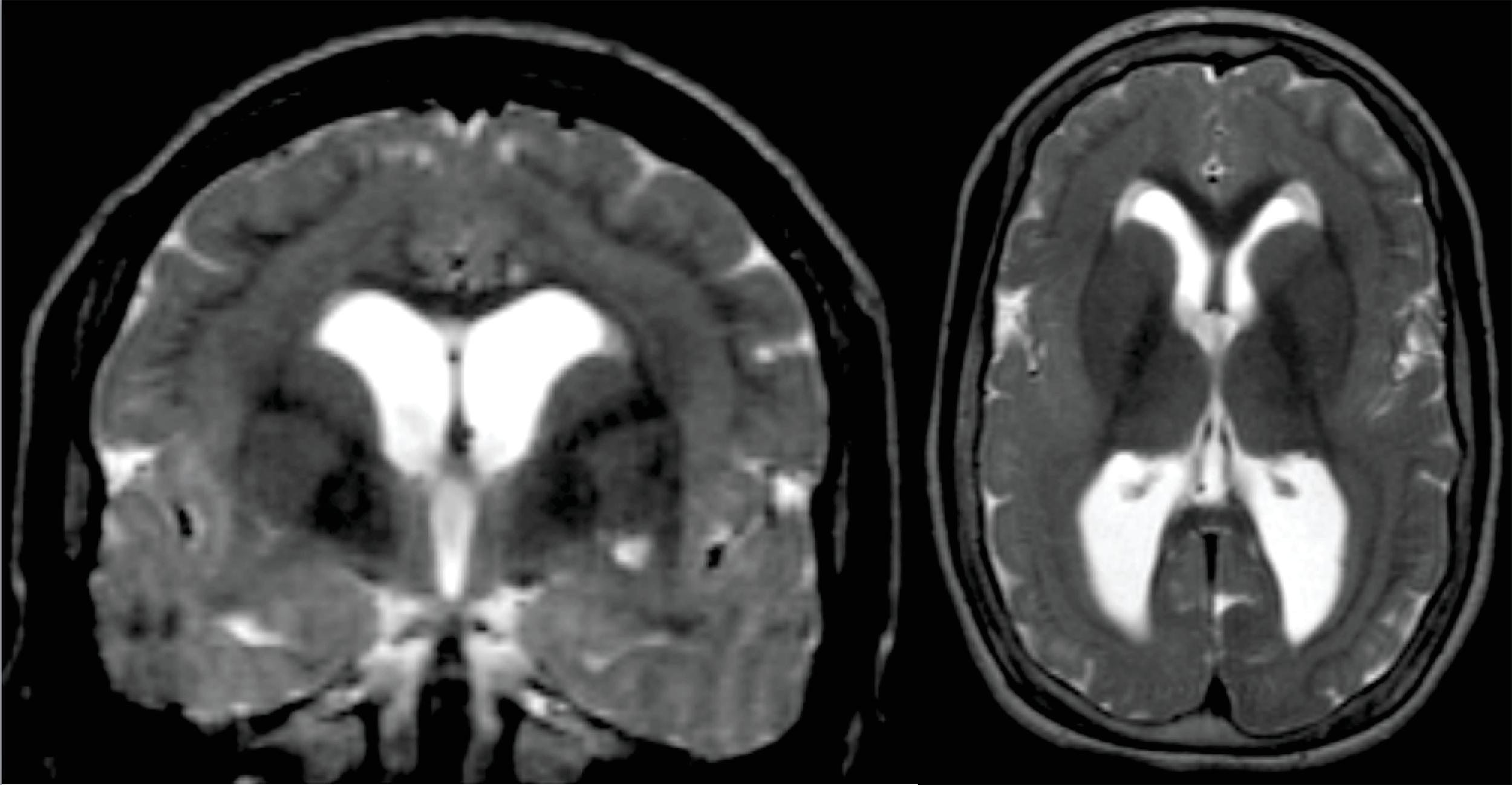
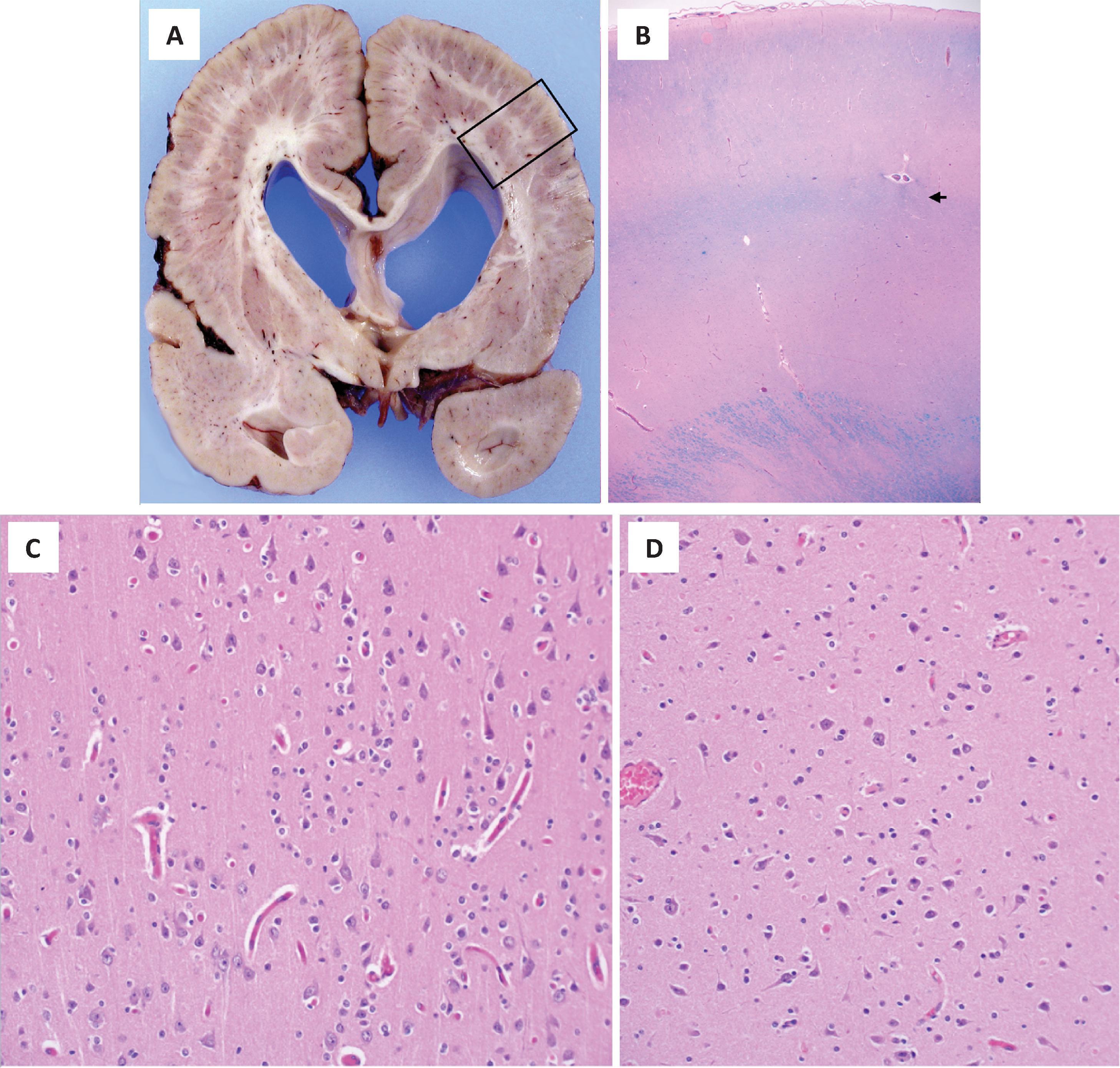
Purkinje and granule cell heterotopia are another type of neuronal migration defect that may be extensive or, more commonly, limited and of no clinical significance ( Fig. 4.33 ).
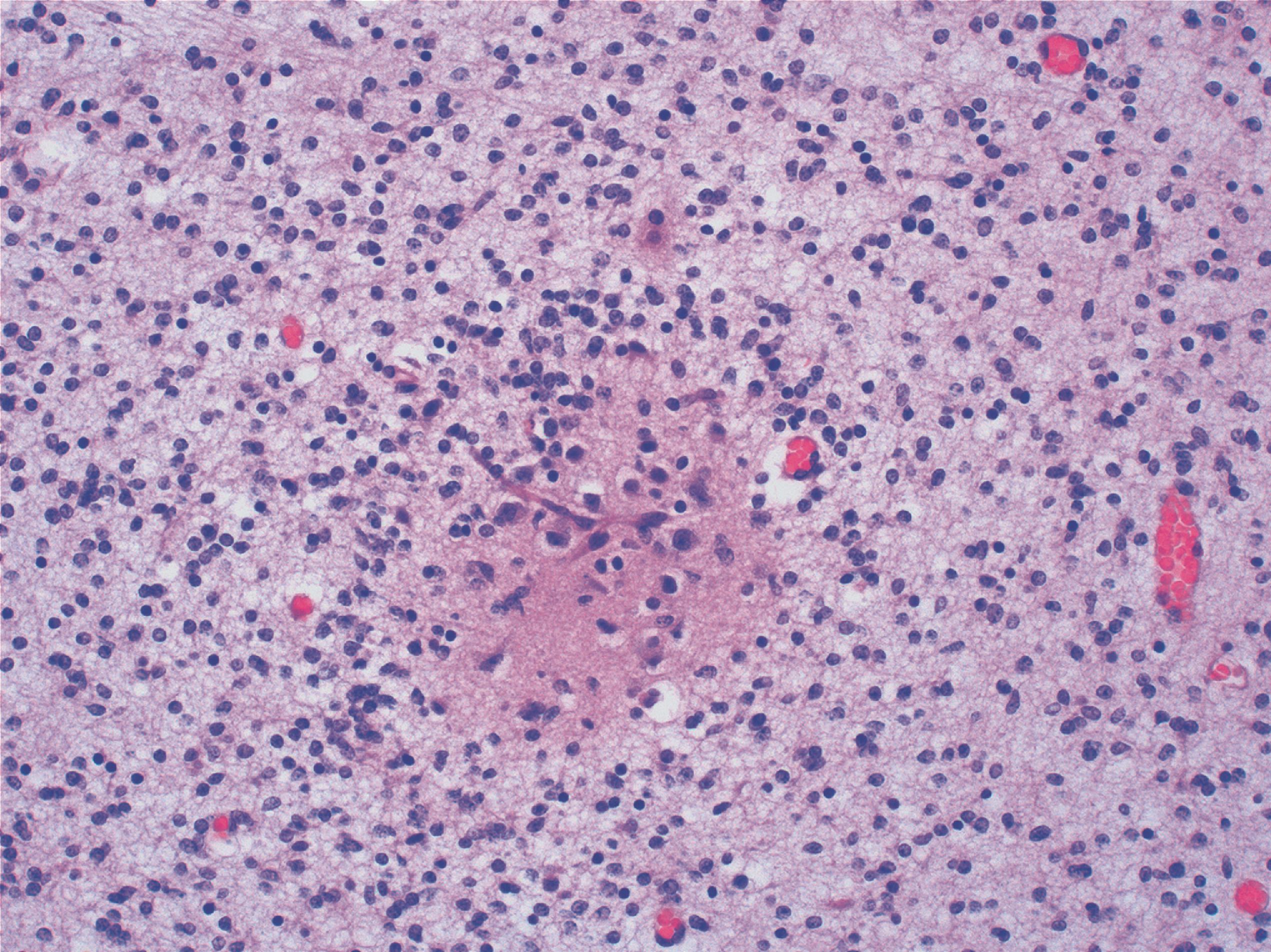
Lissencephaly, literally “smooth brain,” is characterized by a thick cortex with reduced or absent cerebral convolutions. The spectrum of lissencephaly ranges from a completely smooth agyria ( Figs. 4.34 and 4.35 ) to areas of thick broad gyri (pachygyria) ( Fig. 4.36 ), often seen in different regions within the same brain. Subcortical band heterotopia, defined as longitudinal bands of gray matter located deep in the cerebral cortex and separated from it by a thin layer of white matter (see Figs. 4.31 and 4.32 ), is the third pattern of abnormality that is part of the lissencephaly spectrum. Although interchangeable, lissencephaly is sometimes used to refer to a diffuse bilateral abnormality (see Figs. 4.34 and 4.35 ) and pachygyria represents a focal or multifocal abnormality with similar gross and microscopic features (see Fig. 4.36 ).

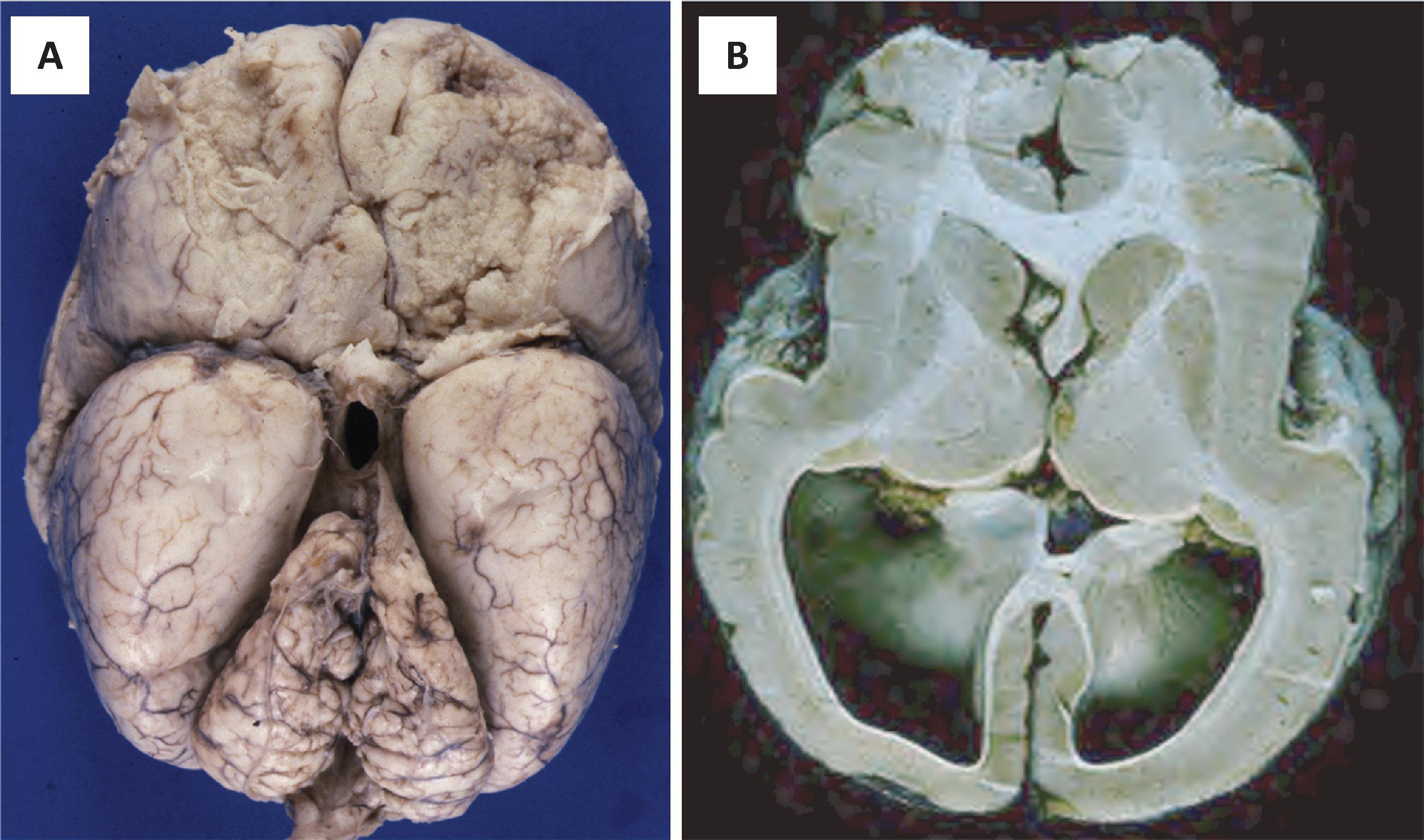
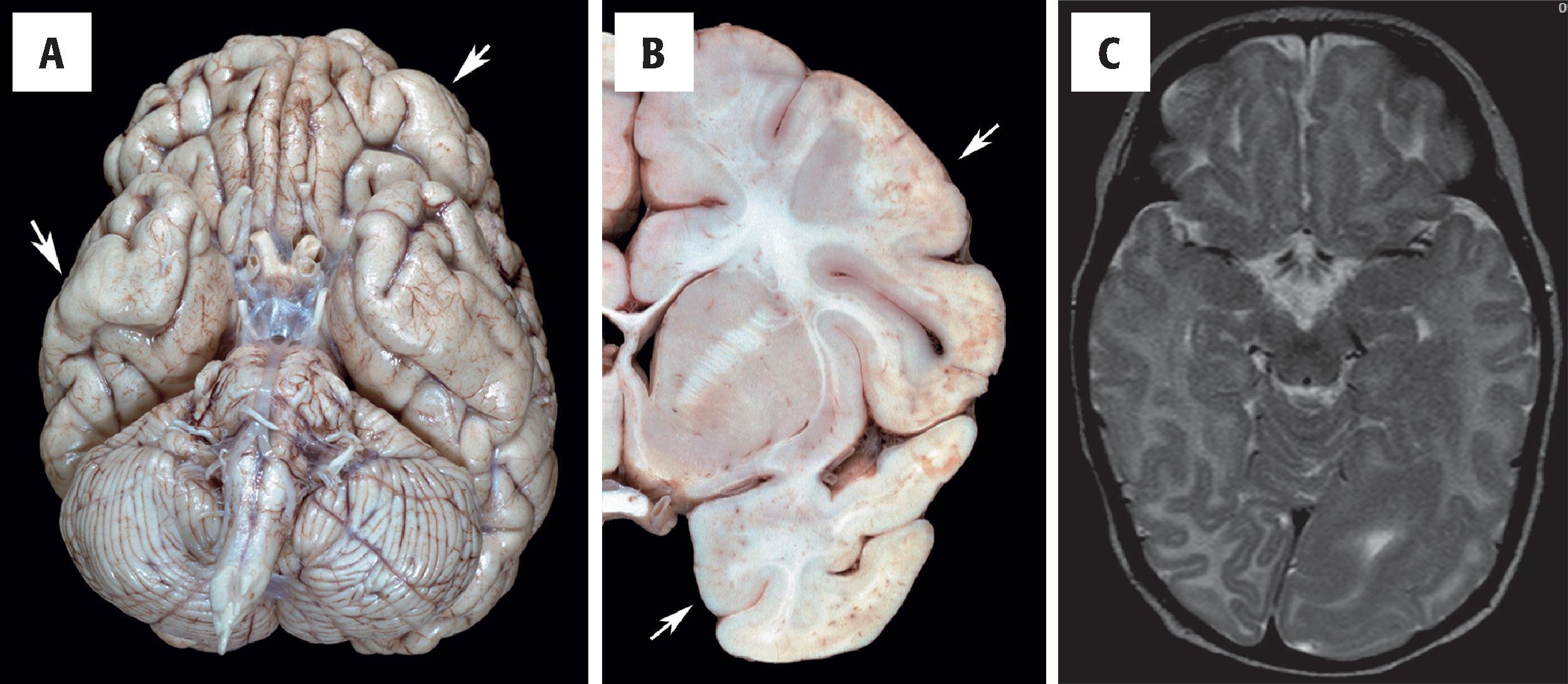
Lissencephalies are divided into two distinct pathologic forms: classic (type I) and cobblestone (type II). Both types share a thickened cortex with reduction of gyration. Type II additionally shows an uneven appearance resembling cobblestones and features abnormalities of muscle and eyes as part of a “cerebro-oculo-muscular syndrome.”
Most lissencephaly cases present as part of a clinical syndrome, each with a stereotypic combination of brain abnormalities with involvement of other organs.
Mutations in an ever-growing list of genes are implicated in lissencephaly and subcortical band heterotopia (SBH) including ARX, CDK5, DCX, KIF2A, KIF5C, LIS1, RELN, various tubulin genes, and VLDLR . Most of these genes code for microtubule structural proteins (tubulin) or microtubule-associated proteins (MAPs), which are part of the motor machinery of the cell. Guiding molecules involved in reelin signaling also account for some of the genes. Overall, mutations in one of the above mentioned genes account for about 80 % of the cases of lissencephaly and SBH. About 75 % of cases with an identifiable mutation show alterations in two genes: LIS1 (also known as PAFAH1B1 ), which has been mapped to chromosome 17p13.3 and doublecortin (DCX) at Xq22.3-q23. Most cases are sporadic; however, familial cases have been reported. Clinically, type I lissencephaly manifests in the first few weeks to months of life with severe psychomotor retardation and infantile spasms.
LIS1 encodes PAFAH1B1 (platelet-activating factor acetylhydrolase-1, β1-subunit) which is involved in cytoskeletal dynamics and is required for neuronal migration. Mutations in LIS1 lead to isolated lissencephaly, while microdeletions of 17p.13.3 (which includes the gene YWHA E in addition to LIS1 ) cause Miller-Dieker syndrome (MDS). In addition to brain abnormalities, patients with MDS also have cardiac and genital anomalies and characteristic facies.
Doublecortin (DCX) is associated with lissencephaly with SBH—also called ‘‘double cortex.” Females with DCX mutations have an apparent normal cortical ribbon, a band of white matter, and then a band of gray matter, with the remaining white matter underlying this second band of gray matter (“double cortex”). In contrast, males with doublecortin DCX/XLIS mutations show classic lissencephaly with only rare cases showing SBH. Although most cases of SBH are associated with DCX, cases with LIS1 have also been reported.
DCX is a microtubule-associated protein required for normal cell migration. The normal cortical ribbon is thought to arise from cells harboring the mutant allele that undergo inactivation of the X chromosome and migrate normally to the cortical plate. Cells in which the normal allele is inactivated express the mutant gene, thereby failing to completely migrate, and form a band of gray matter within the cerebral white matter.
A variant of lissencephaly in the agyria-pachygyria spectrum has been reported as caused by mutations in α-tubulin complex (TUBA1A), a component of the microtubulin complex that is required for cell migration. Like other microtubulin-binding proteins, such as doublecortin and kinesin KIF1A, mutations in microtubule binding heterodimers would affect the migration of neuronal progenitor cells. RELN, another gene associated with lissencephaly, encodes for a secreted protein that serves as a signaling molecule for migratory neurons. Mutation in RELN leads to an inverted cortex in mice with more recently born neurons inhabiting the lower cortical layers instead of the opposite pattern in the normal cortex.
LIS1 and DCX show characteristic patterns of cerebral involvement that help predict the underlying gene mutation based on imaging/gross examination. LIS1 affects the parietal and occipital regions preferentially (posterior > anterior gradient), while DCX lissencephaly preferentially affects the anterior or frontal cortex (anterior > posterior gradient or anterior = posterior pattern). There is less strict genotype-phenotype correlation for other lissencephaly-associated genes.
Type II (“cobblestone”) lissencephaly is a group of syndromes that is genetically distinct from type I lissencephaly. Virtually all cases of type II lissencephaly are associated with congenital muscular dystrophy and often have ocular and cerebellar abnormalities. Type II lissencephaly is also different from type I in its pathogenesis with overmigration playing a role. In normal development, neurons migrate out and populate the cortical plate in an inside to-outside fashion so that the earliest formed neurons populate the deeper layers and the newly formed neurons populate the more superficial layers. In type II lissencephaly, the initial migration to the cortical plate may be normal, but subsequent neurons migrate past the cortical plate and into the leptomeninges, giving rise to a bumpy surface likely due to defects in the integrity of the pial-glial barrier. Various syndromes with lissencephaly type II are known, all with genetic defects leading to defective posttranslational processing of α-dystroglycan, a heavily glycosylated peripheral membrane component of the dystrophin-associated glycoprotein complex. Type II (“cobblestone”) lissencephalies can therefore be conceptualized as glycosylation defects.
Clinical signs and symptoms in most cases of lissencephaly type II cluster into distinct syndromes. The most common is the Walker-Warburg syndrome (WWS), caused by an autosomal recessive mutation in the gene for O -mannosyltransferase on 9q. Typically, the entire brain is lissencephalic with sparing of the medial temporal cortex. Also called cerebro-ocular dysplasia muscular dystrophy syndrome, clinical features include ocular system abnormalities and muscular dystrophy in addition to lissencephaly. Ocular abnormalities include retinal dysplasia, anterior chamber malformations, cataracts, choroidal colobomas, optic nerve hypoplasia, and microphthalmos. Patients show profound hypotonia at birth. Serum creatine kinase levels are elevated as a result of the muscular dystrophy. Contractures may be present at birth (arthrogryposis multiplex congenita) or develop later.
Brain malformation in WWS can include agenesis of the corpus callosum, hydrocephalus, cerebellar hypoplasia (sometimes Dandy-Walker malformation), occipital encephalocele, or any combination of these findings. WWS is associated with a high incidence of neonatal lethality.
While WWS has worldwide prevalence (albeit rare), other lissencephaly type II syndromes are seen in certain geographic locations or ethnic groups. These include Fukuyama congenital muscular dystrophy (FCMD), seen almost exclusively in Japan, and the Finnish “muscle-eye-brain” (MEB) disease of Santavuori, which is seen primarily in Finland. FCMD is quite common in Japan, where it is second only to Duchenne’s muscular dystrophy as a cause of progressive motor disability in childhood. Like WWS, patients do demonstrate psychomotor retardation and progressive muscular weakness and contractures; however, eye involvement is milder in comparison with WWS and is usually myopia and optic atrophy. Mutations in fukutin-related protein have been associated with the condition. Similarly, MEB disease of Santavuori resembles WWS in many respects with early-onset motor symptoms including hypotonia, spasticity, and contractures; cognitive symptoms including seizures; and visual symptom abnormalities including retinal degeneration and optic atrophy accompanied by eventual development of cataracts. Mutations in POMGnT1, a glycosyltransferase, have been associated with MEB disease of Santavuori. As mentioned earlier, POMT1, fukutin, and POMGnT1 involved in WWS, FCMD, and MEB all lead to abnormal glycosylation of the α-dystroglycan.
In addition to these syndromes, mutations in at least a dozen other genes have been associated with the type II lissencephaly spectrum.
As described earlier, the lissencephaly spectrum includes agyria, pachygyria, and subcortical band heterotopia. Agyria is the almost complete absence of gyri, technically defined as cortical regions with sulci > 3 cm apart. Pachygyria is defined as abnormally wide gyri with sulci 1.5–3 cm apart, and subcortical band heterotopia is defined as longitudinal bands of gray matter located deep in the cerebral cortex and separated from it by a thin layer of white matter.
In lissencephaly type I, the affected cortex is extremely thick and overlies cerebral white matter, which is proportionally diminished in volume. Normally, the cerebral cortical architecture is made up of six layers and represents about a tenth of the total cerebral hemisphere thickness. In classic lissencephaly, in contrast, the cerebral cortex-to-white matter ratio is 4:1. The cortical mantle consists of four abnormal layers (see Fig. 4.32 ): Layer I is relatively unremarkable; layer II is a band of pyramidal neurons; and layer III contains numerous myelinated fibers and fewer neurons. Layer III overlies a thick layer of disorganized neurons in layer IV. The underlying white matter has decreased volume and occasional single neurons or small heterotopia. Although other regions of the brain are usually spared in classic lissencephaly, anomalies in the cerebellum, inferior olivary nuclei, and corticospinal tracts have been described. DCX mutations can show a four-layer cortex or a vague six-layer cortex but, in addition, show subcortical band heterotropia. The developmental timing of these malformations is thought to coincide with the interval during which neuronal progenitors leave the ventricular zone and migrate along radial glia to the cortical plate, between 10 and 20 gestational weeks.
In type II lissencephaly, the surface of the brain is less smooth than in type I lissencephaly and has a more irregular, “cobblestone” appearance. These cobblestone areas may alternate with regions of pachygyria (abnormally broad gyri) resembling those seen in type I lissencephaly. The brain may show other malformations, including agenesis of the corpus callosum and hindbrain malformations such as cerebellar dysplasia or Dandy-Walker malformation (see the section on posterior fossa malformations later in the chapter). Microscopically, unlike the 4:1 ratio of cortex to white matter found in classic lissencephaly, the cobblestone form of lissencephaly has an approximate 1:1 ratio of cortex to white matter, with no evidence of lamination in the cortical layer. The leptomeninges are fused with the cortex and lie buried between a superficial and a deeper layer of cortex. The superficial cortex shows disorganized clusters of neurons, which intermingle with thin white matter tracts. The deeper part of the cortex has a suggestion of organization. Between the superficial and deeper cortical layers, the leptomeninges with blood vessels are seen. The cerebellum is also disorganized with loss of the three-layered structure. The brainstem is relatively unremarkable with the exception of the hypoplastic corticospinal tracts. Eye abnormalities include defects in the iris and other components of the uvea (coloboma) and retinal dysplasia. The skeletal muscle shows classical features of congenital muscular dystrophy with degenerating and regenerating fibers and marked fibrosis.
Polymicrogyria, a small, narrow, hyperconvoluted (excessively folded) gyrus within the cortex, is one of the most common malformations of cortical development. Polymicrogyria is a highly heterogeneous malformation and can result from both primary maldevelopmental/genetic abnormalities and destructive factors. Risk factors include genetic factors (positive family history, male sex, or mutations in > 20 genes); hypoxia-ischemia (hydranencephaly, porencephaly, severe blood loss); infections (cytomegalovirus and other TORCH); and various metabolic disorders (including Zellweger syndrome, Pelizaeus-Merzbacher, glutaric acidemia type II, and Leigh syndrome). The common etiologic mechanism involves disruption of neuronal migration and/or cortical organization. In practice, not uncommonly, a precise cause cannot be identified in individual cases even after careful analysis of imaging, histopathology, and genetic studies.
The imaging modality of choice for polymicrogyria is MRI. On imaging, the cortical mantle appears thick and coarse with fine and delicate, shallow, or deep sulci ( Fig. 4.37 ). Variable portions of the cerebral cortex may be involved, and the lesion may be focal or diffuse, unilateral, or bilateral. Grossly, the cortical surface appears irregular and bumpy. The appearance is classically described as cobblestone or Moroccan leather-like ( Fig. 4.38 ). This appearance is due to a disorganized confluence of small gyri that appear to be partially fused to one another.
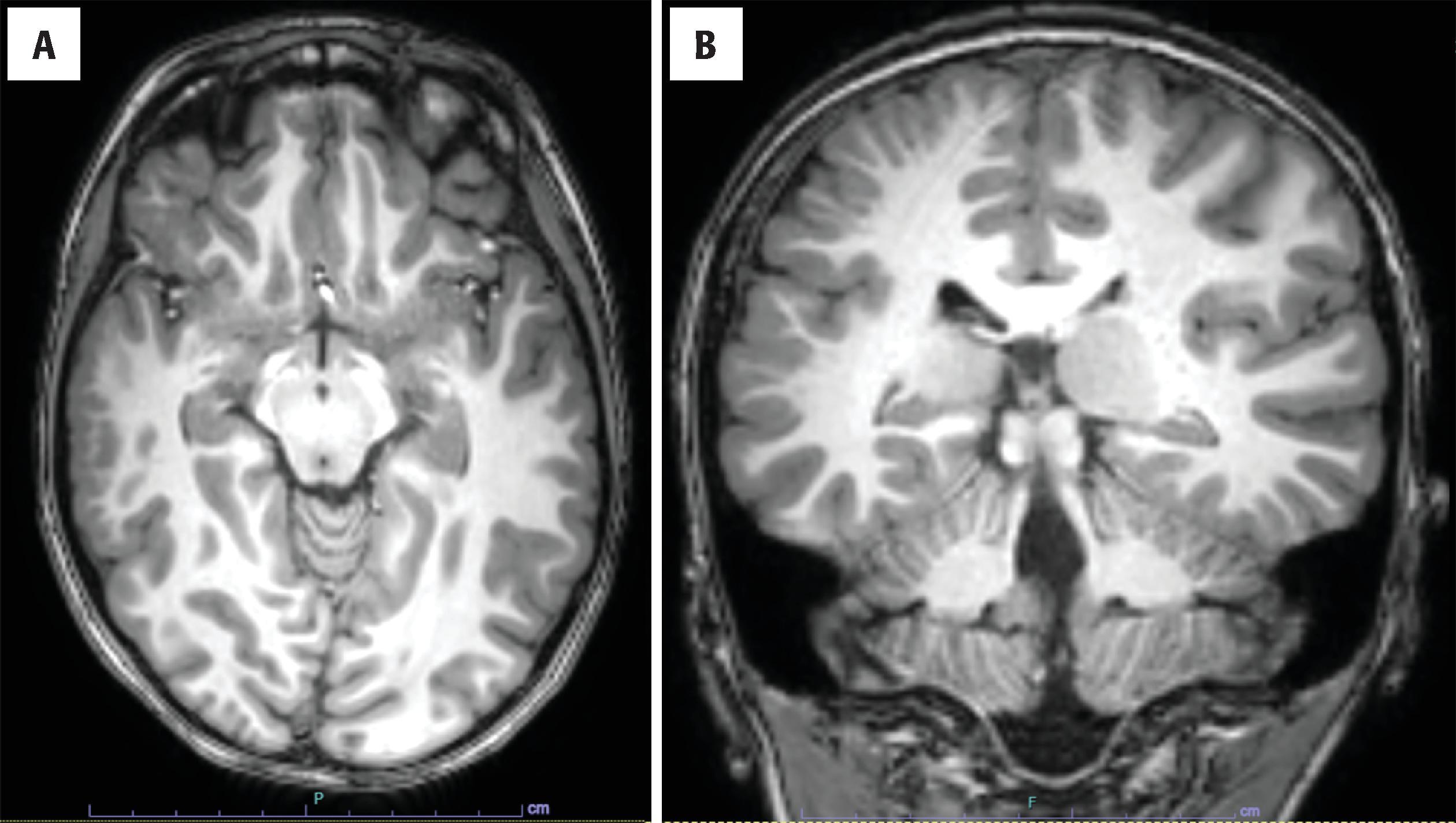
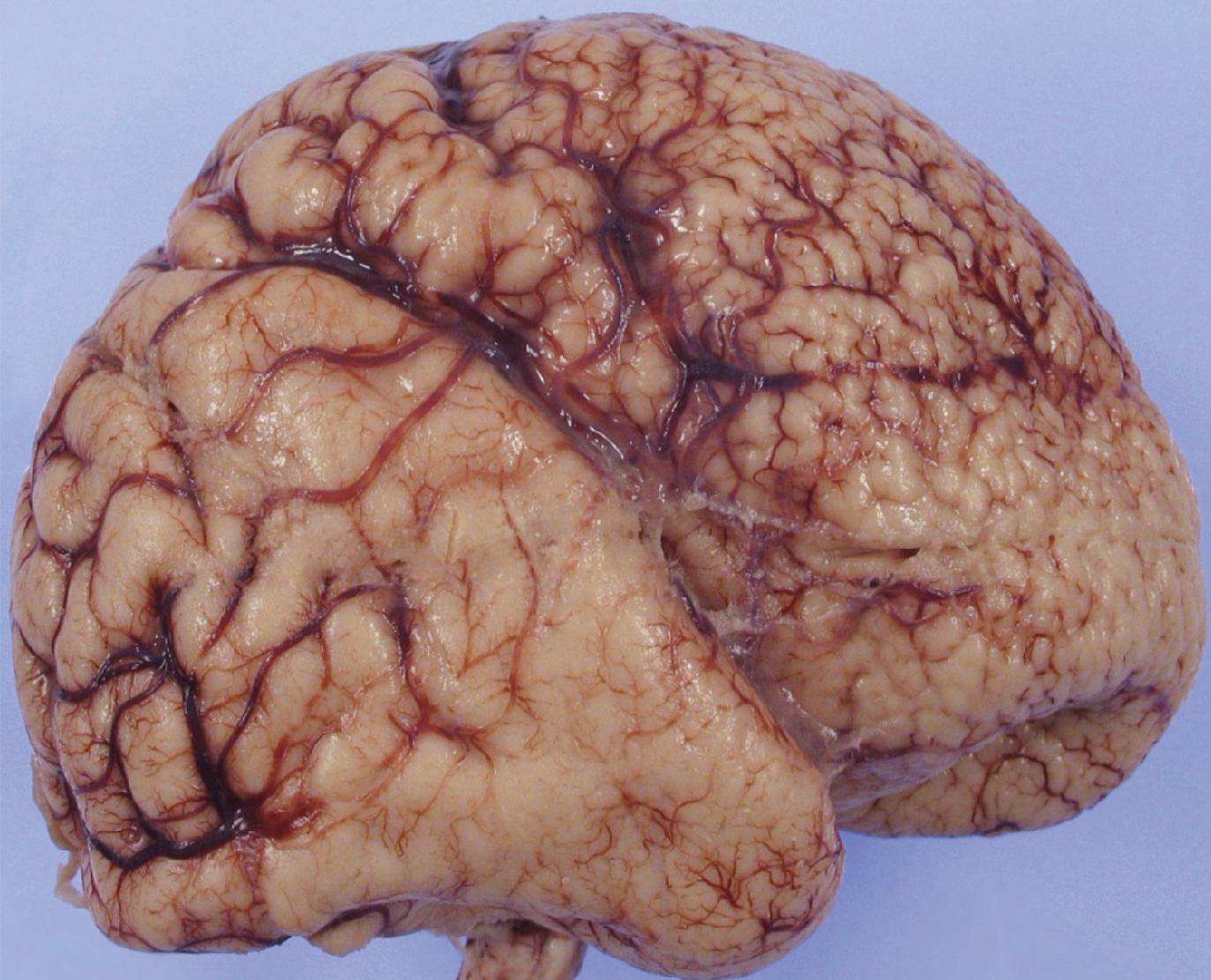
Histologic features include the presence of thinned cortical ribbon with small hyperconvoluted (excessively folded) gyri ( Figs. 4.37 to 4.39 ) with fusion of the molecular layers between adjacent cortical ribbons ( Fig. 4.40 ). Small- and medium-sized blood vessels can be seen, apparently trapped without the accompanying leptomeninges/pial layer through which these vessels usually pass (see Fig. 4.40 ). There is usually a sharp boundary between the normal and abnormal cortex. Two-layered cortex ‘‘unlayered polymicrogyria’’ is defined as having a molecular layer overlying a single disorganized and unlaminated cortex. Four-layer polymicrogyria is classically described as having a molecular layer, an upper dense cell layer, an intermediate layer of low cell density containing a few horizontal-oriented myelinated fibers in older individuals, and a deep cell layer bordering the white matter. The same resection specimen can show two-, four-, and six-layered cortices in different regions. Cytologically, the neurons appear unremarkable; dysplastic neurons or balloon cells are not seen. Unlike lissencephaly/pachygyria, the border between polymicrogyria and the adjacent normal cortex is quite distinct—layer VI in normal cortex and the deepest layer of the polymicrogyric cortex are continuous. On the basis of these pathologic features, the timing of occurrence of polymicrogyria is generally thought to be later in neocortical development, likely occurring between weeks 17 and 26 of gestation. Hypoxic-ischemic disruption of the intermediate layers of the cortex at this developmental interval could give rise to the observed changes.
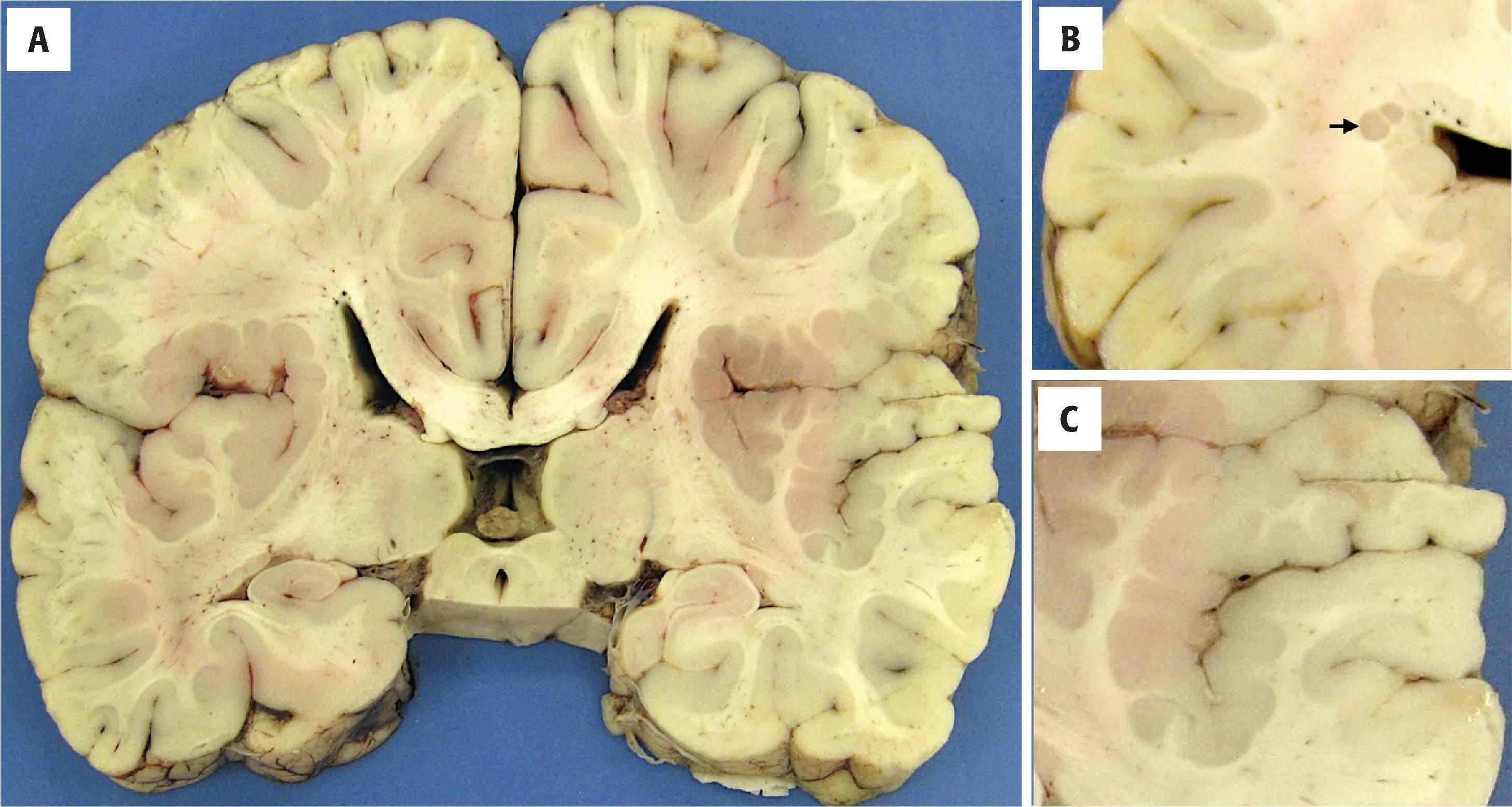
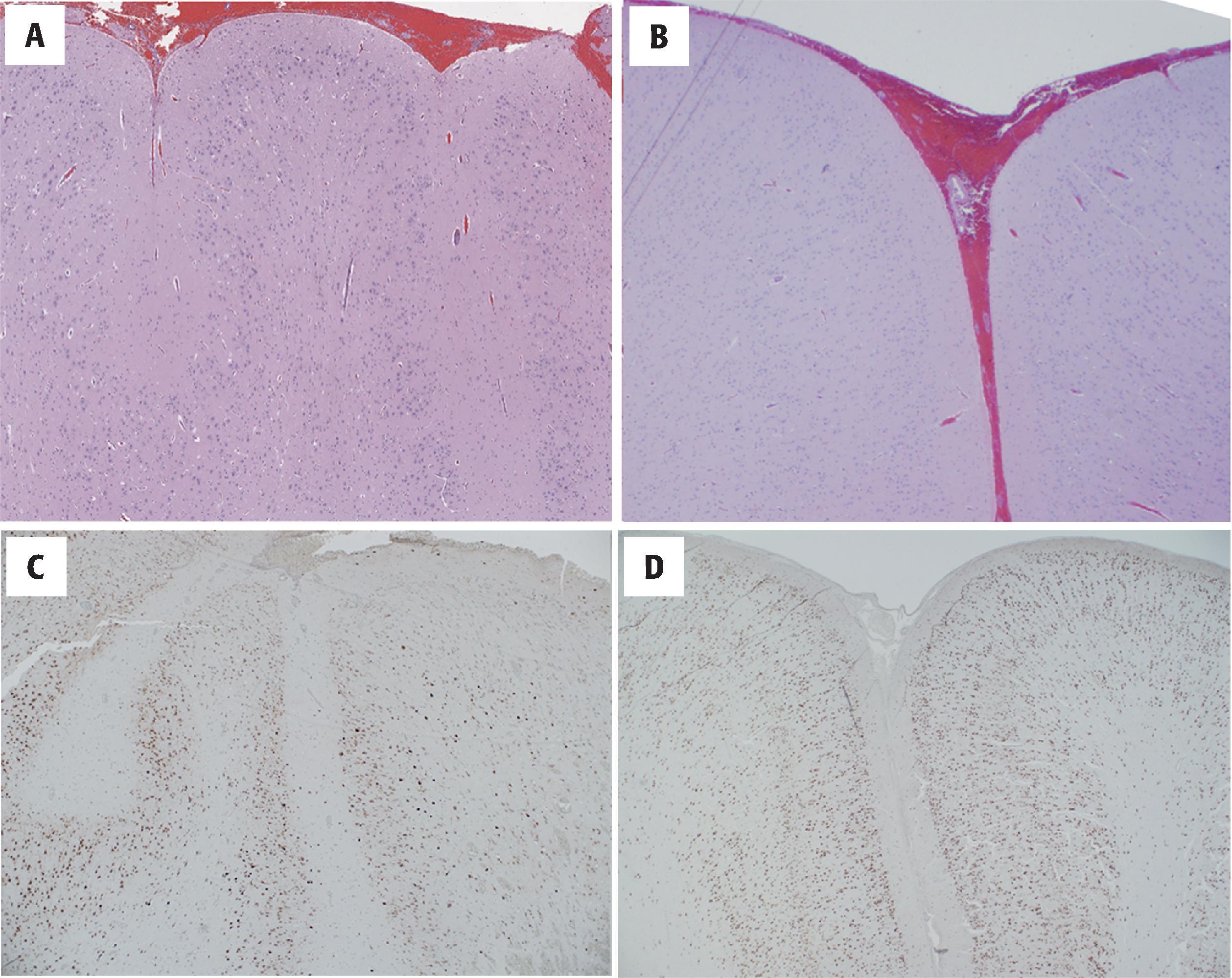
Familial cases of polymicrogyria have been reported. In addition, somatic mosaicism has also been identified in a subset of patients. To date, mutations in at least 20 genes have been associated with polymicrogyria. Several bilateral symmetric polymicrogyric syndromes have distinctive neuroimaging patterns. The presence of polymicrogyria in cases of destructive brain lesions such as schizencephaly suggest that at least some cases of polymicrogyria (and gray matter heterotopia) are attributable to disruptive effect of ischemia and not a primary defect of migration.
The so-called pseudopolymicrogyria or simply polygyria ( Fig. 4.41 ) may be seen in cases of severe congenital hydrocephalus. In this setting, the increased sulcation is believed to allow increased surface area for cortical neuronal organization, thereby somewhat overcoming the loss of sulcal depth in the thinned cerebral mantle. The numbers and organization of cortical layers are preserved, however.
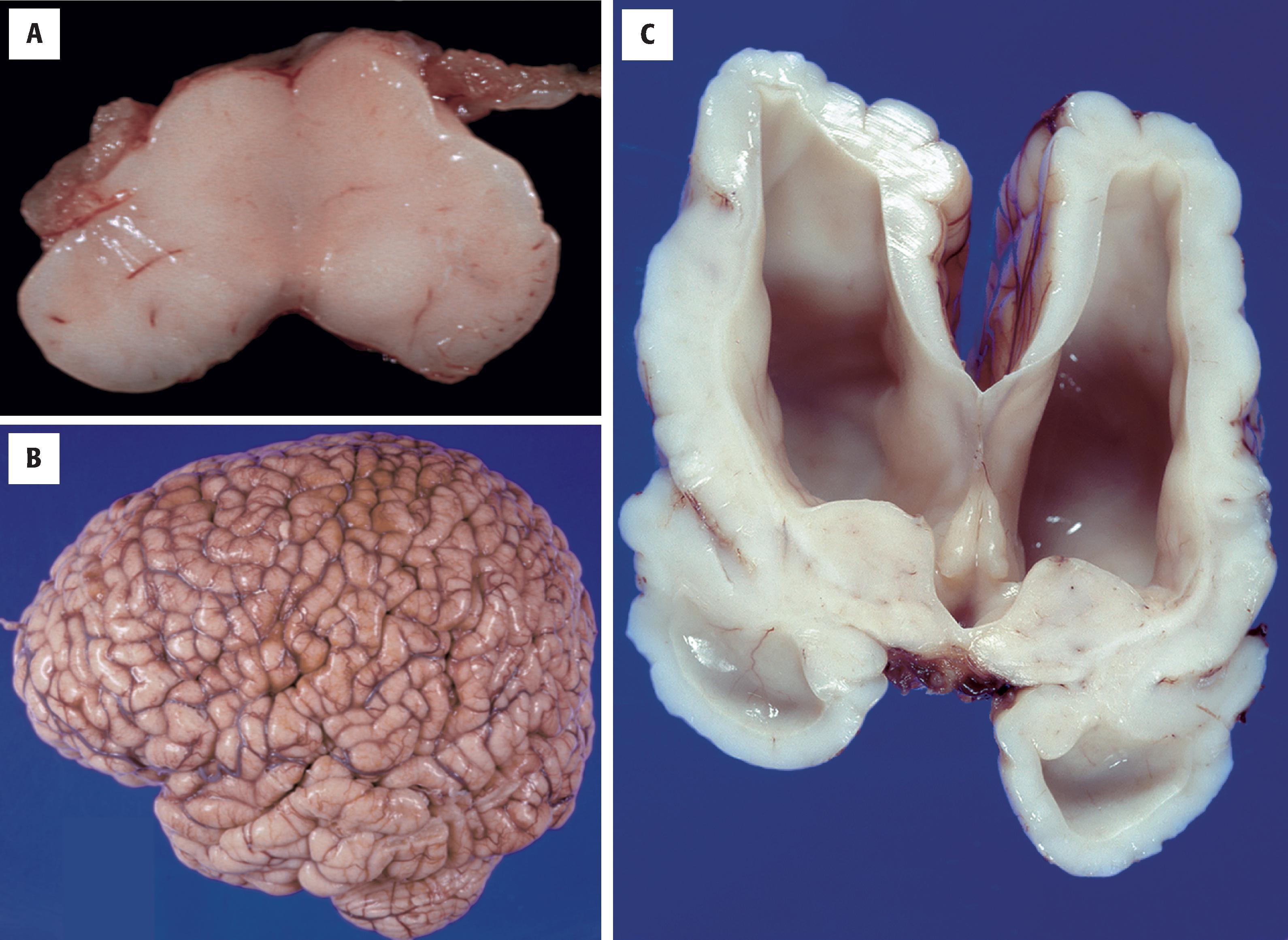
Focal cortical dysplasias (FCDs) are localized regions of malformed cerebral cortex that are a common cause of drug-resistant seizures. About 20 % of surgically resected epileptogenic foci shows FCD. FCDs encompass etiologically and histologically distinct entities showing variable histologic features including abnormalities in both cytologic and or architectural abnormalities. Various classification systems have existed over the years, the most popular being the one proposed by the International League Against Epilepsy (ILAE) in 2011. The initial clinical manifestation of cortical dysplasia is usually a seizure early in life. In infancy, the seizures can be focal or can start as infantile spasms. Later, the seizures may evolve to tonic seizures and drop attacks. Neonatal onset as early infantile epileptic encephalopathy has also been reported. Electroencephalographic findings are variable.
According to the ILAE schema, FCD type Ia is characterized by an exaggerated radial microcolumnar organization. A ‘‘microcolumn’’ is defined by more than eight neurons aligned in a vertical direction ( Fig. 4.42 ). NeuN-stained 4-μm sections may be helpful in recognizing more subtle cases of FCD. FCD type Ib shows loss of the six-layered isocortical architecture with abnormal tangential/horizontal lamination (see Fig. 4.42 ). Several different patterns are seen including a) complete loss of tangential lamination other than a distinct layer 1 and b) loss or alterations of specific layers, most commonly either layer 2 or 4 or both are affected, leading to loss of distinction of layer 2 from 1 or 3 and that of layer 4 from layers 3 and 5. There is usually blurring of gray white junction with neurons extending into the white matter. FCD type Ic is described as a combination of FCD Ia and FCD Ib patterns. Other minor accompanying pathologies (mild malformations of cortical development) including increased neurons in cortical layer 1 or in the white matter are also common.
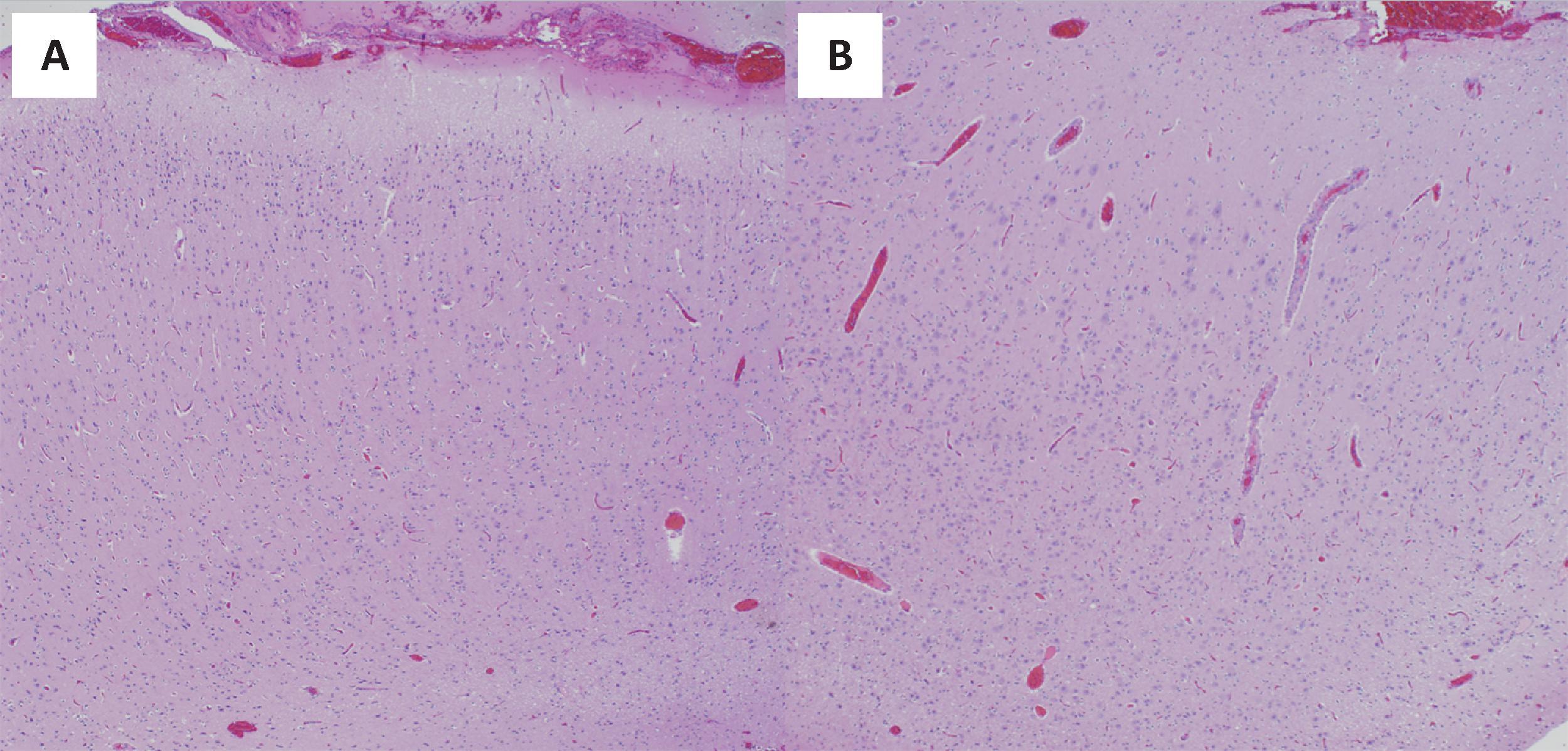
The hallmark of focal cortical dysplasia type II is the presence of cytologically abnormal cells ( Fig. 4.43 ), usually in addition to cortical lamination abnormalities. FCD type IIa is marked by the presence of dysmorphic neurons, which can show one or more abnormal features including abnormal shape, size, orientation, dendritic profile, cortical positioning, and abnormal distribution of Nissl substance. Balloon cells are the histologic hallmark of FCD type IIb; they are marked by abundant eosinophilic cytoplasm (see Fig. 4.43 ). Balloon cells are of mixed lineage and express both neuronal and glial proteins. Abnormal cells in FCD type II show mTOR pathway activation caused by somatic mutations, related to hemimegalencephaly and tuberous sclerosis lesions.
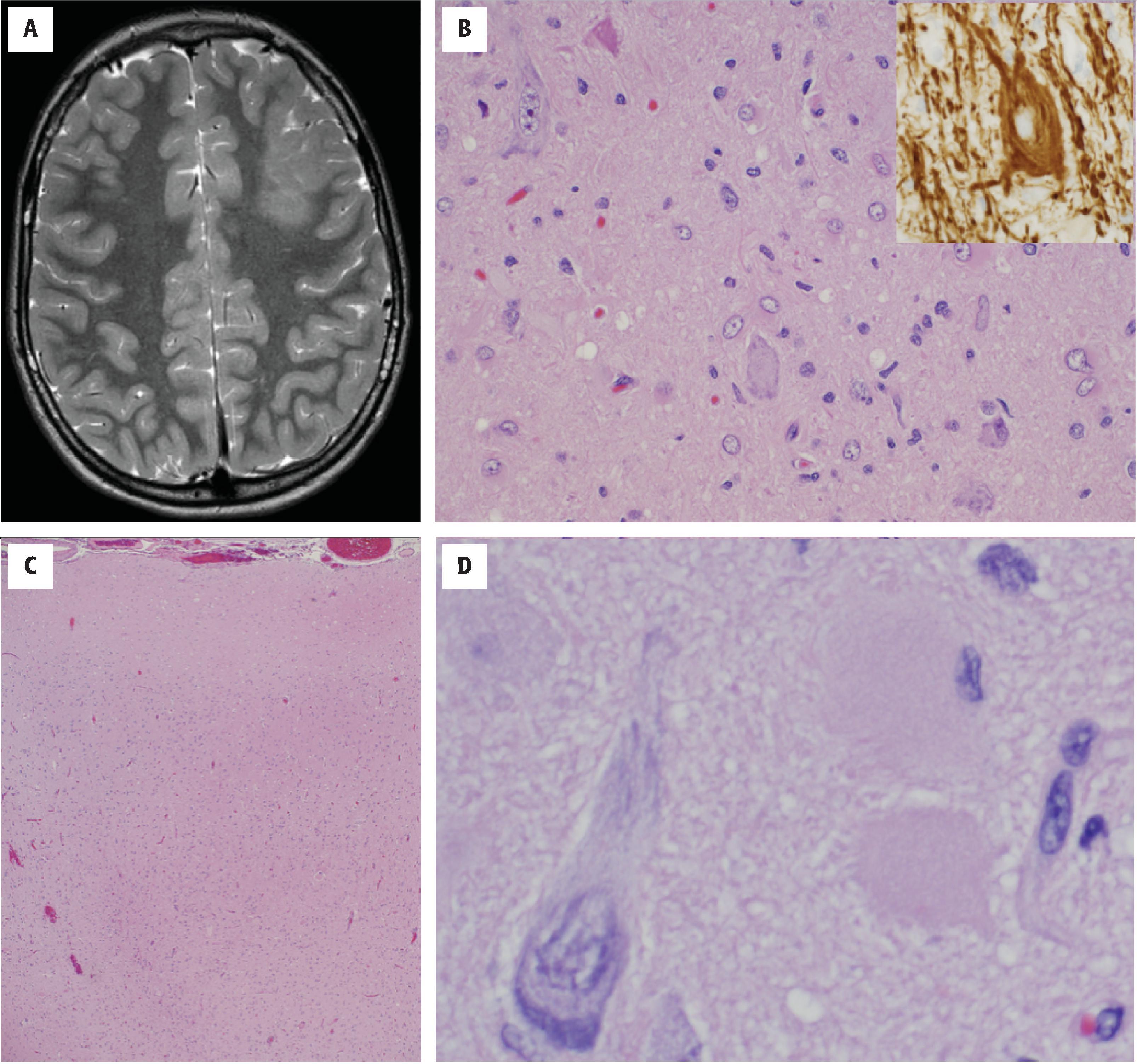
FCD type III is the presence of laminar abnormalities with a second primary lesion including hippocampal sclerosis (IIIa) ( Fig. 4.44 ), glial or glioneuronal tumor (IIIb), vascular malformation (IIIc) or perinatal insult including trauma, ischemic injury, hemorrhage, or infection (IIId).
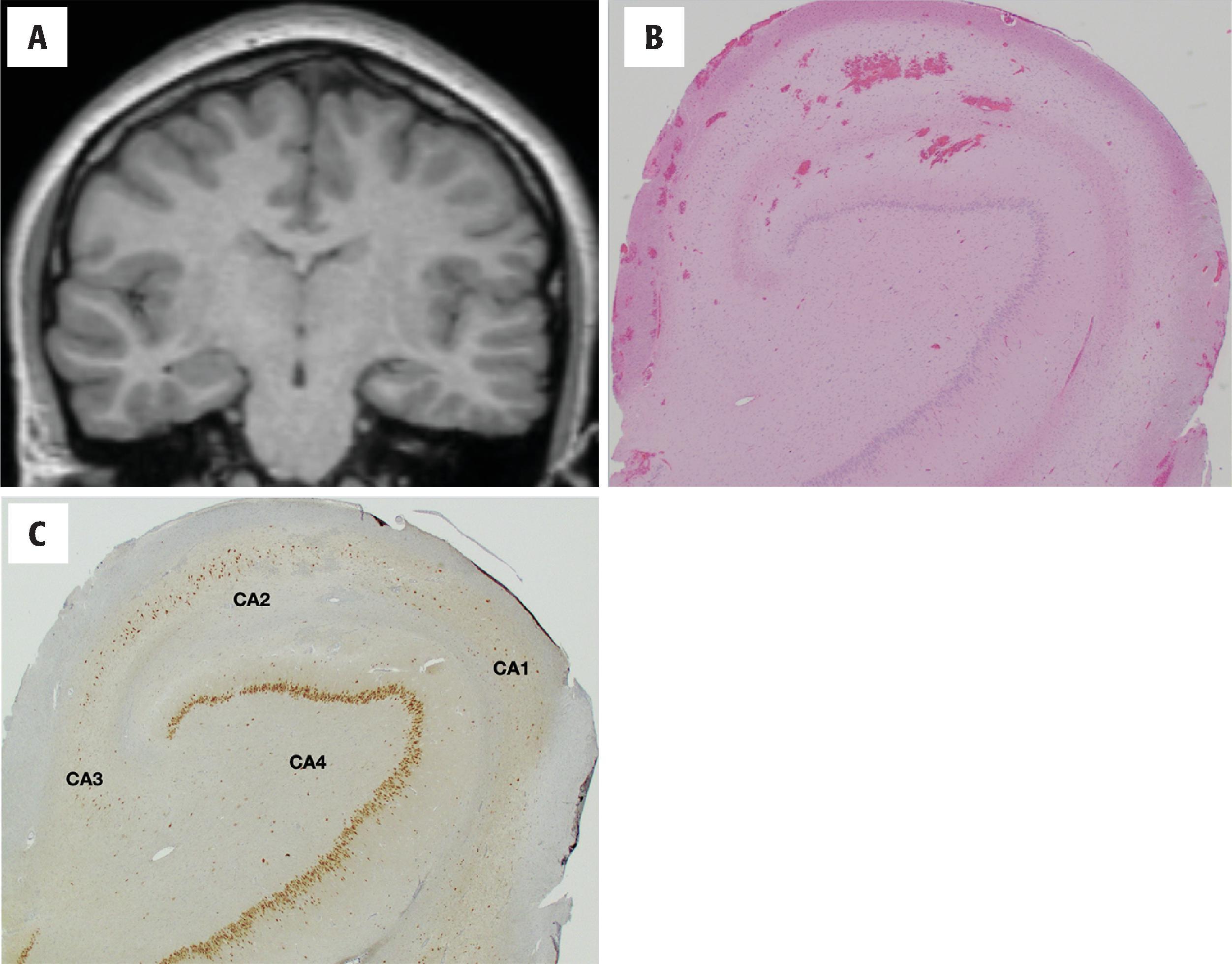
Surgical resection is the principal treatment for drug-resistant FCD with outcome related to FCD subtype with type II FCD showing better seizure outcomes post resection as compared with type I FCDs.
Localized regions of malformed cerebral cortex
Distinct clinicopathologic entities with variable radiologic, gross, and microscopic abnormalities
FCD type I features architectural abnormalities without marked cytologically abnormal cells (absence of dysplastic neurons or balloon cells)
FCD type II features cytologically abnormal cells (dysplastic neurons or balloon cells, usually with accompanying laminar abnormalities)
FCD type III cortical lamination abnormalities with associated lesions such as hippocampal sclerosis, adjacent to glial/glioneuronal tumor, vascular malformation or a perinatal insult trauma, ischemic injury, hemorrhage or infection (encephalitis)
Present in approximately 20% of surgically resected epileptogenic lesions
Major cause of treatment refractory epilepsy
Surgical resection is the principal treatment for drug-resistant FCD with outcome related to FCD subtype with type II FCD showing better seizure outcomes post resection as compared with type I FCDs
In FCD type I, the dyslamination and disrupted architecture do not significantly alter cellular density. Consequently, MRI may show no visible changes in the cortex. Blurring of the gray-white matter junction can be seen due to neuronal dispersion into the U-fiber layer. FCD type II shows more prominent imaging abnormalities including cortical thickness abnormalities, hyperintensities of the cortex and subcortical white matter, blurring of the gray or white matter, and sulcal hypoplasia. A characteristic finding in FCD II is the transmantle sign, which is more often seen in FCD type IIb (see Fig. 4.43 ).
Lissencephaly is a smooth-surfaced brain, with little to no cortical gyri; it may be partial or complete. Type I (classic type) is smoother, whereas type II has a fine “cobblestone” appearance
Lissencephaly subsumes the terms agyria and pachygyria. Pachygyria is characterized by abnormally broad gyri, usually occurring with areas of lissencephaly or polymicrogyria
Polymicrogyria is characterized by increased narrow gyri
Neuronal heterotopia are collections of neurons in abnormal places (i.e., along the pial surface, in white matter, or beneath the ependyma)
The exact incidence is not known
Some subtypes (e.g., Walker-Warburg syndrome) have a high incidence of intrauterine demise and neonatal lethality
For X-linked lissencephaly, affected patients are female (the defect is lethal in males with rare live cases due to somatic mosaicism)
Associated with genetic factors; maternal exposure to alcohol, retinoic acid, heavy metal, and x-irradiation; and intrauterine infection and bilateral carotid ischemia
Lissencephaly:
Manifested as neonatal hypotonia with later spasticity, seizures, and mental retardation
Miller-Dieker (type I) syndrome has characteristic facies (upturned nose, bitemporal hollowing, small chin, long upper lip, and low-set ears)
X-linked lissencephaly (also type I) is usually lethal in males, whereas females demonstrate subcortical band heterotopia (“double cortex”)
Type II includes Walker-Warburg syndrome, the Finnish muscle-eye-brain disease of Santavuori, and Fukuyama muscular dystrophy, all of which are associated with eye abnormalities, including coloboma, retinal dysplasia, or cataracts
Pachygyria is seen as a component of many different types of cortical malformation including Zellweger syndrome (peroxisome deficiency) and is not specific
Polymicrogyria can be a primary familial entity, or it is associated with areas of destruction (porencephaly) or ischemia (i.e., bilateral middle cerebral artery ischemia or perisylvian polymicrogyria) (see the later section on disruptions of developing gray matter)
Focal cortical dysplasia is manifested as seizures, usually in early childhood
In type I lissencephaly, a smooth cortical surface is visible on prenatal ultrasound in the third trimester and on CT or MRI
In type II lissencephaly, irregularity of cortical gray matter corresponds to a “cobblestone” appearance; hydrocephalus is also seen
Gyral widening (pachygyria, focal cortical dysplasia) or narrowing and complexity (polymicrogyria) are detectable on CT and MRI
Periventricular nodular or subcortical band heterotopias are visible as gray matter signals in the white matter
Type I lissencephalies show genotype phenotype correlation with stereotypical cortical involvement patterns: LIS1 affects the parietal and occipital cortex, DCX (anterior or frontal cortex) and TUBA1A (posterior regions of the brain)
Seizures may be severe and life-threatening in all neuronal migration disorders
Focal cortical dysplasia is amenable to surgical therapy for seizure control
Zellweger's syndrome also has an accumulation of plasmalogens and long chain fatty acids as a result of abnormal peroxisome function, with hepatorenal failure and death ensuing within 1 to 2 years
Eye involvement in type II lissencephaly can be a source of morbidity
Muscular weakness in Fukuyama muscular dystrophy can result in death in infancy via respiratory failure
Lissencephaly type I is characterized by complete or subtotal lack of gyri and sulci, except for the interhemispheric and Sylvian fissures, as well as marked widening of cortical thickness and blurring of the gray-white distinction on cut surface; it has 4:1 ratio of gray-to-white matter
X-linked lissencephaly has a “double cortex” appearance, with the broad band of subcortical heterotopic gray matter occupying the centrum ovale
Lissencephaly type II has a “cobblestone” appearance, with fine stippling of all or part of the surface of the cortex; on cut section it is of variable thickness, with a 1:1 ratio of gray-to-white matter and a nodular or scalloped gray-white junction
Pachygyria is widening of some or most gyri, usually parasagittally
Polymicrogyria is an increased number and there are complex tiny gyri over all or part of the brain; it is usually perisylvian or at the edges of porencephalic (encephaloclastic) cysts
Zellweger's syndrome has both pachygyria and polymicrogyria
Focal cortical dysplasia is a grossly visible localized expansion of gyrus, with blurring of the gray-white distinction on cut surface
Heterotopic gray matter appears as “crust” along the pial surface, as a band or nodule in deep white matter, or as subependymal nodules protruding into the ventricle
Lissencephaly type I and pachygyria are microscopically identical, with four layers in a vaguely “inside-out” organization when compared with normal neocortex
Type II has disorganized neurons, glia, vessels, and collagen in a crustlike layer over a discontinuous pial remnant and a deeper layer of disorganized neurons
Polymicrogyria has fused layer I with simplified neuronal laminar architecture, either an unorganized “two-layered” or a “four-layered” architecture can be seen
Focal cortical dysplasia shows abnormal neuronal laminar architecture (FCD type I), in addition to abnormal laminar architecture. Type II also shows abnormal cytoarchitecture with large, bizarre “dysplastic” neurons (FCD type IIa) or “balloon” cells (FCD type IIb). Type III shows additional lesions with FCD such as hippocampal sclerosis, vascular malformation, glioneuronal tumors, or perinatal ischemic insult
Heterotopia are collections of mature-appearing but displaced neurons seen as a band deep to the cortex (subcortical band heterotopia), along the pia/arachnoid (subarachnoid glioneuronal heterotopia), or as nodules in the deep white matter (periventricular nodular heterotopia)
Lissencephaly type I can be caused by mutations in microtubule structural (tubulin) or microtubule-associated proteins (MAPs), including ACTB, ACTG1, ARX, CDK5, CRADD, DCX, DYNC1H1, KIF2A, KIF5C, LIS1, NDE1, RELN, TUBA1A, TUBA8, TUBB, TUBB2B, TUBB3, TUBG1, and VLDLR. Miller-Dieker syndrome is associated with deletion of chromosome 17p13.3, which includes LIS1 and at least one other gene of relevance called YWHAE
Muscle-eye-brain disease is caused by loss-of-function mutations in the glycosyltransferase POMGNT1 gene; the gene map locus is 1p34-p33
Fukuyama congenital muscular dystrophy with type II lissencephaly is caused by a mutation in the Fukutin gene, which maps to chromosome 9
Walker-Warburg syndrome is caused by a mutation in the gene for protein O-mannosyltransferase (POMT1) at 9q34.1, 9q31
Some examples of bilateral perisylvian polymicrogyria appear to be X-linked and map to Xq28; a form associated with cerebellar ataxia maps to 16q12.2-21
Zellweger's syndrome is caused by genes involved in peroxisome biogenesis including peroxin (PEX1) (7q21), PEX2 (8q), PEX3 (6q), PEX5 (chromosome 12), and PEX6 (6p)
Focal cortical dysplasia type IIb has been associated with loss of heterozygosity/somatic mosaicism of the tuberous sclerosis (TSC) genes
Autosomal recessive periventricular heterotopia with microcephaly has been associated with a mutation in ARFGEF2, whereas the X-linked dominant form has been mapped to Xq28 and may be caused by a mutation in the filamin-A gene
Pachygyria and polymicrogyria are components of several entities and must be considered in light of other brain and systemic findings, as well as the clinical and family history
Focal cortical dysplasia is histologically similar to tuberous sclerosis but lacks the other multifocal CNS lesions and systemic findings
In type I lissencephaly, the normal gyral and sulcal pattern is effaced by a smooth agyric surface on imaging (see Fig. 4.34 ). Overall volume of cortical gray matter and white mater is reduced, and the cerebral cortex is markedly thickened. Cases with DCX mutation show a layer of white matter separating a thin cortical layer from a deeper swath of gray matter representing arrested neurons. A diffuse pattern of such gray matter duplication (“double cortex”) corresponds to the pathologic finding of subcortical band heterotopia (see Fig. 4.31 ). In so-called incomplete lissencephalies (with or without 17p mutations), pachygyric and agyric areas may coexist along with shallow, vertical Sylvian fissures. In X-linked lissencephaly, the posterior cerebral lobes are relatively spared, in contrast to the agyria and pachygyria anteriorly. Of course, care must be taken when reviewing prenatal MRI and ultrasonography because the cortex is normally free of convolutions until 18 to 20 gestational weeks.
In WWS and MEB disease (type II lissencephalies), hydrocephalus is seen frequently, as well as patchy white matter hyperintensity on T2-weighted MRI. The irregular, fine nodularity of the cortex at the gray-white junction corresponds to the cobblestone pattern seen on pathologic evaluation. In FCMD, MRI of the brain demonstrates areas of pachygyria and polymicrogyria, as well as regions of abnormal T2 signal in white matter. The white matter is hypodense on CT.
Periventricular nodular heterotopia appears as irregular nodules of gray matter signal intensity along the ventricular surfaces (see Figs. 4.28 , 4.29 ).
As mentioned earlier, the Miller-Dieker phenotype is distinguished from isolated lissencephaly sequence by the lack of distinctive facial features in the latter, although bitemporal hollowing and a small chin may be seen in some patients with isolated lissencephaly sequence. The distinction between these two entities is not entirely straightforward, inasmuch as microdeletions detected by fluorescent in situ hybridization have been seen in a significant number of patients with isolated lissencephaly sequence, thus suggesting a relationship to Miller-Dieker syndrome.
The differential diagnosis of the lissencephaly type II syndromes is complex, as reflected in the many essentially synonymous designations of these entities, including the MEB, HARD ± E (hydrocephalus, agyria, retinal dysplasia, with or without encephalocele), and CODM (congenital ocular dysplasia/muscular dystrophy) syndromes, which share phenotypic features. FCMD, despite many similar features, does not usually include the severe eye and brain anomalies found in WWS. If clinically important, distinction among these entities can be assisted by genetic studies.
Cortical anomalies recapitulating the syndromic features of lissencephaly, pachygyria, and polymicrogyria can be seen as components of several other entities. Specifically, Zellweger syndrome, a disorder of peroxisomal biogenesis characterized by neonatal hypotonia, facial dysmorphism, open fontanelles, and renal and hepatic abnormalities, has both lissencephalic/pachygyric and polymicrogyric cortical changes ( Fig. 4.45 ). The related peroxisomal disorders, neonatal adrenoleukodystrophy, rhizomelic chondrodysplasia punctata, and bifunctional enzyme deficiency may show migrational abnormalities. The metabolic abnormalities, glutaric aciduria type II, pyruvate dehydrogenase deficiency, nonketotic hyperglycemia, and sulfite oxidase deficiency/molybdenum cofactor deficiency, are examples of other metabolic disorders that occasionally demonstrate cortical dysplasia. Assays for long chain fatty acids are diagnostic of the peroxisomal disorders; complementation studies, although not widely available, may be confirmatory and allow precise biochemical characterization.
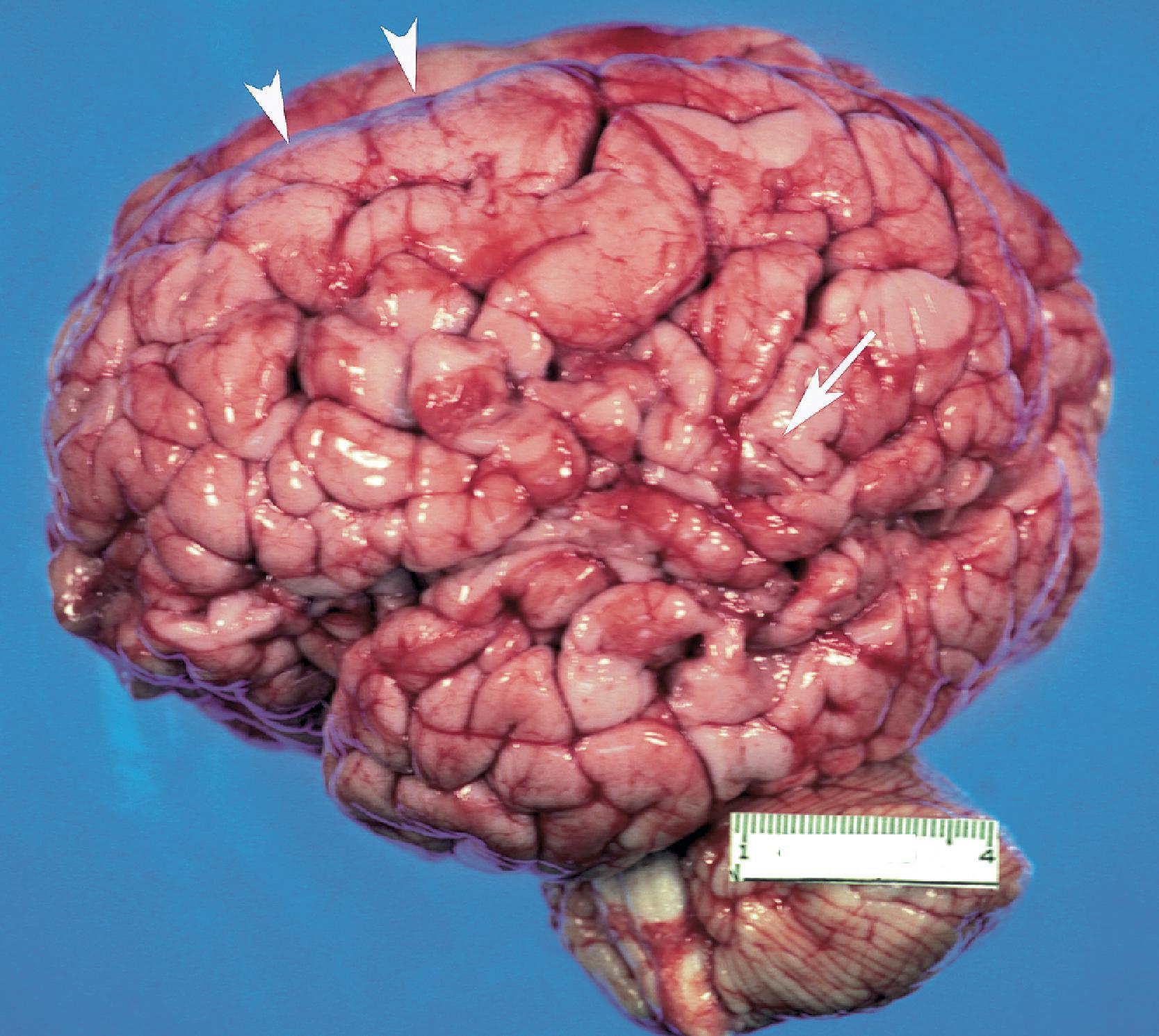
Polymicrogyria may also occur in various settings, including lissencephaly type II conditions and the Aicardi, Neu Laxova, and Smith-Lemli-Opitz syndromes (see the earlier section on holoprosencephaly sequence), thus reflecting the nonspecific nature of the malformation. In addition, polymicrogyria can occur in a variety of chromosomal abnormalities and in disruptions (see the corresponding sections). Likewise, neuronal heterotopia and focal cortical dysplasia may accompany many of these same syndromes.
Both periventricular and subcortical band heterotopia can occur as X-linked inherited conditions, although they map to different regions on the X chromosome. In familial band heterotopia, affected females are found to have heterotopia and often seizures, whereas affected males show more severe brain malformations, including lissencephaly. This sex difference is thought to result from random X chromosome inactivation in females, in which full expression of the defect is prevented and a spectrum of developmental disturbances from focal heterotopia to lissencephaly can occur.
Feeding problems, respiratory infections, and status epilepticus are thought to contribute to the high mortality rate of approximately 50 % up to the age of 10 years in LIS1-associated lissencephaly.
As mentioned earlier, eye involvement (myopia, infantile glaucoma, retinal and optic nerve hypoplasia, coloboma, and cataracts) is commonly seen, along with mental retardation and seizures in patients with lissencephaly type II. In FCMD, like other congenital dystrophies, the onset of marked diffuse weakness and hypotonia, facial weakness, and joint contractures is noted in the neonatal period, with mortality approaching 50 % in infancy. In WWS and MEB disease, mortality is also quite high in the first months of life. There are no specific therapies for any of the neuronal migration defects, although surgery to remove the localized malformation may be effective for seizure control in cases of focal cortical dysplasia.
Hindbrain malformations account for a significant proportion of all CNS anomalies. The use of second-trimester ultrasonography for dating and monitoring of asymptomatic pregnancies has led to prenatal detection of posterior fossa abnormalities, primarily Dandy-Walker malformations, and an increased incidence of these findings among abortuses.
Hans Chiari, an Austrian pathologist, devised a classification scheme for posterior fossa anomalies. According to this scheme, type I is chronic cerebellar tonsillar herniation associated with hydrocephalus and various brainstem signs, sometimes causing referral to the surgeon for decompression of the foramen magnum. Type II (also known as the Arnold-Chiari malformation) is displacement of the cerebellar vermis below the level of the foramen magnum and is almost universally associated with an open neural tube defect, usually lumbosacral myelomeningocele (discussed earlier in the section on neural tube defects). Type III is quite rare and refers to a posterior cervico-occipital encephalocele, and type IV is a deficiency of the vermis, better known as Dandy-Walker syndrome. In general, current neuropathologic usage refers only to types I and II.
A more workable categorization recognizes five groups:
Aplasias
Hypoplasias, including Dandy-Walker malformation, Joubert syndrome, and rhombencephalosynapsis
Disorganizations, including migration defects
Displacements, including Chiari I, II, & III malformations
Destructive/degenerative lesions
In this section, only the hypoplasias, disorganizations, and displacements are discussed. In addition, aqueductal malformations are discussed for the sake of completeness.
Complete or subtotal absence of cerebellar hemispheres (aplasia) is rare. Although the term aplasia has been used to describe the entity, an intrauterine destructive process may be involved. Cerebellar hypoplasia refers to a small and often underdeveloped cerebellum. It is perhaps the most common and most nonspecific cerebellar malformation given that it is observed in many different disorders and is often a feature of genomic imbalances. Cerebellar hypoplasia can be associated with prenatal factors including extreme prematurity. Cerebellar hypoplasia can be associated with extreme prematurity and twin growth discordance (which is likely due to twin-twin transfusion syndrome). Association with these prenatal factors suggests that asymmetric cerebellar hypoplasia and other associated conditions including cerebellar clefts and cerebral heterotopia—especially posterior predominant PNH—may have a nongenetic basis.
An entity known as rhombencephalosynapsis demonstrates vermian aplasia with fusion of the dentate nuclei across the midline of the cerebellum ( Fig. 4.46 ). There is frequent association with supratentorial commissural defects.
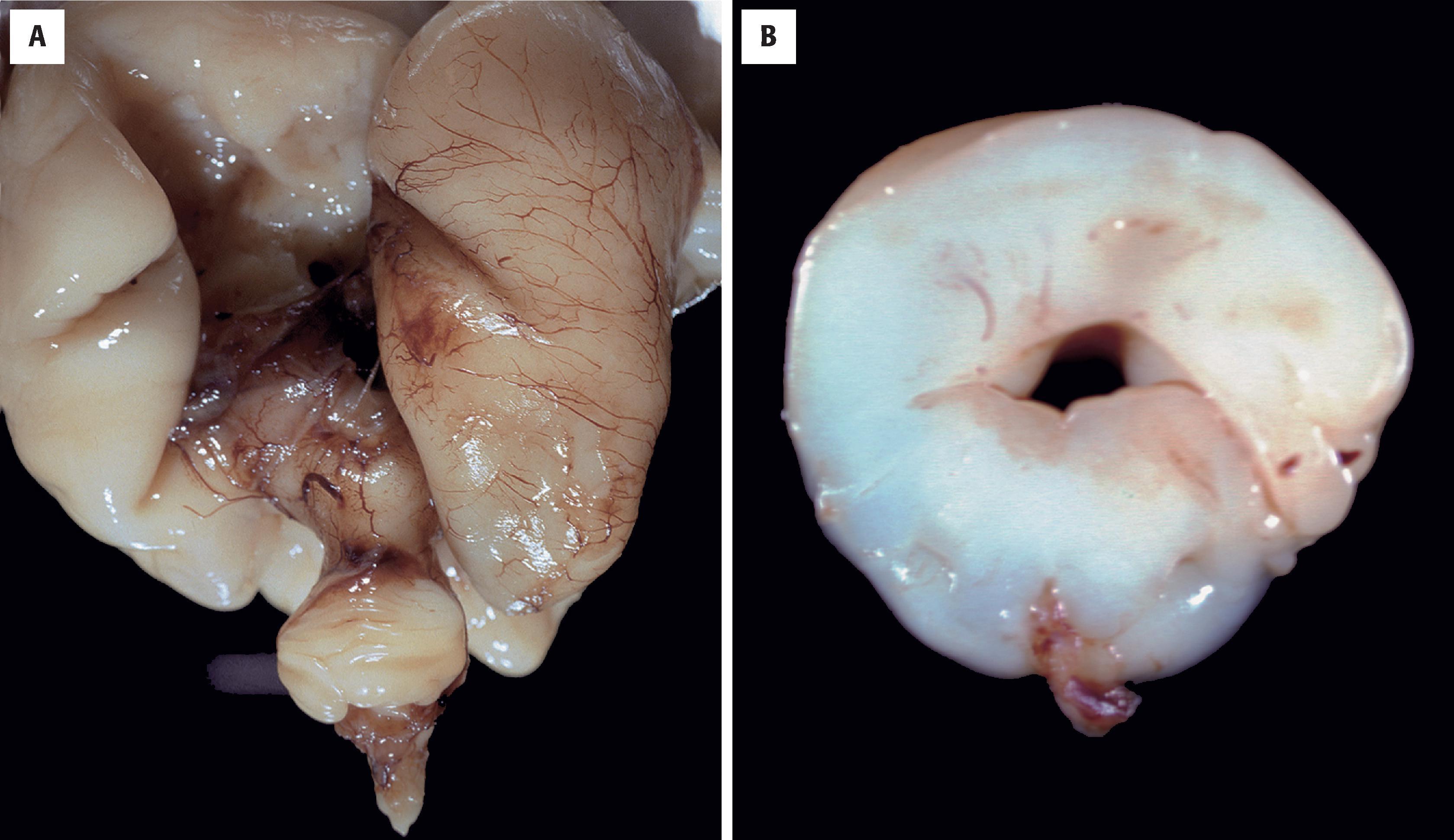
Minor migrational defects, such as microscopic cerebellar cortical heterotopia (see Fig. 4.33 ), are extremely common and thought to be of no clinical consequence. Disorganized collections of mature neurons, glial cells, or immature neuroepithelial cells can be seen in various combinations.
Macroscopic disorganization of the cerebellar cortex includes cerebellar polymicrogyria ( Fig. 4.47 ) and Lhermitte-Duclos disease (dysplastic gangliocytoma of the cerebellum) ( Figs. 4.48 and 4.49 ). Cerebellar polymicrogyria (see Fig. 4.47 ) probably originates in the manner of cerebral cortical polymicrogyrias, either genetically determined or secondary to an insult at the critical point of cell migration leading to disturbed architecture.
In Lhermitte-Duclos disease, one cerebellar hemisphere is hypertrophic, with thickened folia (see Fig. 4.48 ), containing large displaced dysplastic neurons, some with features of Purkinje cells (see Fig. 4.49 ). Affected patients have signs of increased intracranial pressure. Half of the patients with Lhermitte-Duclos disease have Cowden disease, an autosomal dominant condition (see the later section on familial malformations/tumor syndromes).
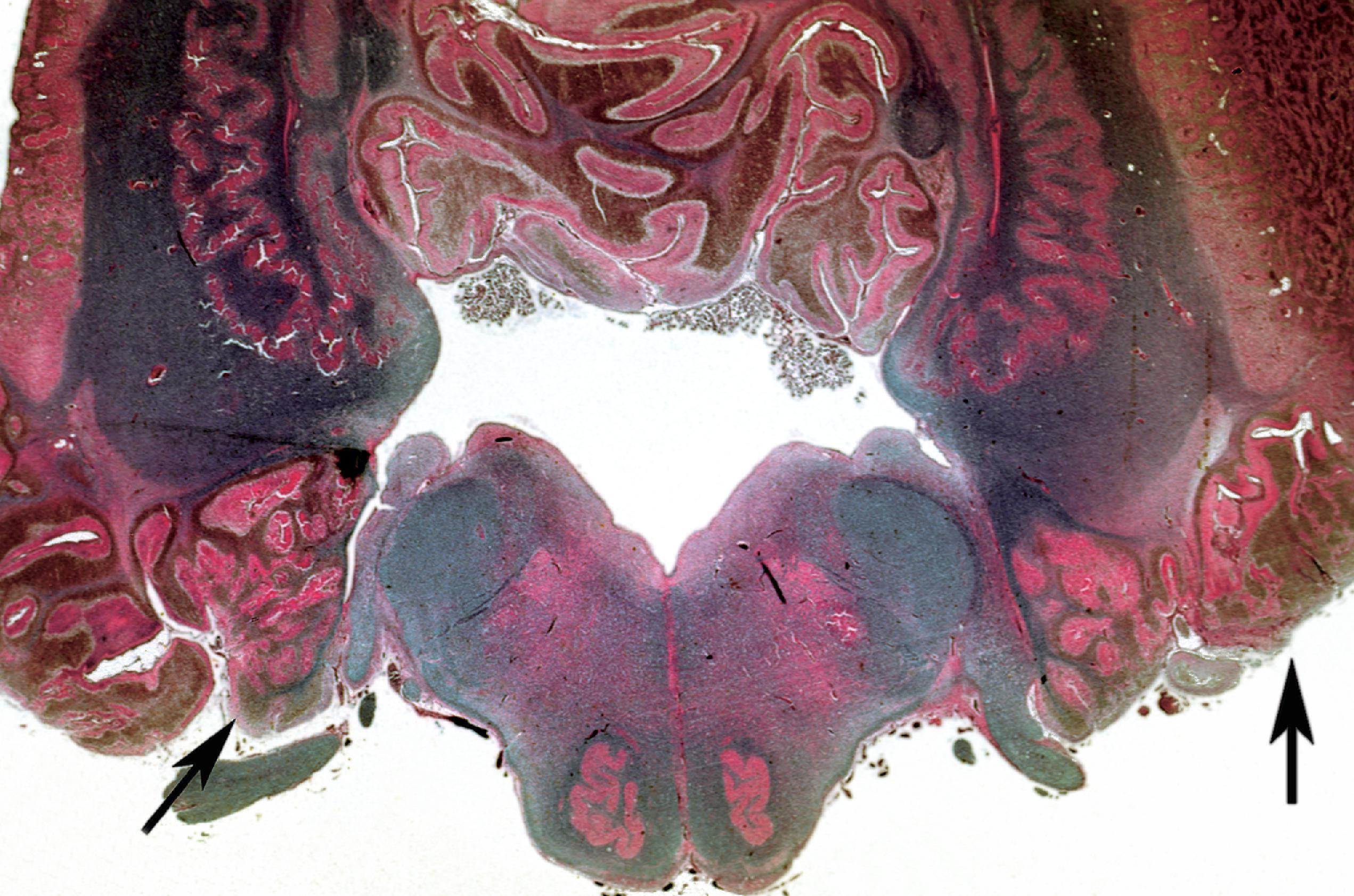
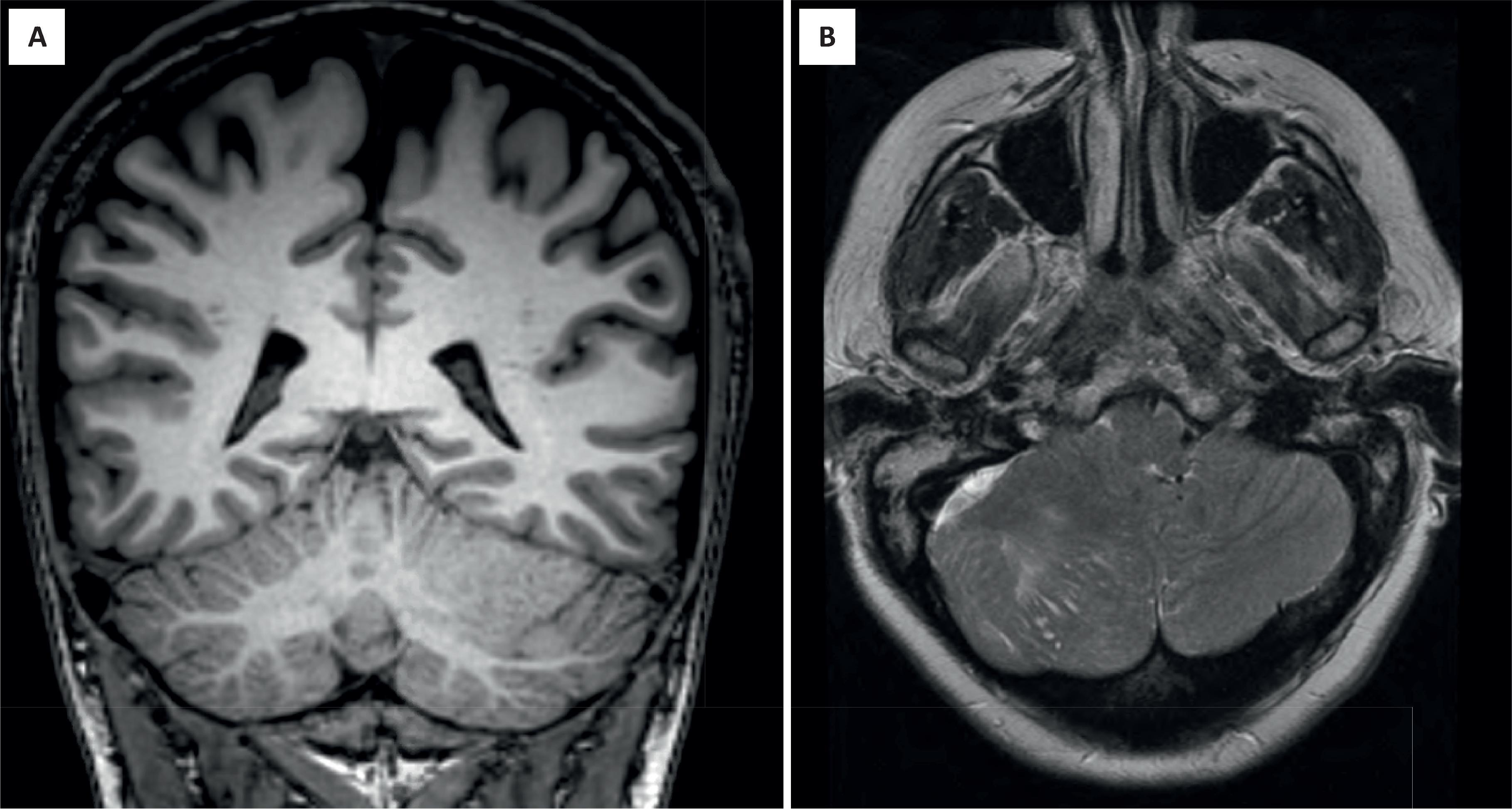
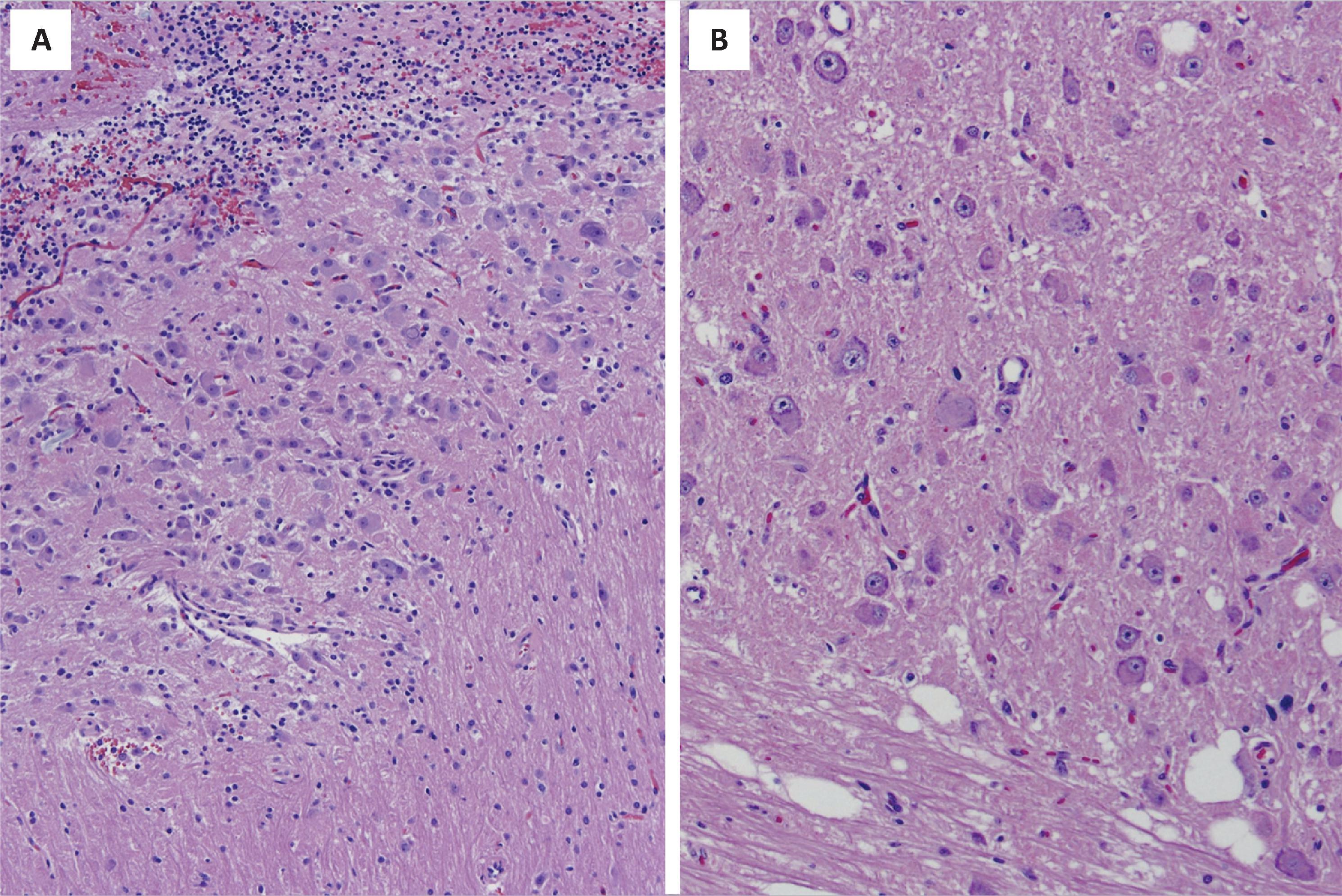
Disruptions include subpial cerebellar cortical hemorrhages, infarcts, and infections. Hematomas of the tentorium may occur in utero or at the time of delivery and usually resolve spontaneously, although occasionally, they may compress and injure adjacent cerebellum.
Hypoplasias and displacements represent the bulk of the posterior fossa abnormalities seen. These are discussed as follows.
Displacements of cerebellar tissue include Chiari I and Chiari II (also called Arnold-Chiari syndrome) malformations. Chiari I malformation is characterized by the isolated presence of low-lying cerebellar tonsils ( Fig. 4.50 ). These come to medical attention much more frequently with the availability of noninvasive neuroimaging techniques. Chiari type I malformations may occasionally be symptomatic and sometimes are treated with surgical procedures to decompress the posterior fossa or foramen magnum. Chiari I malformations (see Fig. 4.50 ) usually present in teens or young adults with the most common symptom being neck pain. Cerebellar or brainstem signs may be prominent in some cases. Forty to seventy-five percent of cases of Chiari type I have an associated syringomyelia. Increased incidence of Chiari 1 malformation is seen in association with neurofibromatosis type 1 (NF1).
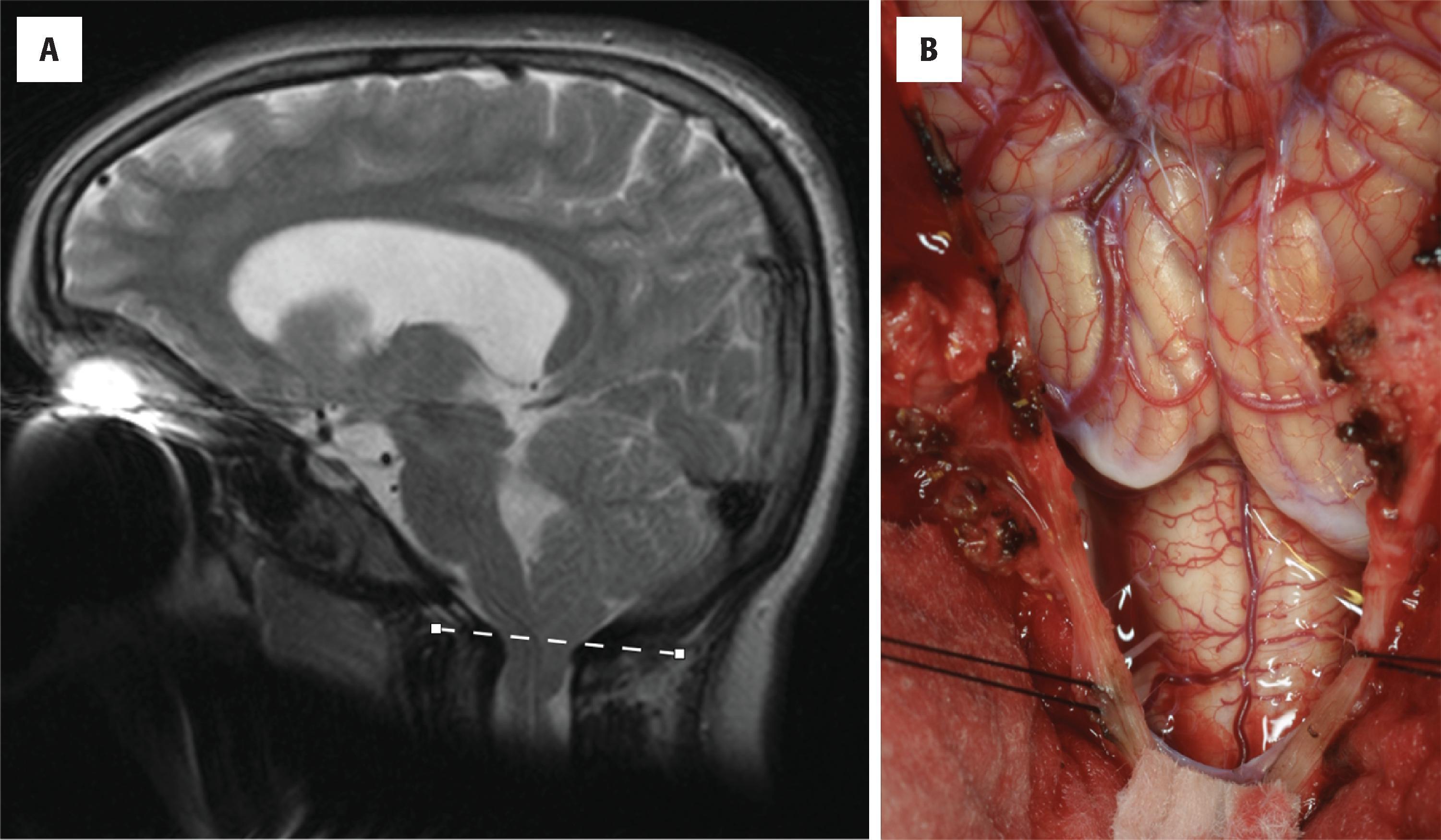
In Chiari II, the cerebellar vermis is displaced caudally into the upper cervical spinal canal (see Fig. 4.9 ). The herniated vermis lies dorsally over the spinal cord. The fourth ventricle, pons, and medulla are also elongated and partially located within the spinal canal. The posterior fossa is always small. Obstruction of the CSF may give rise to hydrocephalus. Brainstem abnormalities are also common and may include fusion (beaking) of the inferior tectum ( Fig. 4.51 ) and kinking of the medulla (see Fig. 4.9 ). A variety of different supratentorial abnormalities may be present including dysgenesis of the corpus callosum, absence of septum pellucidum, cerebral periventricular heterotopia, polymicrogyria, or pachygyria. Spinal cord abnormalities include hydromyelia and syringomyelia. And as mentioned earlier, Chiari II is nearly always associated with lumbosacral meningomyelocele (see Fig. 4.51 ). Chiari II is often identified antenatally because of the distal neural tube defect (see Fig. 4.10 ). Clinically, a Chiari II malformation may be manifested as lower brainstem and cranial nerve dysfunction. Dysphagia leading to feeding difficulties, drooling, nasal regurgitation, stridor, vocal cord paralysis, and life-threatening apneic spells can occur. Cyanotic episodes are ominous and carry considerable mortality. Nystagmus, retrocollis, and opisthotonos can be seen. Later occurrence of the Chiari II malformation may, in addition, include loss of head control, new weakness in the arms, and increasing spasticity leading to quadriparesis.
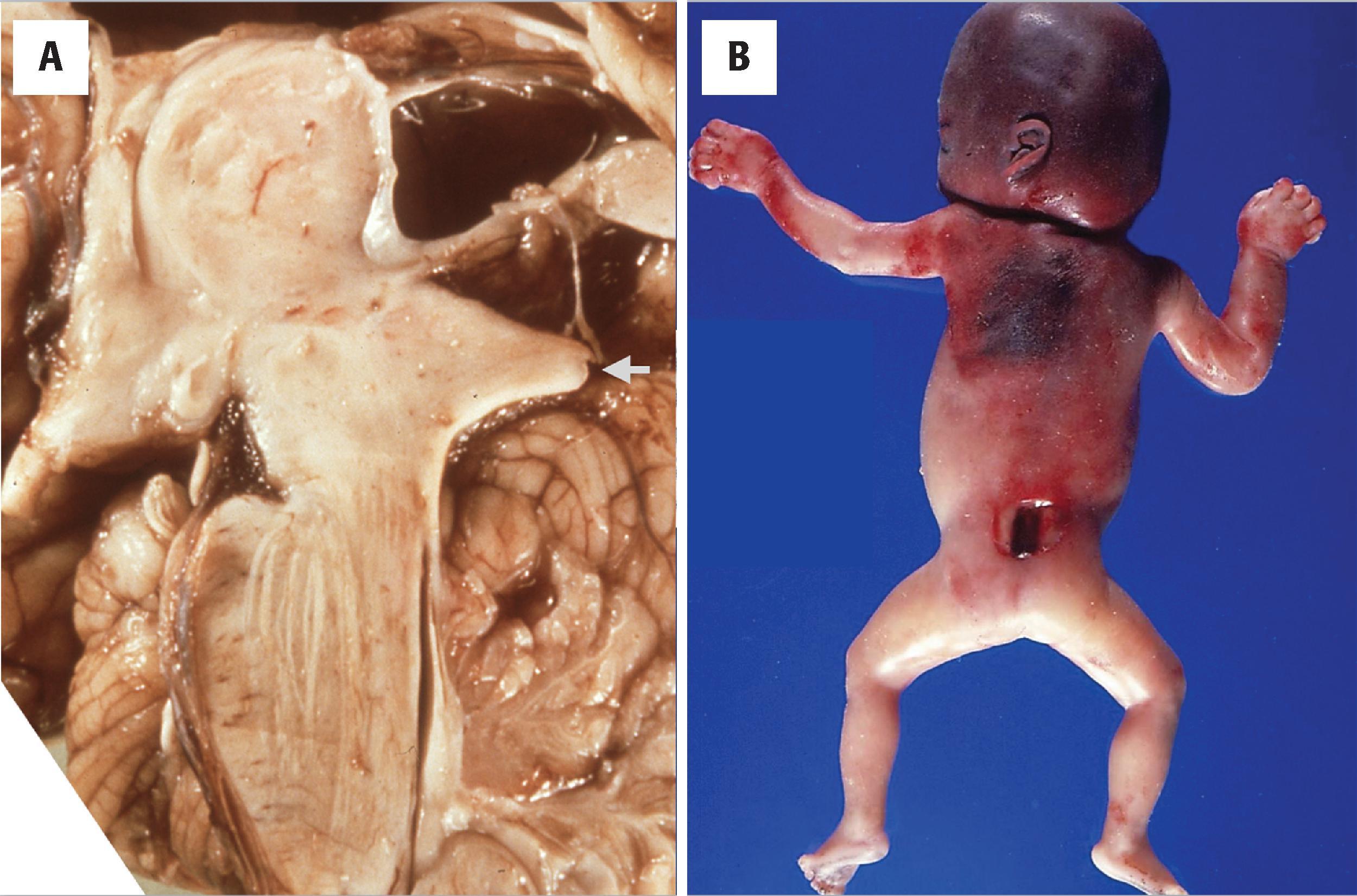
Chiari II malformation is likely a consequence of the distal spinal dysraphism (usually lumbosacral myelomeningocele). This idea is supported by study of mutant mice, which have recessively inherited neural tube defects with leakage of CSF leading to transient fourth ventricular collapse. The failure of distention of the ventricular system then results in underdevelopment of the posterior fossa mesenchymal structures.
The best-known example of cerebellar hypoplasia is the Dandy-Walker malformation (DWM), or the occurrence of partial or complete ( Figs. 4.52 and 4.53 ) agenesis of the vermis with cystic dilatation of the fourth ventricle.
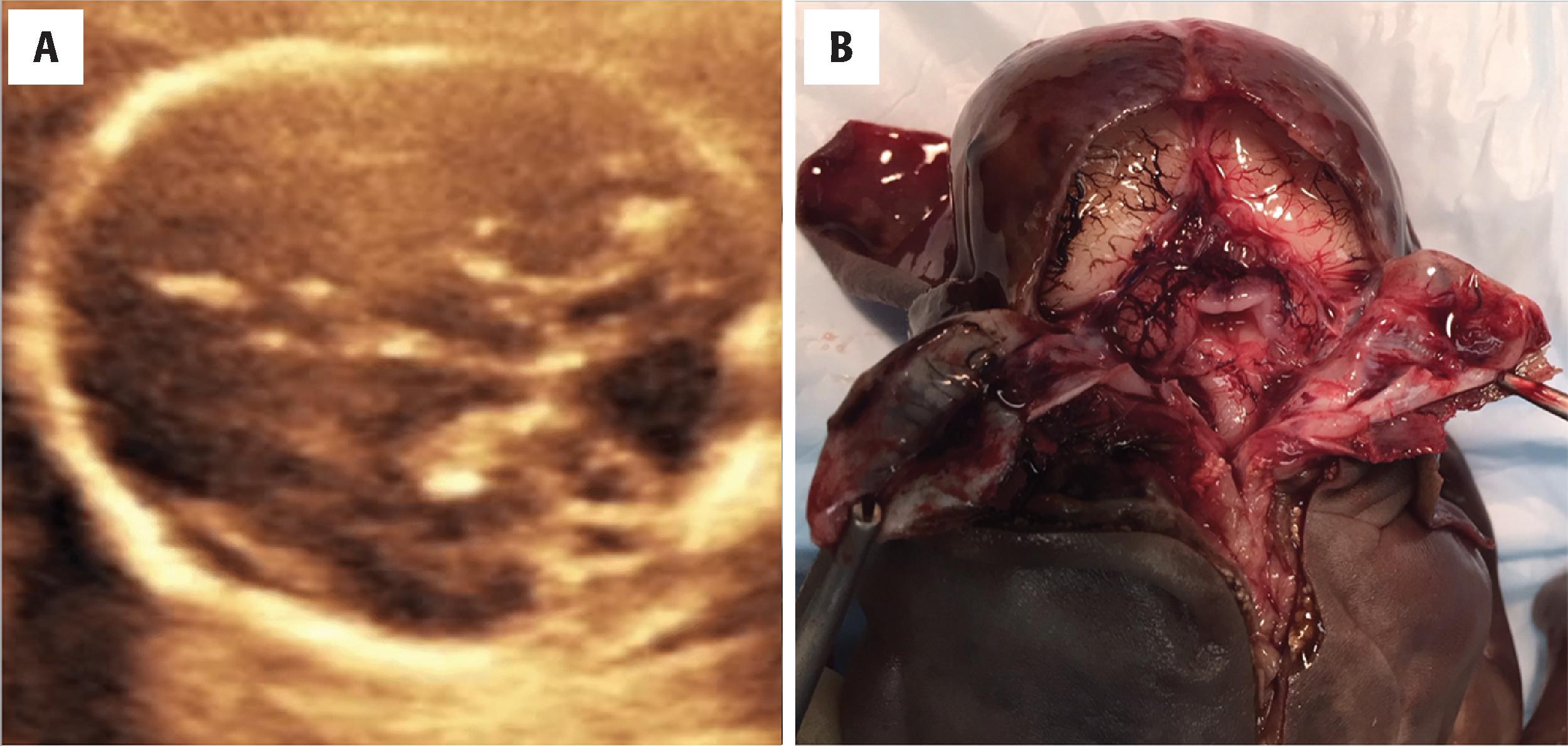
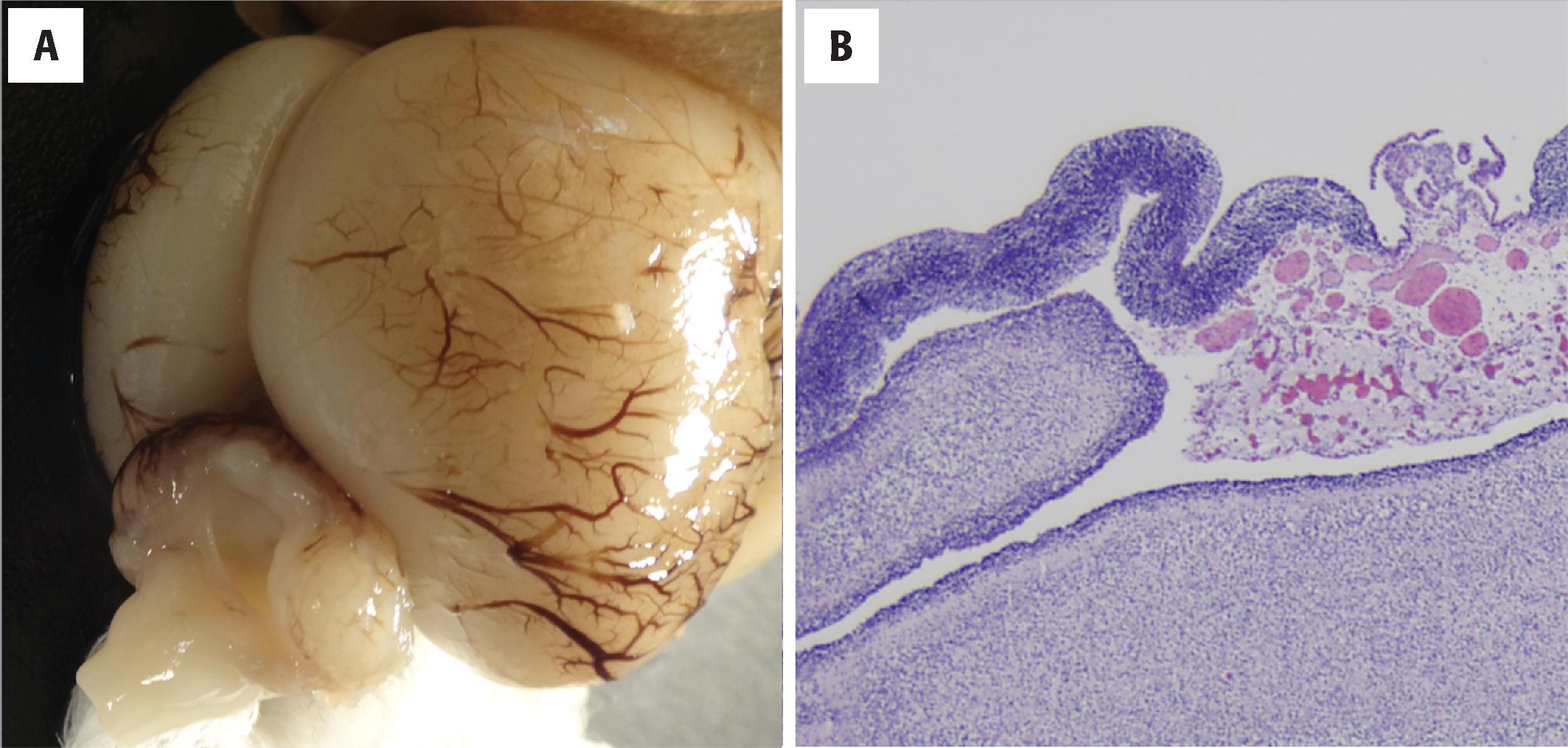
Classic DWM includes a triad of findings including (1) complete agenesis or hypoplasia of the vermis, (2) cystic dilation of the posterior fossa communicating with the fourth ventricle, and (3) enlarged and bowl-shaped posterior fossa with an abnormally high tentorium cerebelli (see Fig. 4.52 ). The magnitude of cerebellar hypoplasia is variable in cases of DWM with about 25 % of cases manifesting a complete absence of the vermis and the remainder being partial. The vermis is also rotated upward, and the hemisphere splayed outward. The cyst can vary in size and is composed of an inner, often atrophic ependymal layer apposed to a disorganized neuronal and glial layer representing hypoplastic cerebellar tissue and finally a pia/arachnoid layer forming the outermost layer (see Fig. 4.53 ). Disorganized cerebellar cortical tissue may be present at the edge. The cyst space is continuous with the fourth ventricle, which is dilated. In the absence of continuity between the cyst and the fourth ventricle, a diagnosis of arachnoid cyst should be considered. Associated cerebral malformations have included cerebral gyral abnormalities, heterotopias, agenesis of the corpus callosum, aqueductal forking or stenosis, and occipital encephalocele. Somatic malformations include cardiac malformations and polydactyly.
Mega-cisterna magna (MCM) and Blake pouch cyst (BPC) exist on a spectrum of abnormalities with DWM. MCM refers to enlarged cisterna magna, the retrocerebellar subarachnoid space between the pia and arachnoid. While both DWM and MCM share a fourth ventricular cyst, it involutes in MCM but persists in DWM. Unlike DWM, cerebellar hypoplasia is not present in MCM. BPC consists of an intact fourth ventricular cyst that may expand the posterior fossa and cause hydrocephalus. Unlike DWM, significant vermian dysgenesis is not present. Thus BPC occupies an intermediate position between DWM on one hand with cerebellar hypoplasia and an enlarged posterior fossa on one side and MCM, in which there is no cerebellar atrophy and the fourth ventricular cyst has involuted, on the other. Cyst walls in BPC exhibit similar histology as DWM, without elements of cerebellar cortex, while in MCM, the fourth ventricular cyst degenerates, leaving behind the fourth ventricle lined by ependyma and the subarachnoid space lined by arachnoid.
Clinically, patients with DWM show cerebellar nystagmus and gait disturbance as would be expected from cerebellar vermian dysfunction. Progressive symptoms of hydrocephalus usually require shunting. In addition, mental retardation/intellectual disability is seen in 25 % to 50 %. The main clinical significance of DWM malformation is its high frequency (around 70 %) of concurrence with other cerebral and visceral anomalies, such as congenital heart disease and renal abnormalities, which tend to determine the individual prognosis. Occasionally, DWM may be incidentally detected in patients presenting all through life with either unrelated issues (trauma) or a variety of nonspecific symptoms such as headache, enlarged head size, or prominent suboccipital protuberance.
Another differential is the sporadically occurring retrocerebellar cyst ( Fig. 4.54 ), which can indent the inferior aspect of the cerebellar hemispheres and vermis and mimic vermian hypoplasia. A midsagittal section through the cyst and underlying cerebellum, however, should readily distinguish the two because with a retrocerebellar cyst, the vermis is distorted rather than frankly absent.
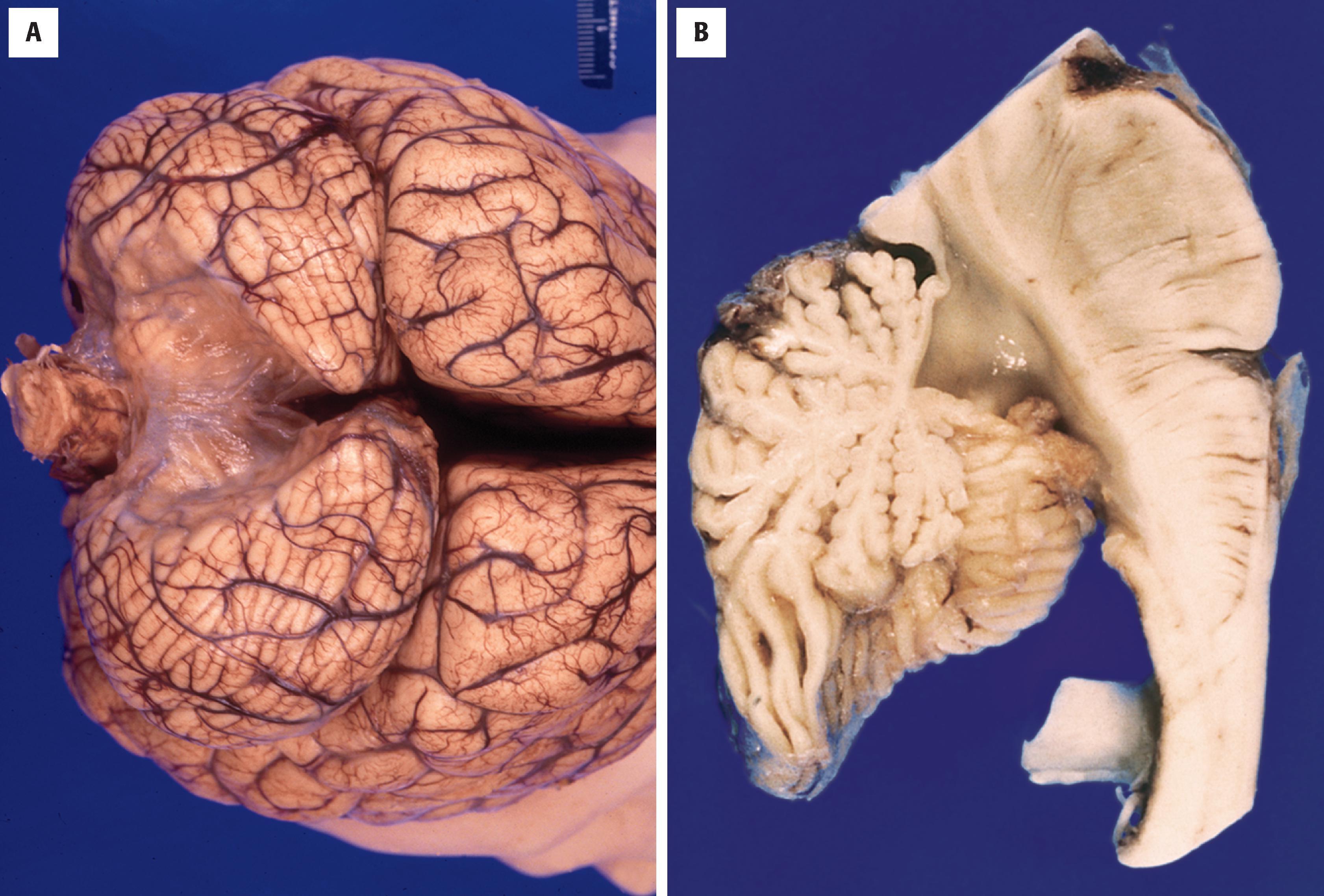
Another well-described, although rare, cerebellar hypoplasia is Joubert syndrome, in which the cerebellar vermian lobules are small or absent and accompanied by heterotopia of cerebellar cortical cells and marked hypoplasia of the superior cerebellar peduncles. There is distinctive elongation of the cerebellar peduncles, in addition to cerebellar vermis hypoplasia. Clinical features include hypotonia, ataxia, and intellectual disability. MRI shows a characteristic “molar tooth sign.” Abnormalities of brainstem nuclei are variable features and may include abnormal corticospinal tracts among others. At autopsy, transverse sections of the brainstem show almost complete hypoplasia of the cerebellar vermis. The fourth ventricle exhibits a “bat-wing” or “inverted umbrella” appearance. To date, more than 30 genes have been shown to be causative for this recessive syndrome. Most of these genes are associated with formation of primary cilia and basal body organelles, which are cellular structures involved in multiple signaling pathways including sonic hedgehog, WNT, and platelet-derived growth factor (PDGF).
DWM is an etiologically heterogeneous condition associated with a variety of chromosomal abnormalities, single-gene disorders, inflammation, hemorrhage, and various teratogens. Initial investigations attributed the expanded fourth ventricle to atresia of the foramina of Luschka and Magendie with secondary accumulation of CSF because of outflow obstruction. Demonstration of DWM cases with foraminal patency and absence of hydrocephalus has, however, called that theory into question. A third to half of the patients with DWM show abnormal karyotypes including trisomy 9, 13, 18, and 21; triploidy; and del(6p). Whole-examination sequencing has been used recently and can identify the likely pathogenic gene in up to 50 % of cerebellar hypoplasia and 15 % of DWM cases. Genes with well-established links to DWM include ZIC1, ZIC4, and FOXC1 among a growing list. It has been proposed that the common etiologic link may be defective vasculogenesis, which may disrupt cerebellar development due to hemorrhage or altered perfusion and subsequently lead to cerebellar hypoplasia or DWM.
Become a Clinical Tree membership for Full access and enjoy Unlimited articles
If you are a member. Log in here